Woori Technology AVR745 AV RECEIVER User Manual AVR 745 OM
Woori Technology Inc AV RECEIVER AVR 745 OM
USERS MANUAL
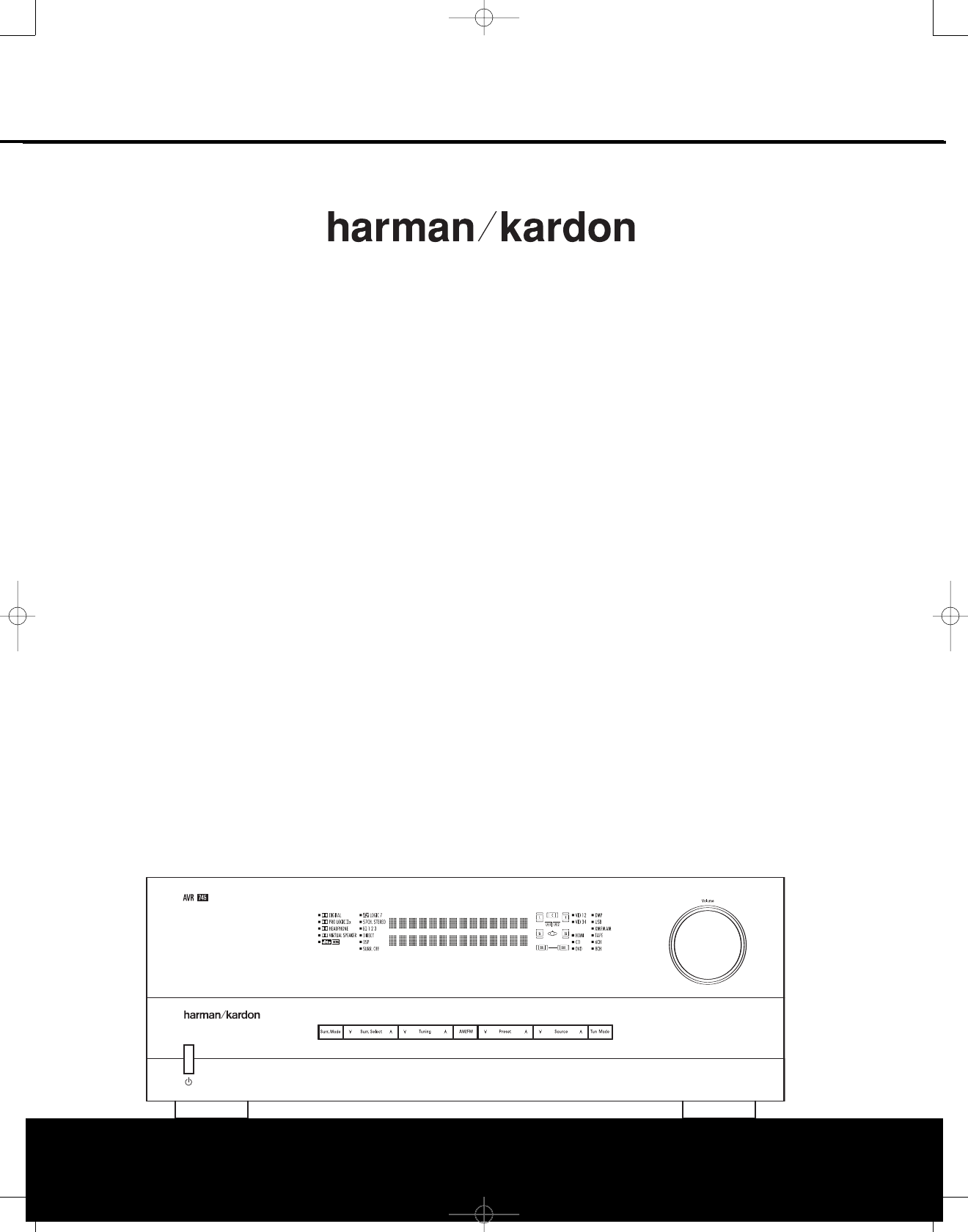
AVR 745
AUDIO/VIDEO RECEIVER
OWNER’S MANUAL
Power for the Digital Revolution
.
®
®
AVR 745 OM 5/15/06 5:00 PM Page 1

AVR 745 AUDIO/VIDEO RECEIVER
3Introduction
4Important Safety Information
4Unpacking
5Front-Panel Controls
8Rear-Panel Controls
11 TC 30 Remote Control Functions
13 ZR 10 Remote Control Functions
15 Installation and Connections
19System Configuration
19Speaker Placement
20 System Setup
22 In/Out Setup
24 Video Monitor Settings
24Video Setup
27 Audio Setup
27 Surround Setup
29 Using EzSet/EQII
33 Manual Setup
33 Speaker Size and Crossover
35 Delay Settings
37 Output Level Adjustment
39 Operation
39 Basic Operation
39 Source Selection
40 Volume and Tone Control
40 Surround Mode Selection
41 Surround Mode Chart
42 Digital Audio Playback
43 USB Playback
45 Using The Bridge
45 Video Adjustments and Operation
45 AM/FM Tuner Operation
46 XM Radio Operation
47 Recording
47 Front-Panel Connections
48 Output Level Trim Adjustment
48 EzSet/EQ II Operation
48 Dim Function
49 Advanced Features
49 Front-Panel Display Fade
49 Display Brightness
49 Turn-On Volume
49 Semi-OSD Settings
50 Full-OSD Time-Out Adjustment
50 DMP/The Bridge Auto Power
50 HDMI Video Auto Function
51 Multiroom Operation
51 Multiroom Setup
51 Surround Channel Amplifier Assignment
52 Multiroom Operation
54 Troubleshooting Guide
54 Processor Reset
55 Appendix
58 Technical Specifications
58 Trademark Acknowledgements
2 TABLE OF CONTENTS
Typographical Conventions
In order to help you use this manual with the remote control, front-panel controls and rear-panel connections,
certain conventions have been used.
EXAMPLE – (bold type) indicates a specific remote control or front-panel button, or rear-panel
connection jack
EXAMPLE – (OCR type) indicates a message that is visible on screen, or on the front-panel
information display or the TC 30 LCD screen
1– (number in a square) indicates a specific front-panel control
A– (letter in a square) indicates a front-panel control that is normally concealed behind the drop-down door
¡– (number in a circle) indicates a rear-panel connection
a– (number in an oval) indicates a button or indicator on the TC 30 remote
å
– (letter in an oval) indicates a button on the ZR 10 remote
Important Notes about the instructions in this manual:
• The appearance of the text and cursor in your receiver’s on-screen menus may vary slightly from the
illustrations in this manual. Whether the text appears in all uppercase or upper- and lowercase characters,
performance and operation remain the same.
• The instructions shown for using the TC 30 remote are correct as of the date this manual was printed. They may
change slightly from time to time when the TC 30’s internal software is upgraded to add new features.
For Canadian model
Modèle pour les Canadien
Cet appareil numérique de la classe B est conforme
à la norme NMB-003 du Canada.
Sur les modèles dont la fiche est polarisee:
ATTENTION: Pour éviter les chocs électriques, introduire
la lame la plus large de la fiche dans la borne
correspondante de la prise et pousser jusqu’au fond.
This class B digital apparatus complies with Canadian
ICES-003.
For models having a power cord with a polarized plug:
CAUTION: To prevent electric shock, match wide blade
of plug to wide slot, fully insert.
Please register your product on our Web site at www.harmankardon.com. Note: You’ll need the serial
number of your new AVR. At the same time, you can choose to be notified about our new products
and/or special promotions.
AVR 745 OM 5/15/06 5:00 PM Page 2

INTRODUCTION
Thank you for choosing Harman Kardon!
! With the
purchase of a Harman Kardon®AVR 745, you are
about to begin many years of listening enjoyment.
The AVR 745 has the most extensive range of audio
and video processing, control and connectivity options
ever offered by Harman Kardon, enabling it to provide
the best possible audio and video reproduction with
any type of source material. Teaming advanced pro-
cessing circuitry with proprietary technologies such as
EzSet/EQ II, the AVR 745 seamlessly integrates every
component in your entertainment system to deliver the
best possible sound and images.
Some of the leading-edge features that are available
with the AVR 745, such as HDMI™connectivity,
XM-Ready®operation, DCDi by Faroudja®video
processing with upscaling to 1080i, and the TC 30
activity-based remote, are new to even the most expe-
rienced home theater enthusiast. Although the power
of the AVR 745 makes them easy to use, we strongly
recommend that you take a few minutes to read this
owner’s manual to familiarize yourself with how the full
suite of AVR 745 features and capabilities are config-
ured and used in day-to-day operation. This small
investment of time will yield significant dividends in
taking the maximum advantage of this new addition
to your home theater system.
If you have any questions about this product, its instal-
lation or its operation, you may also access a wealth
of information and assistance by visiting our Web site
at www.harmankardon.com.
Description and Features
The AVR 745 serves as the hub of your home enter-
tainment system, providing a wide range of listening
possibilities for almost any audio or video program
source, whether it is the broadcast of a movie or
sporting event in HDTV or a vintage mono or stereo
recording.When playing digital audio sources from
either the conventional optical and coaxial inputs, or
through the HDMI 1.1 compliant connections, the
AVR 745 decodes Dolby Digital, Dolby Digital EX,
DTS and DTS-ES data streams. Two-channel stereo
and matrix surround sources benefit from all current
Dolby Pro Logic IIx modes and DTS Neo:6. The latest
version of our proprietary Logic 7®process is on-
board to create a wider, more enveloping sound field
and more defined surround channel positioning,
regardless of the type of source material. Additional
audio playback and processing options include a
direct connection to compatible computer-based
sources through a direct USB connection.
The AVR 745 takes the “video” part of its name seri-
ously. Along with two HDMI inputs and three 100MHz
analog component video inputs, the AVR 745’s video
processing allows you to individually adjust the video
processing parameters for each input, and then scale
the output signal to 720p or 1080i to match the
requirements of your specific video display. Thanks
to award winning Faroudja®technology, your video
sources never looked better. Tying audio and video
together, the AVR 745 provides A/V sync delay so that
the lip sync errors – commonly seen when digital
video processing is used in a source, program or
video display – are eliminated.
Thanks to a wide range of multizone options and a
standard ZR 10 remote control, the AVR 745 makes
it possible to watch and listen to a separate source in
one room while the main home theater uses a differ-
ent source. Using the assignable rear surround chan-
nel amplifiers, you may create a basic remote listening
zone without any additional equipment, or the unit’s
multiroom outputs may be used to feed an optional,
external power amplifier and volume control. For
one-wire multiroom connectivity, the AVR 745 is
A-BUS/READY®, requiring only a single Category 5/5e
cable run and an optional remote module to power a
pair of remote speakers while controlling volume and
enabling full control over the program source and
connected IR-controlled devices.
Along with the latest advances in digital audio and
video technology, Harman Kardon recognizes that
some things remain constant, and in the case of the
AVR 745 that is a requirement for audio power best
served by our time-honored high-current, ultrawide
bandwidth amplifier design. The AVR 745’s seven-
channel amplifier provides the power to reproduce the
loudest crescendos or cinema sound effects while
remaining virtually free from distortion or system noise.
With a combination of state-of-the-art circuitry,digital
technology and proven performance with an elegant
design that is compatible with the latest source com-
ponents and video displays,the AVR 745 represents
the culmination of Harman Kardon’s fifty-plus year
history of delivering the finest sonic performance.
Í
ÍAll popular digital and matrix surround modes,
including Dolby®Digital, Dolby Digital EX,
Dolby Pro Logic®II, DTS®, DTS-ES®Discrete and
Matrix, DTS Neo:6®and DTS 96/24®
Í
ÍSeven channels of high-current, ultrawide band-
width amplification with the surround back channels
assignable to either main-room or remote-room use
Í
ÍHarman Kardon’s Logic 7®processing brings a new
sense of reality to stereo and matrix surround
sources
Í
ÍDolby Virtual Speaker processing for use when less
than a full 5.1 or 7.1 speaker complement is
available
Í
ÍDolby Headphone for spacious, open sound fields
when using headphones
Í
ÍUSB connectivity for audio playback with compatible
computers and quick system upgrades
Í
ÍTwo HDMI™1.1 and three assignable high-band-
width analog component inputs for compatibility
with the latest high-definition video sources
Í
ÍFull bass management for all inputs, including
the analog direct inputs for high-resolution DVDs,
DVD-Audio and SACD™players, including Quad
Crossover settings and individual settings for
each input
Í
ÍDual subwoofer outputs for 7.2 operation with
improved low-frequency performance
Í
ÍA/V sync delay adjustable for each input delivers
perfect lip sync with digital programs or video
displays
Í
ÍFront-panel digital audio and analog audio/video
jacks may be used as either inputs or outputs for
connection to the latest portable digital products or
video game consoles
Í
ÍExtensive multiroom options, including a standard
ZR 10 remote, audio and video outputs to the
remote zone, assignable rear channel amplifier
channels and A-BUS/READY®capability for listening
to a separate source in a remote zone
Í
ÍHarman Kardon’s TC 30 activity-based remote with
color LCD screen for total system control
INTRODUCTION 3
AVR 745 OM 5/15/06 5:00 PM Page 3

SAFETY INFORMATION
Important Safety Information
Verify Line Voltage Before Use
Your AVR 745 has been designed for use with
120-volt AC current. Connection to a line voltage
other than that for which it is intended can create a
safety and fire hazard and may damage the unit.
If you have any questions about the voltage requirements
for your specific model, or about the line voltage in your
area, contact your selling dealer before plugging the unit
into a wall outlet.
Do Not Use Extension Cords
To avoid safety hazards, use only the power cord
attached to your unit. We do not recommend that
extension cords be used with this product. As with all
electrical devices, do not run power cords under rugs
or carpets, or place heavy objects on them. Damaged
power cords should be replaced immediately by an
authorized service center with a cord meeting factory
specifications.
Handle the AC Power Cord Gently
When disconnecting the power cord from an AC out-
let, always pull the plug; never pull the cord. If you do
not intend to use the unit for any considerable length
of time, disconnect the plug from the AC outlet.
Do Not Open the Cabinet
There are no user-serviceable components inside this
product. Opening the cabinet may present a shock
hazard, and any modification to the product will void
your guarantee. If water or any metal object such as a
paper clip, wire or a staple accidentally falls inside the
unit, disconnect it from the AC power source immedi-
ately, and consult an authorized service center.
CATV or Antenna Grounding
If an outside antenna or cable system is connected to
this product, be certain that it is grounded so as to pro-
vide some protection against voltage surges and static
charges.Section 810 of the National Electrical Code,
ANSI/NFPA No. 70-1984, provides information with
respect to proper grounding of the mast and supporting
structure, grounding of the lead-in wire to an antenna
discharge unit, size of grounding conductors, location
of antenna discharge unit, connection to grounding
electrodes and requirements of the grounding
electrode.
NOTE TO CATV SYSTEM INSTALLER: This reminder
is provided to call the CATV (cable TV) system
installer’s attention to article 820-40 of the NEC that
provides guidelines for proper grounding and, in par-
ticular,specifies that the cable ground shall be con-
nected to the grounding system of the building, as
close to the point of cable entry as possible.
Installation Location
■To ensure proper operation and to avoid the poten-
tial for safety hazards, place the unit on a firm and
level surface. When placing the unit on a shelf, be
certain that the shelf and any mounting hardware
can support the weight of the product.
■Make certain that proper space is provided both
above and below the unit for ventilation. If this
product will be installed in a cabinet or other
enclosed area, make certain that there is sufficient
air movement within the cabinet. Under some
circumstances, a fan may be required.
■Do not place the unit directly on a carpeted
surface.
■Avoid installation in extremely hot or cold locations,
or in an area that is exposed to direct sunlight or
heating equipment.
■Avoid moist or humid locations.
■Do not obstruct the ventilation slots on the top of
the unit, or place objects directly over them.
■Due to the weight of the AVR 745 and the heat
generated by the amplifiers,there is the remote
possibility that the rubber padding on the bottom
of the unit’s feet may leave marks on certain
wood or veneer materials. Use caution when
placing the unit on soft woods or other materials
that may be damaged by heat or heavy objects.
Cleaning
When the unit gets dirty, wipe it with a clean, soft, dry
cloth. If necessary, wipe it with a soft cloth dampened
with mild soapy water, then a fresh cloth with clean
water. Wipe dry immediately with a dry cloth. NEVER
use benzene, aerosol cleaners, thinner, alcohol or any
other volatile cleaning agent. Do not use abrasive clean-
ers, as they may damage the finish of metal parts. Avoid
spraying insecticide near the unit.
Moving the Unit
Before moving the unit, be certain to disconnect any
interconnection cords with other components,and
make certain that you disconnect the unit from the
AC outlet.
Important Information for the User
This equipment has been tested and found to comply
with the limits for a Class B digital device, pursuant to
Part 15 of the FCC rules. The limits are designed to
provide reasonable protection against harmful inter-
ference in a residential installation. This equipment
generates,
uses and can radiate radio-frequency energy
and, if not installed and used in accordance with the
instructions, may cause harmful interference to radio
communication. However, there is no guarantee that
harmful interference will not occur in a particular instal-
lation.If this equipment does cause harmful interfer-
ence to radio or television reception, which can be
determined by turning the equipment off and on, the
user is encouraged to try to correct the interference
by one or more of the following measures:
■Reorient or relocate the receiving antenna.
■Increase the separation between the equipment
and receiver.
■Connect the equipment into an outlet on a circuit
different from that to which the receiver is connected.
■Consult the dealer or an experienced radio/TV
technician for help.
This device complies with Part 15 of the FCC rules.
Operation is subject to the following two conditions:
(1) this device may not cause harmful interference,
and (2) this device must accept interference received,
including interference that may cause undesired
operation.
NOTE: Changes or modifications may cause this
unit to fail to comply with Part 15 of the FCC rules
and may void the user’s authority to operate the
equipment.
Unpacking
The carton and shipping materials used to protect your
new receiver during shipment were specially designed
to cushion it from shock and vibration. We suggest
that you save the carton and packing materials for
use in shipping if you move, or should the unit ever
need repair.
To minimize the size of the carton in storage, you may
wish to flatten it. This is done by carefully slitting the
tape seams on the bottom and collapsing the carton.
Other cardboard inserts may be stored in the same
manner. Packing materials that cannot be collapsed
should be saved along with the carton in a plastic bag.
If you do not wish to save the packaging materials,
please note that the carton and other sections of the
shipping protection are recyclable.Please respect the
environment and discard those materials at a local
recycling center.
At this time, you should remove the protective plastic
film from the front-panel lens. Leaving the film in place
will affect the performance of your remote control.
4 SAFETY INFORMATION4 SAFETY INFORMATION
AVR 745 OM 5/15/06 5:00 PM Page 4
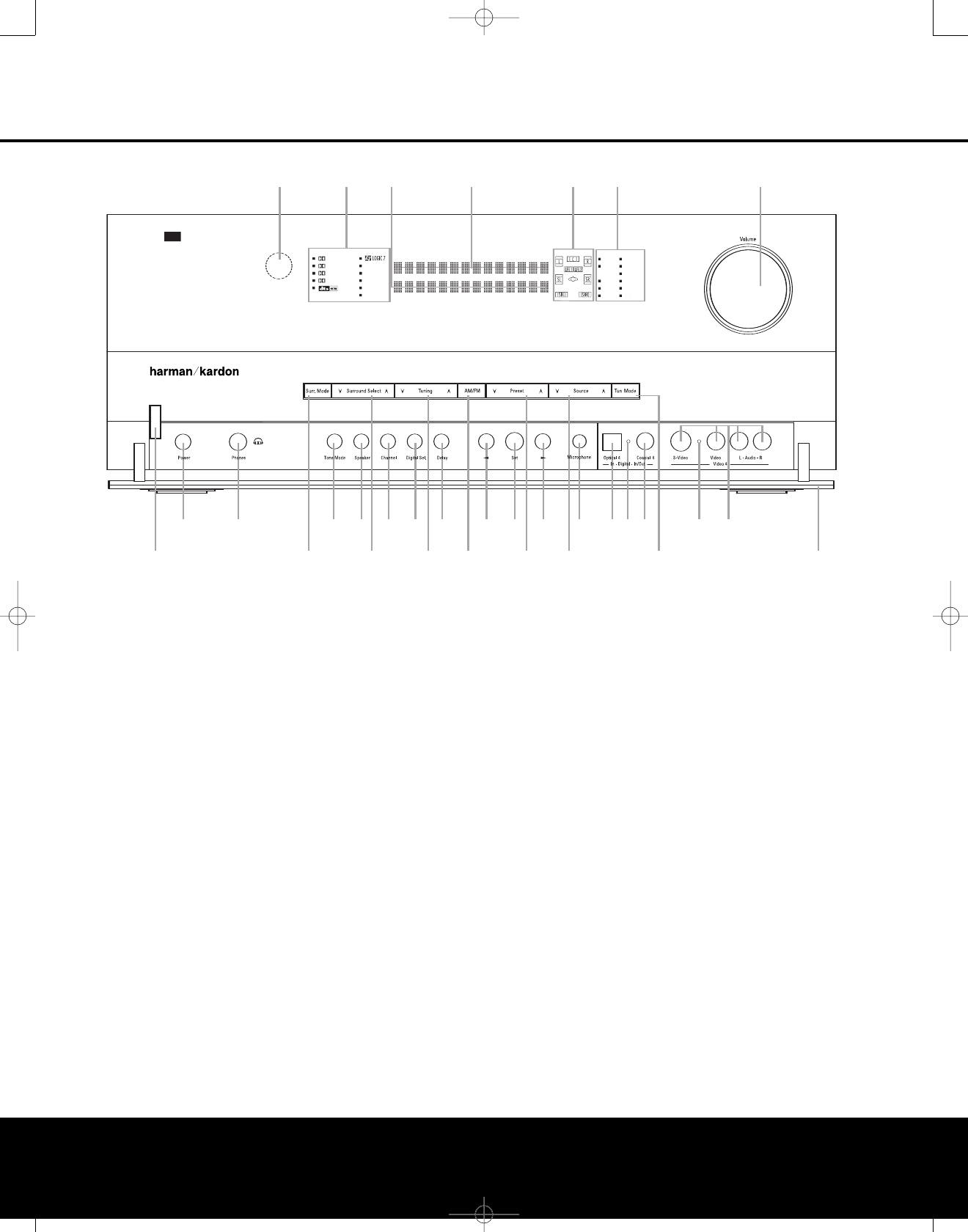
FRONT-PANEL CONTROLS
1Standby/On Switch
2Surround Mode Group Selector
3Surround Mode Selector
4Tuning Selector
5Tuner Band Selector
6Preset Station Selector
7Input Source Selector
8Tuning Mode Selector
9Front-Panel Door
)Volume Control
!Input Indicators
@Speaker/Channel Input Indicators
#Upper Display Line
$Lower Display Line
%Surround Mode Indicators
^Remote Sensor Window
FRONT-PANEL CONTROLS
FRONT-PANEL CONTROLS 55
The following controls and indicators are available on the AVR 745’s front panel:
The following controls and jacks are located behind the front-panel door. To open the door, place the edge of a finger on the left or right edge of the panel and gently swing the
door down toward you.
AMain Power Switch
BHeadphone Jack
CTone Mode Button
DSpeaker Selector Button
EChannel Adjust Selector
FDigital Input Selector
GDelay Adjust Selector
H‹/›Buttons
ISet Button
JEzSet/EQII Microphone Jack
KOptical 4 Digital Input
LInput/Output Status Indicators
MCoaxial 4 Digital Jack
NVideo 4 Input/Output Jacks
1Standby/On Switch: When the Main Power
Switch Ais “ON,” press this button to turn on the
AVR 745; press it again to turn the unit off. Note that
the illumination surrounding the switch will turn blue
when the unit is on, or in the Multiroom mode.
2Surround Mode Group Selector: Press this but-
ton to select the top-level group of surround modes.
Each press of the button will select one of the sur-
round mode categories.Once the button is pressed so
that the name of the desired surround mode category
appears in the on-screen display and in the Lower
Display Line $, press the Surround Mode
Selector 3to cycle through the individual modes
available. For example, press this button to select Dolby
modes, and then press the Surround Mode Selector
3to choose from the various mode options.
3Surround Mode Selector: Press this button
to select from among the available surround mode
options for the surround mode category selected.
The specific modes will vary based on the number of
speakers available, the surround mode category and
whether the input source is digital or analog. For exam-
ple, press the Surround Mode Group Selector 2
to select a category such as Dolby or Logic 7,and
then press this button to see the specific mode choices
that are available. For more information on mode
selection, see pages 40 – 42.
NOTE: To make it easier to follow the instructions that refer to this illustration, a larger copy may be downloaded from the Product Support section for this product at
www.harmankardon.com.
2 4 5 6 7 9
!
@
#
%
3 8
A B D E F G H H
I J K L L N
M
)
$
^
1
C
AVR 745
XMFMAM
USB
DMP
TAPE
8CH
6CH
DVD
DIGITAL
PRO LOGIC IIx
HEADPHONE
VIRTUAL SPEAKER
57CH. STEREO
EQ 1 2 3
DIRECT
DSP
SURR. OFF
CDMI
HDMI
VID 34
VID 12
AVR 745 OM 5/15/06 5:00 PM Page 5

FRONT-PANEL CONTROLS
6 FRONT-PANEL CONTROLS
4Tuning Selector: Press the left side of the button
to tune lower-frequency stations and the right side of
the button to tune higher-frequency stations. When
the tuner is in the MANUAL/MONO mode,
each tap of the Selector will increase or decrease the
frequency by one increment. When the tuner receives
a signal strong enough for adequate reception,
MANUAL TUNED will appear in the Lower
Display Line $and in the on-screen display. When
the tuner is in the AUTO/STEREO mode,
press the button once, and the tuner will scan for a
station with acceptable signal strength. When the
next higher- or lower-frequency station is tuned, the
frequency scan will stop and the Lower Display Line
$and the on-screen display will indicate AUTO
TUNED. When an FM stereo station is tuned, the
display will read AUTO ST TUNED. See page
45 for more information on using the tuner. When an
XM-Ready module is connected and activated, and
when there is sufficient signal strength for the XM
system to operate, pressing this button will change
the XM Radio channel.
5Tuner Band Selector: Pressing this button will
automatically switch the AVR 745 to the Tuner mode.
Pressing it again will select the AM or FM frequency
band, or XM Radio. (See page 45 for more informa-
tion on the tuner.)
6Preset Station Selector: Press this button to
scroll up or down through the list of stations that have
been entered into the preset memory. (See page 46
for more information on tuner programming.)
7Input Source Selector: Press this button to
change the input by scrolling up or down through the
list of input sources.
8Tuning Mode Selector: Press this button to select
Auto or Manual tuning. When the button is pressed so
that AUTO/STEREO appears in the Upper
Display Line #,the tuner will search for the next
station with an acceptable signal when the Tuning
Selector 4
é
is pressed. When the button is
pressed so that MANUAL/MONO appears in the
Upper Display Line #, each press of the Tuning
Selector 4
é
will increase the frequency. (See
pages 45–46 for more information on using the tuner.)
This button may also be used to switch between Stereo
and Mono modes for FM radio reception. When weak
reception is encountered, select the Manual/Mono
tuning mode. Press and hold again to switch back to
Stereo mode. (See pages 45–46 for more information
on using the tuner.)
When an XM Connect & Play module is connected
and activated, and when there is sufficient signal
strength for the XM system to operate, this button has
a different set of functions than when traditional AM or
FM radio is in use. See page 46 for more information
on XM Radio operation.
9Front-Panel Door: To open the door so that the
front-panel jacks and controls behind this door may be
accessed, gently pull the door down and toward you,
using either upper corner of the door.
)Volume Control: Turn this knob clockwise to
increase the volume, counterclockwise to decrease the
volume. If the AVR 745 is muted, adjusting the volume
control will automatically release the unit from the
silenced condition.
!Input Indicators: One of these indicators will light
to identify the currently selected input. Note that the
entire list will light briefly each time the unit is turned
on as a test.
@Speaker/Channel Input Indicators: These indi-
cators are multipurpose, indicating both the speaker
type selected for each channel and the incoming data-
signal configuration. The left, center, right, right surround
and left surround speaker indicators are composed of
three boxes, while the subwoofer is indicated by one or
two boxes. The center box lights when a “small” speaker
is selected, and the two outer boxes light when “large”
speakers are selected. When none of the boxes are
lit for the center, surround or subwoofer channels, no
speaker has been assigned that position. The letters
inside each box display the active input channels. For
standard analog inputs, only the L and R will light, indi-
cating a stereo input. For a digital source, the indicators
will light to display the channels being received at the
digital input. When the letters flash, the digital input has
been interrupted. (See page 44 for more information on
the Channel Indicators.)
#Upper Display Line: Depending on the unit’s
status, a variety of messages will appear here. In
normal operation, this line will show the current input
source and identify whether an analog or digital input
is in use. When the tuner is selected as the input, this
line will identify the station as AM or FM and show the
frequency and preset number, if any.
When an XM Connect & Play module is connected
and activated, and when there is sufficient signal
strength for the XM system to operate, the XM chan-
nel number and signal strength will appear here.
$Lower Display Line: Depending on the unit’s
status, a variety of messages will appear here. In nor-
mal operation, the current surround mode will appear
on this line. When an XM-Ready module is connected
and activated, and when there is sufficient signal
strength for the XM system to operate, a variety of
messages and information, including the XM channel
title name, the current artist and track title, the XM
Radio channel category and, when available, local
traffic and weather information, will appear here.
%Surround Mode Indicators: One of these
indicators will light to show the surround mode in
use. Depending on the specific combination of input
sources and surround mode selected, more than
one indicator may light. (See page 43 for more
information.)
^Remote Sensor Window: The sensor behind
this window receives infrared signals from the remote
control. Aim the remote at this area and do not block
or cover it unless an external remote sensor is
installed.
AVR 745 OM 5/15/06 5:00 PM Page 6
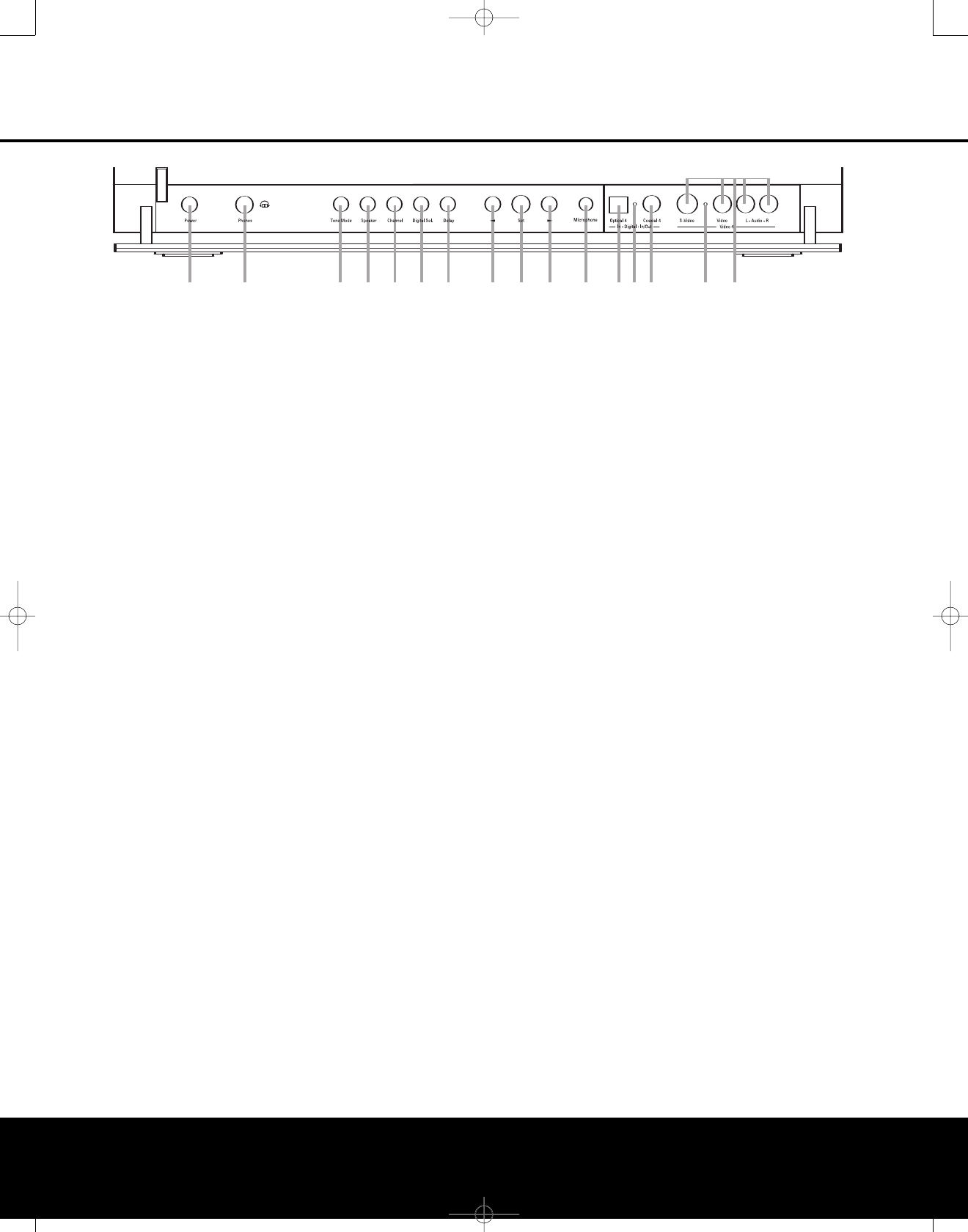
FRONT-PANEL CONTROLS
FRONT-PANEL CONTROLS 7
The following controls and jacks are located behind the front-panel door. To open the door, place the edge of a finger on the left or right edge of the panel and gently swing the
door down toward you.
AMain Power Switch: Press this switch to apply
power to the AVR 745. When the switch is pressed
in, the unit is placed in a Standby mode, as indicated
by the amber illumination surrounding the Standby/On
Switch 1. This button MUST be pressed in to
operate the unit. To turn the unit off and prevent the
use of the remote control, this switch should be
pressed until it pops out from the front panel so that
the word “OFF” may be read at the top of the switch.
NOTE: This switch is normally left in the “ON” position.
BHeadphone Jack: This jack may be used to lis-
ten to the AVR 745’s output through a pair of head-
phones. Be certain that the headphones have a stan-
dard 1/4" stereo phone plug, or that you use an
adapter, as needed, to convert the plug on your head-
phones to the 1/4" jack used on the AVR. When the
headphone jack is in use, the main room speakers will
automatically be turned off and the unit will output a
standard stereo signal. You may also use the Dolby
Headphone mode for an enhanced listening experi-
ence.
CTone Mode Button: This button controls the tone
mode settings, enabling adjustment of the bass and
treble boost/cut. You may also use it to take the tone
controls out of the signal path completely for “flat”
response. The first press of the button displays a
TONE MODE message in the Lower Display
Line $and in the on-screen display. To take the
controls out of the signal path, press either of the
‹/›Buttons Huntil the display reads TONE
OUT. To change the bass or treble settings, press
the button again until the desired option appears in the
Lower Display Line $and in the on-screen display
and then press either of the ‹/›Buttons Hto
enter the desired boost or cut setting. See page 40
for more information on the tone controls.
DSpeaker Selector Button: Press this button to
begin the process of configuring the AVR 745 for the
type of speakers it is being used with. For complete
information on configuring the speaker settings, see
page 33.
EChannel Adjust Selector: Press the button to
begin the process of manually adjusting the channel
level outputs using the source currently playing
through your AVR. For complete information on adjust-
ing the channel output level, see page 48.
FDigital Input Selector: Press this button to begin
the process of selecting a digital source for use with
the currently selected input. Once the button has been
pressed, use the ‹/›Buttons Hto choose the
desired input and then press the Set Button Ito
enter the setting into the unit’s memory. See page 42
for more information on digital audio.
GDelay Adjust Selector: Press this button to begin
the process of adjusting the delay settings for Dolby
surround modes. See page 35 for more information
on delay adjustments.
H‹/›Buttons: When making system configura-
tion changes using the front-panel controls, press
these buttons to scroll through the available choices
for the option being adjusted.
These buttons are also used to scroll through the
various video processing options. Press either ‹/›
button to activate Faroudja scaling and processing, or
video format conversion without scaling or bypass.
ISet Button: When making system configuration
changes using the front-panel controls, press this but-
ton to enter a setting into the unit’s memory.
JEzSet/EQII Microphone Jack: Before starting
the EzSet/EQII automated setup process, plug the
microphone into this jack. The microphone does not
need to be plugged in at other times.
KOptical 4 Digital Input: Connect the optical digital
output of an audio or video product to this jack.
LInput/Output Status Indicators: These LED
indicators will normally light green to show that the
front-panel Coaxial 4 Digital Jack Mand Video 4
Input/Output Jacks Nare operating as inputs. When
these jacks are configured for use as outputs, the
appropriate indicator will turn red to show that the jack
may be used as an output for recording. (See page 47
for more information on configuring the front-panel
jacks as outputs, rather than inputs.)
MCoaxial 4 Digital Jack: Connect the coaxial digi-
tal input or output for a digital audio product such as a
portable audio player or video game to this jack. The
jack is normally an input, but may be switched to an
output for recording, using the menu system. See
page 47 for more information.
NVideo 4 Input/Output Jacks: These audio/video
jacks may be used as either inputs or outputs for
temporary connection to video games or portable
audio/video products such as camcorders and
portable audio players. (See page 47 for more
information on switching one of these jacks between
an input and output.)
!
@
#
%
A B D E F G H H
I J K L L N
M
)
$
^
C
AVR 740
XMFMAM
USB
DMP
TAPE
8CH
6CH
DVD 34
DIGITAL PLUS
PRO LOGIC IIx
HEADPHONE
VIRTUAL SPEAKER
57CH. STEREO
EQ 1 2 3
DIRECT
DSP
SURR. OFF
CDMI 34
HDMI 12
VID 56
VID 34
VID 12
HD
AVR 745 OM 5/15/06 5:00 PM Page 7
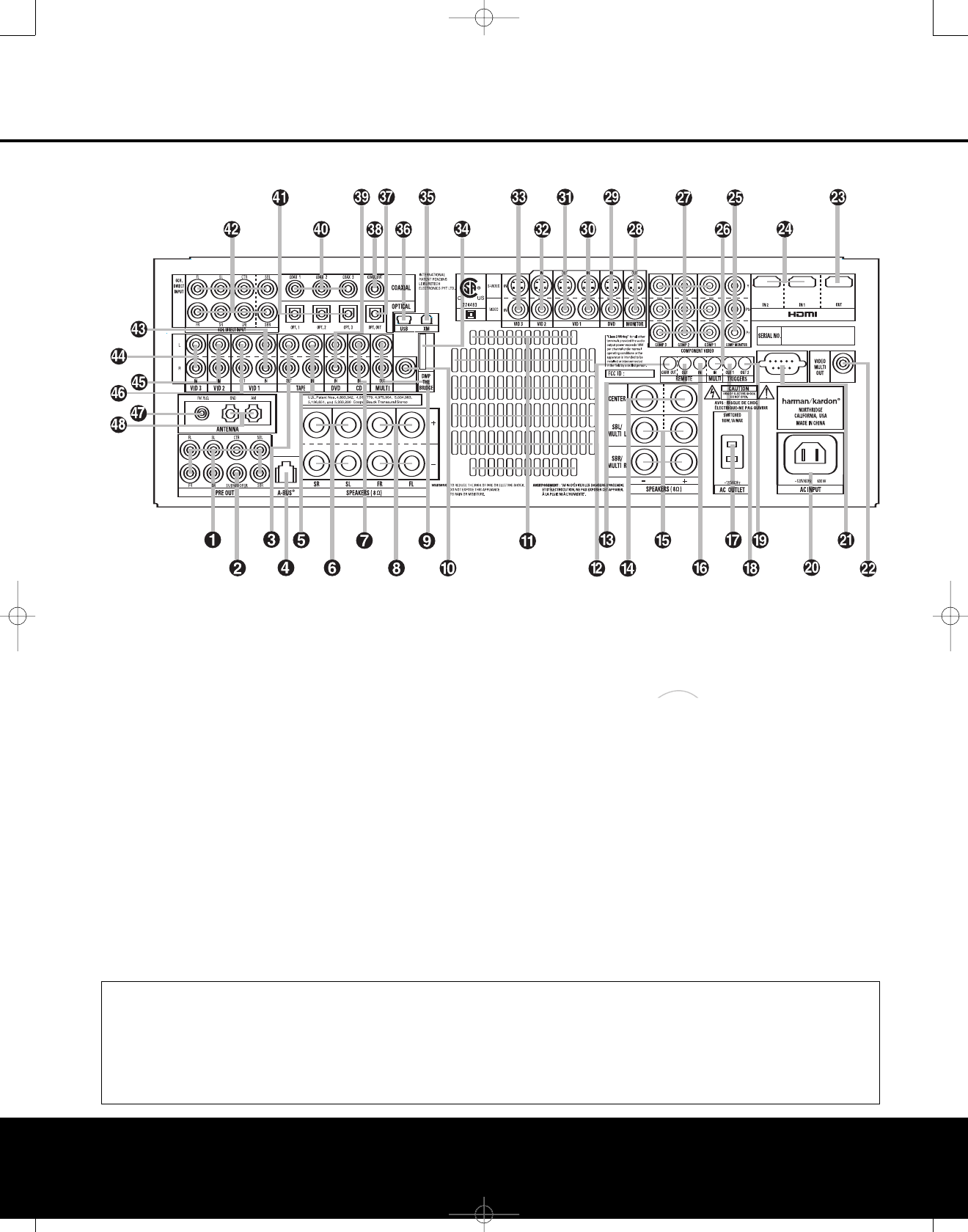
8REAR-PANEL CONNECTIONS
REAR-PANEL CONNECTIONS
0Preamp Outputs
1Main Subwoofer Output
2Tape Outputs
3A-BUS Connector
4Tape Inputs
5Surround Speaker Outputs
6CD Audio Input
7Front Speaker Outputs
8Multiroom Audio Outputs
9Subwoofer 2 Output
AFan Vents
BFull Carrier IR Output
CIR Output
DCenter Channel Speaker Outputs
ESurround Back/Multiroom Speaker Outputs
FIR Input
GSwitched AC Accessory Outlet
HTrigger 1 Output
ITrigger 2 Output
JAC Power Cord Socket
KRS-232 Port
LMultiroom Video Output
MHDMI Output
NHDMI Inputs
OComponent Video Monitor Outputs
PMultiroom IR Input
QComponent Video Inputs
RVideo Monitor Outputs
SDVD Video Inputs
TVideo 1 Video Inputs
UVideo 1 Video Outputs
VVideo 2 Video Inputs
WVideo 3 Video Inputs
XDigital Media Player (DMP) Input
YXM-Ready Module Input
ZUSB Connector
aOptical Digital Audio Output
bCoaxial Digital Audio Output
cDVD Audio Inputs
dCoaxial Digital Audio Inputs
eOptical Digital Audio Inputs
f8-Channel Direct Inputs
gVideo 1 Audio Inputs
hVideo 3 Audio Inputs
iVideo 2 Audio Inputs
jVideo 1 Audio Outputs
kFM Antenna Jack
lAM Antenna Connections
The
Bridge
TM
NOTE: To assist in making the correct connections for
multichannel input, output and speaker connections,
all connection jacks and terminals are color-coded
as follows:
Front Left: White
Front Right: Red
Center: Green
Surround Left: Blue
Surround Right: Gray
Surround Back Left: Brown
Surround Back Right: Tan
Subwoofer:Purple
Coaxial Digital Audio: Orange
Composite Video: Yellow
Component Video “Y”: Green
Component Video “Pr”: Red
Component Video “Pb”: Blue
Optical Digital In: Black
Optical Digital Out: Gray
REAR-PANEL CONNECTIONS
8REAR-PANEL CONNECTIONS
NOTE: To make it easier to follow the instructions that refer to this illustration, a larger copy may be downloaded from the Product Support section for this product at
www.harmankardon.com.
MODEL NO. AVR 745
SUB 2
AVR 745 OM 5/15/06 5:00 PM Page 8

REAR-PANEL CONNECTIONS 9
REAR-PANEL CONNECTIONS
0Preamp Outputs: Connect these jacks to an
optional, external power amplifier for applications
where higher power is desired.
1Main Subwoofer Output: Connect this jack
to the line-level input of a powered subwoofer. If an
external subwoofer amplifier is used, connect this jack
to the subwoofer amplifier input. If only one subwoofer
is used in your system, connect it here.
2Tape Outputs: Connect these jacks to the
Record/Input jacks of an audio recorder.
3A-BUS Connector:
Connect this jack to optional
A-BUS®-certified products to extend the multiroom
capabilities of your AVR 745. See page 17 for more
information on A-BUS.
4
Tape Inputs: Connect these jacks to the Play/Out
jacks of an audio recorder.
5Surround Speaker Outputs: Connect these out-
puts to the matching + and – terminals on your sur-
round channel speakers. In conformance with the CEA
color-code specification, the blue terminal is the posi-
tive (+) terminal that should be connected to the red
(+) terminal on the Surround Left speaker with older
color-coding, while the gray terminal should be con-
nected to the red (+) terminal on the Surround Right
speaker with the older color-coding. Connect the black
(–) terminal on the AVR to the matching black nega-
tive (–) terminals for each surround speaker. (See
page 15 for more information on speaker polarity.)
6CD Audio Inputs: Connect these jacks to the
left/right analog audio output of a compact disc player
or CD changer or other audio source.
7Front Speaker Outputs: Connect these outputs
to the matching + or – terminals on your left and right
speakers. When making speaker connections, always
make certain to maintain correct polarity by connecting
the color-coded (white for front left and red for front
right) (+) terminals on the AVR 745 to the red (+)
terminals on the speakers and the black (–) terminals
on the AVR 745 to the black (–) terminals on the
speakers. See page 15 for more information on
speaker polarity.
8Multiroom Audio Outputs: Connect these jacks
to the optional external audio power amplifier and
video distribution system that delivers the source
selected for multizone distribution.
9Subwoofer 2 Output: If your system has two
subwoofers,connect one to Main Subwoofer Output
1, and connect the line level input of a second sub-
woofer to this jack.
AFan Vents: These ventilation holes are the output
of the AVR 745’s airflow system. To ensure proper
operation of the unit and to avoid possible damage to
delicate surfaces, make certain that these holes are
not blocked and that there is at least 3 inches of open
space between the vent holes and any wooden or fab-
ric surface. It is normal for the fan to remain off at
most normal volume levels. An automatic temperature
sensor turns the fan on only when it is needed.
BFull Carrier IR Output: The output of this jack
is the full signal received at the Remote Sensor
Window ^or input through the IR Input Finclud-
ing the carrier frequency that is removed from signals
at the IR Output C.Use this output to extend IR
remote signals to the input of compatible products by
direct connection or through the use of optional, exter-
nal IR “blasters”. If you are in doubt as to which of the
two IR Output jacks to use, we recommend that you
consult with your dealer or installer, or check with the
manufacturer of the external equipment you wish
to control.
CIR Output: This connection permits the IR sensor
in the receiver to serve other remote controlled
devices. Connect this jack to the “IR IN” jack on com-
patible Harman Kardon equipment.
DCenter Channel Speaker Outputs: Connect
these outputs to the matching + and – terminals on
your center channel speaker. In conformance with the
CEA color-code specification, the green terminal is the
positive (+) terminal that should be connected to the
red (+) terminal on speakers with the older color-cod-
ing. Connect the black (–) terminal on the AVR to the
black negative (–) terminal on your speaker. (See
page 15 for more information on speaker polarity.)
ESurround Back/Multiroom Speaker Outputs:
These speaker terminals are normally used to power
the surround back left/surround back right speakers
in a 7.1-channel system. However,they may also be
used to power the speakers in a second zone, which
will receive the output selected for a multiroom system.
To change the output fed to these terminals from
the default of the Surround Back speakers to the
Multiroom Output, you must change a setting in the
Advanced Menu of the OSD system. See page 51 for
more information on configuring this speaker output.
In normal surround system use, the brown and black
terminals are the surround back left channel positive
(+) and negative (–) connections and the tan and
black terminals are the surround back right positive
(+) and negative (–) terminals. For multiroom use,
connect the brown and black SBL terminals to the
red and black connections on the left remote zone
speaker and connect the tan and black SBR terminals
to the red and black terminals on the right remote
zone speaker.
FIR Input: If the AVR 745’s front-panel IR sensor
is blocked due to cabinet doors or other obstruc-
tions, an external IR sensor may be used. Connect
the output of the sensor to this jack.
GSwitched AC Accessory Outlet: This outlet may
be used to power any device you wish to have turned
on when the AVR 745 is turned on with the Standby/
On Switch 1.
IMPORTANT NOTE: The power consumption of any
device connected to the accessory outlet should not
exceed 100 watts. Never connect high-power devices
such as amplifiers or video displays to the accessory
outlet.
HTrigger 1 Output: Connect this jack to the
“Trigger In” jack of an optional external component
such as an audio power amplifier that you want to be
controlled to mirror the power state of the AVR 745.
When this connection is used, the AVR 745 will auto-
matically send a low-voltage signal to the connected
device that turns it on when the AVR 745 is on and off
when the AVR 745 is placed in the Standby Mode.
The connected component must respond to 6-volt
presence as the control signal.
ITrigger 2 Output: Connect this jack to the
“Trigger In” jack of an optional, external component
such as a projection screen or motorized blinds that
you want to turn on or off in response to the power
state of the AVR 745, but only when certain inputs are
selected. (For example, lower a screen when a Video
related mode is selected, but not for the tuner or a CD
player.) For the 5-volt control signal to be sent to the
jack for device control, you must activate the appropri-
ate setting in PAGE 2 of the IN/OUT
SETUP menu.See page 23 for more information.
JAC Power Cord Socket: Connect the AC power
cord here when the installation is complete. To ensure
safe operation,use only the power cord supplied with
the unit. If a replacement is required, it must be of the
same type and capacity.
KRS-232 Port: This jack may be used to control
the AVR 745 over a bi-directional RS-232 serial
control link to a compatible computer or programmable
remote control system. Due to the complexity of
programming RS-232 commands, we strongly
recommend that connections to this port for
control purposes be made by a trained and qualified
technician or installer.
LMultiroom Video Output: Connect this jack to
the cable and/or optional, external video distribution
system that delivers the video source selected for mul-
tizone distribution to remote rooms. Only composite
video is available.
AVR 745 OM 5/15/06 5:00 PM Page 9

REAR-PANEL CONNECTIONS
10 REAR-PANEL CONNECTIONS
MHDMI Output: Connect this jack to the HDMI
input on a compatible HDMI-equipped video display.
NHDMI Inputs: Connect the HDMI output of video
sources such as a DVD player, set-top box or HDTV
tuner to either of these jacks.
OComponent Video Monitor Outputs: Connect
these outputs to the component video inputs of a
video display.
PMultiroom IR Input: Connect the output of an IR
sensor in a remote room to this jack to operate the
AVR 745’s multiroom control system.
QComponent Video Inputs: These inputs may be
used with any source device that is equipped with
analog Y/Pr/Pb or RGB component video outputs, as
assigned through the IN/OUT SETUP menu.
See page 22 for more information on configuring the
component video inputs.
RVideo Monitor Outputs: Connect these jacks to
the composite or S-video input of a TV monitor or
video projector to view the on-screen menus and the
output of any standard video source selected by the
receiver’s video switcher.
SDVD Video Inputs: Connect the composite or
S-video outputs of a DVD player or other video source
to these jacks.
TVideo 1 Video Inputs: Connect the composite or
S-video PLAY/OUT jacks of a VCR or other video
source to these jacks.
UVideo 1 Video Outputs: Connect the composite
or S-video REC/IN jacks of a VCR or other video
recording device such as a DVD recorder or PVR to
these jacks.
VVideo 2 Video Inputs: Connect the composite or
S-video PLAY/OUT jacks of a VCR or other video
source to these jacks.
WVideo 3 Video Inputs: Connect the composite or
S-video PLAY/OUT jacks of a VCR or other video
source to these jacks.
XDigital Media Player (DMP) Input:
With the AVR 745 turned off, connect the optional
Harman Kardon to this connector. Once
this is done and with a compatible iPod®(optional)
docked in The Bridge,selecting the DMP/The Bridge
input allows you to play audio programming from the
iPod and view navigation menus on the AVR’s front
panel and any video display connected to the AVR.
You may control the iPod’s functions and select
tracks using the ⁄/¤/‹/›
©
,Set
œ
and
Transport
π
buttons on the ZR 10 remote or with
the “Listen to The Bridge” activity, which activates
buttons on the TC 30 for direct control of your
iPod through The Bridge. See page 45 for more
information.
YXM-Ready Module Input: When an optional XM
Connect & Play module is connected to this jack, and
the XM service activated, you will be able to enjoy the
XM Radio through your AVR 745. See page 46 for
more information.
ZUSB Connector: Connect a cable with a USB
“Mini B” connector to the AVR and the other end to a
compatible computer running Windows®2000,
Windows®XP or higher with the latest service packs
installed, to use this port to listen to audio from the
computer through the AVR 745. This connection is
also used to connect a compatible computer to the
AVR for firmware upgrades, when available. See page
43 for more information on playback of computer
audio with the AVR. Instructions for upgrades will
accompany the upgrade file download package.
aOptical Digital Audio Output: Connect this jack
to the optical digital input connector on a CD-R/RW,
MiniDisc or other compatible digital recorder.
bCoaxial Digital Audio Output: Connect this jack
to the coaxial digital input of a CD-R/RW, MiniDisc or
other compatible digital recorder.
cDVD Audio Inputs: Connect the left/right analog
outputs of a DVD player or other audio source to
these jacks.
dCoaxial Digital Audio Inputs: Connect the coax
digital output from a DVD player, HDTV receiver,
LD
player
or CD player to these jacks. The signal may be a
Dolby Digital signal, DTS signal or a standard PCM digital
source.Do not connect the RF digital output of an LD
player to these jacks.
eOptical Digital Audio Inputs: Connect the optical
digital output from a DVD player, HDTV receiver, LD
player or CD
player to these jacks.The signal may be a
Dolby Digital signal, a DTS signal or a standard PCM
digital source.
f8-Channel Direct Inputs: These jacks are used
for connection to source devices such as high-resolu-
tion DVD players, DVD-Audio or SACD players with
discrete analog audio outputs. Depending on the
source device in use, all eight jacks may be used,
though in many cases only connections to the front
left/right, center, surround left/right and LFE (sub-
woofer input) jacks will be used for 5.1 audio signals.
gVideo 1 Audio Inputs: Connect the left/right
PLAY/OUT audio output jacks on a VCR or other video
source to these jacks.
hVideo 3 Audio Inputs: Connect the left/right
PLAY/OUT audio output jacks on a VCR, PVR, cable
set-top, satellite receiver, HDTV receiver or other video
source to these jacks.
iVideo 2 Audio Inputs:Connect the left/right
PLAY/OUT audio output jacks on a VCR or other video
source to these jacks.
jVideo 1 Audio Outputs: Connect the left/right
REC/IN audio input jacks on a VCR or other video
source to these jacks.
kFM Antenna Jack: Connect the supplied indoor or
an optional external FM antenna to this terminal.
lAM Antenna Connections: Connect the AM loop
antenna supplied with the receiver to these terminals. If
an external AM antenna is used, make connections to
the AM and GND terminals in accordance with the
instructions supplied with the antenna.
The
Bridge
TM
The
Bridge
TM
AVR 745 OM 5/15/06 5:00 PM Page 10
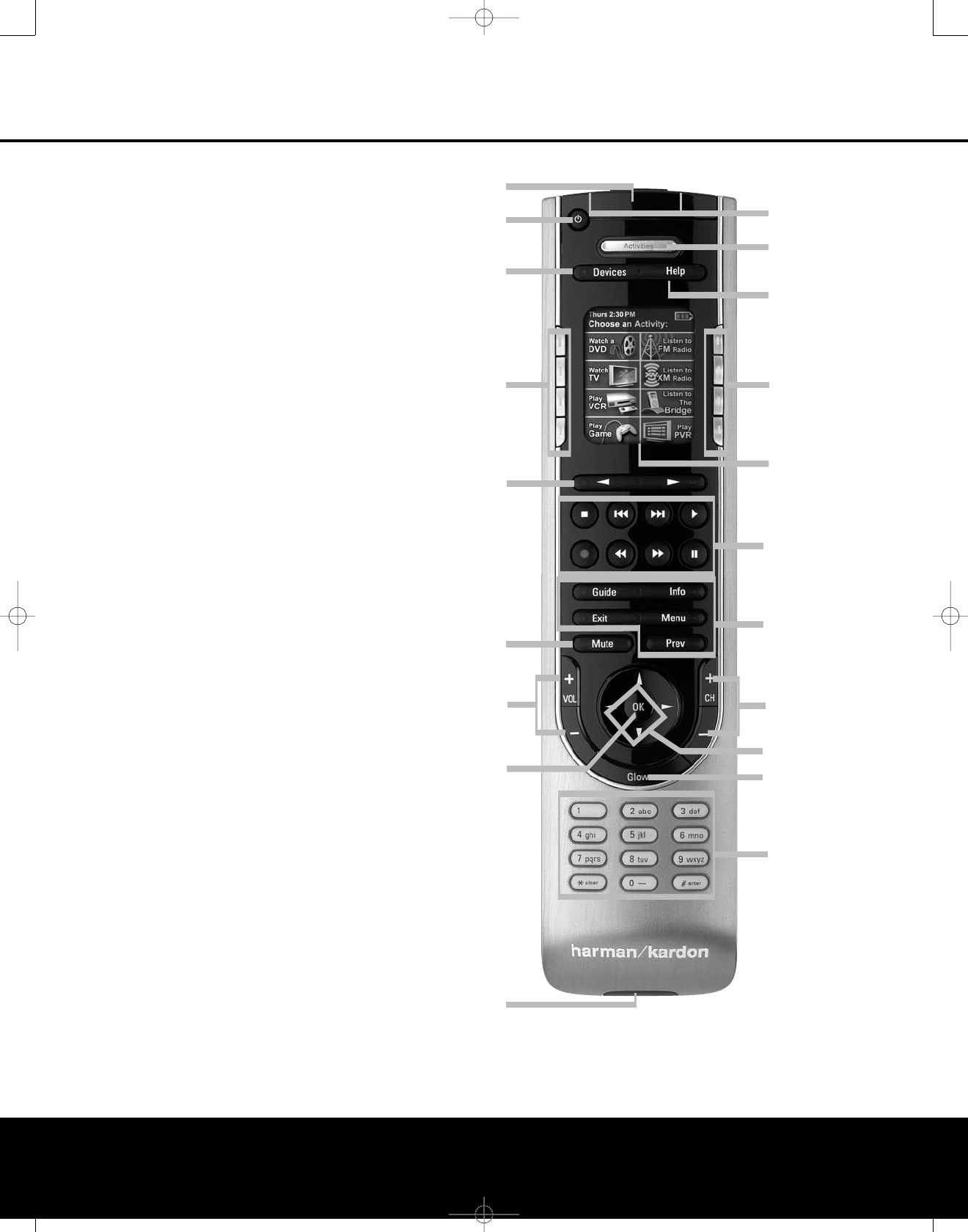
TC 30 REMOTE CONTROL FUNCTIONS
TC 30 REMOTE CONTROL FUNCTIONS 11
0USB Connector
1IR Emitter Window
2Power Button
3Activities Button
4Devices Button
5Help Button
6Screen Buttons
7LCD Screen
8Page Left/Right Buttons
9Transport Control Buttons
ADevice Control Buttons
BMute Button
CVolume Controls
DNavigation Buttons
EOK/Enter Button
FGlow Button
GChannel Up/Down
HNumeric Keys
IInfrared Learning Port
I
3
F
0
1
2
4
6
7
5
6
8
9
BA
C
E D
G
H
NOTES:
• The function names shown here are each button’s
feature when used with the AVR 745. Most
buttons have additional functions when used with
other devices.
• To make it easier to follow the instructions that refer
to this illustration, a larger copy may be downloaded
from the Product Support section for this product at
www.harmankardon.com.
AVR 745 OM 5/15/06 5:00 PM Page 11

TC 30 REMOTE CONTROL FUNCTIONS
0USB Connector: Push down on the rubber
cover to access the USB connecter. To program the
TC 30 from our Web site, connect the supplied USB
cable here, and then to your computer.
1IR Emitter Window: Point this end of the
remote toward the devices being controlled.
2Power Button: Press this button to turn the
AVR off. Depending on the particular device being
controlled, it may turn other devices on or off. When
an Activity is in use, pressing this button will turn off
all devices associated with the Activity.
3Activities Button: Press this button to view the
list of Activities programmed into your TC 30. Press
the Screen Button 6next to an Activity to select it
and turn on the Devices in that Activity.
4Devices Button: Press this button to display a
list of all the Devices programmed in your TC 30. To
control the Device, press the Screen Button 6
next to the desired Device’s name.
5Help Button: If you are having problems with an
Activity, press this button for interactive help screens
that will resolve issues with synchronizing the status of
the components in your system.
6Screen Buttons:
Press the buttons at either side
of the LCD screen to select the Activity, Device or com-
mand shown next to the button.
7LCD Screen: The LCD screen displays system
messages, help screens and the functions assigned to
the Screen Buttons 6, depending on the remote’s
current status.
8Page Left/Right Buttons: Press these buttons
to show additional screen display pages for a Device,
Activity or setup function.
9Transport Control Buttons: Press these buttons
to control the transport functions Í/❙‹‹/››❙/›/Î/
››/‹‹/❙❙ for devices such as DVD or CD players,
digital recorders and VCRs when they are active.
ADevice Control Buttons: These buttons directly
control functions of the currently active device. The
names on the individual button names are the typical
function, but the actual function will vary with the
device.When using the TC 30 to setup and configure
the AVR 745, press the “Menu” button to activate the
on-screen menus.
BMute Button: Press this button to activate the
MUTE function of the device being controlled.
CVolume Controls: Press these buttons to
change the volume of the device being controlled.
DNavigation Buttons: The function of the
⁄/¤/‹/›buttons varies according to the device
being controlled.
EOK/Enter Button: This button is normally the
“Set,” “Enter” or “Select” function for the device being
controlled, but its function will vary, according to the
device being controlled.
FGlow Button: Press this button to illuminate the
LCD screen and the button backlighting. The back-
lighting will also come on when any button is pushed.
You may change the setting for the length of time the
lighting is on through the settings available when your
TC 30 is connected to the Internet. The backlighting
will also turn on automatically any time you move the
remote, thanks to a built-in “tilt sensor.” You may dis-
able the “tilt-on” function in the Remote Options sec-
tion of the TC 30 Web site.
GChannel Up/Down: Press these buttons to
change the device’s channel or station. When control-
ling the AVR 745’s tuner function, these buttons are
used to step up or down through the list of stations in
the preset memories.
HNumeric Keys: These buttons enter numeric
values for the device being controlled.
IInfrared Learning Port: When “learning” com-
mands from a device’s remote into the TC 30, point
the IR transmitter on the remote being “learned” here.
12 TC 30 REMOTE CONTROL FUNCTIONS
AVR 745 OM 5/15/06 5:00 PM Page 12
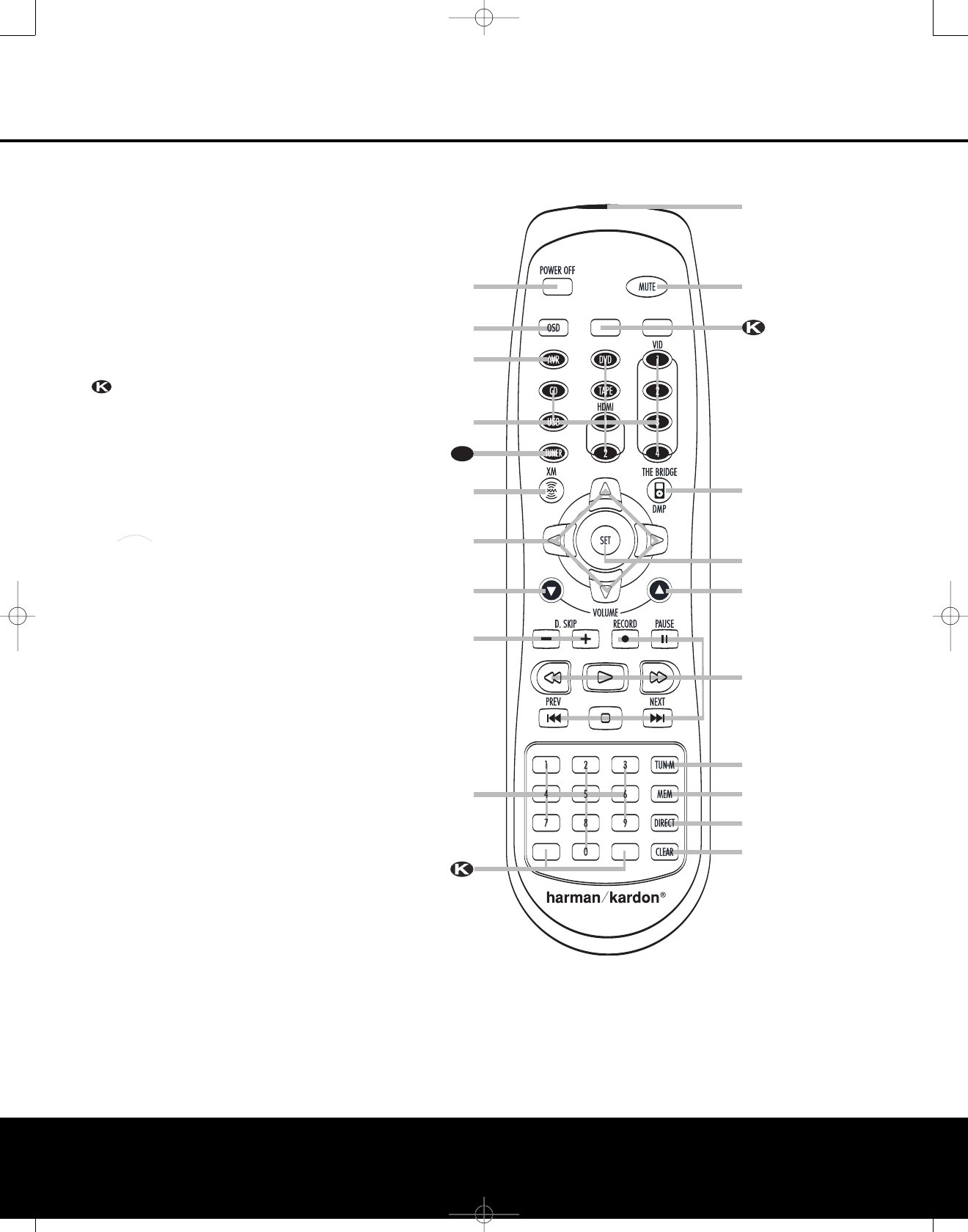
ZR 10 REMOTE CONTROL FUNCTIONS
å
Power Off Button
∫
OSD Button
ç
AVR Selector Button
∂
Input Selectors
≠
Tuner Selector
ƒ
XM Radio Selector
©
Navigation Controls
˙
Volume Up/Down Buttons
î
Disc Skip Buttons
∆
Numeric Keys
Blank Buttons
¬
Clear Button
µ
Direct Button
ñ
Memory Button
ø
Tuner Mode Button
π
Transport Controls
œ
Set Button
®
/DMP Selector
ß
Mute Button
†
IR Transmitter Lens
The
Bridge
TM
E
å
∫
ç
∂
ƒ
©
˙
î
∆
¬
µ
ñ
ø
π
œ
®
ß
†
E
˙
NOTES:
• The ZR 10 remote may be used either in the same
room where the AVR 745 is located or in a separate
room with an optional infrared sensor or A-BUS prod-
uct that is connected to the AVR 745’s Multiroom IR
Input Jack g. When it is used in the same room
as the AVR 745, it will control the functions of the
AVR 745 or any compatible Harman Kardon products
in that room. When it is used in a separate room via a
sensor connected to the Multiroom IR Input Jack
g, the buttons for Power, Input Source, Volume and
Mute will control the source and volume for the sec-
ond zone,as connected to the Multiroom Audio
Output Jacks ª. (See page 51 for complete
information on using the Multiroom system.)
´• We strongly recommend that the ZR 10 remote be
used for the initial configuration and setup process for
the AVR 745.
• To make it easier to follow the instructions that refer to
the controls and connectors in this illustration, a larger
copy may be downloaded from the Product Support
section for this product at www.harmankardon.com.
ZR 10 REMOTE CONTROL FUNCTIONS 13
AVR 745 OM 5/15/06 5:00 PM Page 13

14 ZR 10 REMOTE CONTROL FUNCTIONS
å
Power Off Button: When used in the room
where the AVR 745 is located, press this button
to place the unit in Standby. When it is used in a
remote room with a sensor that is connected to the
Multiroom IR Input Jack g,this button turns the
Multiroom system on and off.
∫
OSD Button: Press this button to activate or
turn off the On-Screen Display (OSD) menu system
used to set up or adjust the AVR 745’s configuration
settings.
ç
AVR Selector Button: Press this button to turn
on the AVR 745. The input in use when the unit was
last on will be selected.
∂
Input Selectors: When the AVR 745 is off,
press one of these buttons to select a specific input
and turn the unit on. When the unit is already in use,
pressing one of these buttons will change the input.
≠
Tuner Selector: Press this button to select the
Tuner as the input source and listen to the tuner band
last used. Press the button again to change between
AM, FM and, if an XM Connect & Play module is con-
nected and activated, XM Radio.
ƒ
XM Radio Selector: Press this button to select
XM Radio as the input source when an XM Connect &
Play module is connected and activated.
©
Navigation Controls: Depending on the menu
or function in use, pressing these buttons will navigate
through menus, scroll through option lists or configura-
tion choices, or move the cursor position. Press the
left, right, up or down button, as appropriate to the
adjustment being made.
˙
Volume Up/Down Buttons: When the ZR 10
remote is used in the room where the AVR 745 is
located, press this button to raise or lower the volume
in that room. When it is used in a remote room with a
sensor that is connected to the Multiroom IR Input
Jack g,this button will raise or lower the volume in
the remote room.
î
Disc Skip Buttons: Press these buttons to
change discs on compatible Harman Kardon CD or
DVD changers or players.
∆
Numeric Keys: Press these buttons to enter a
station’s frequency or an XM Radio channel number
after the Direct Button
µ
is pressed, or when pro-
gramming the tuner memories.These buttons may
also be used for numeric entries when appropriate
with other compatible sources.
Blank Buttons: These buttons are not active.
Pressing them will not change or control any function
on the AVR 745 or other IR devices.
¬
Clear Button: When programming the tuner
memory, press this button to clear the current entry.
µ
Direct Button: Press this button when the tuner
is in use to start the entry of a station’s frequency or
an XM channel number for direct access to that sta-
tion or channel. After pressing this button, press the
appropriate Numeric Keys
∆
.
ñ
Memory Button: Press this button to enter a
station or XM channel number into the AVR 745’s
memory. First, tune to, or select, the desired station or
channel, and then press this button. Within five sec-
onds, while you see the station or channel flash in the
Upper Display Line Cand in the on-screen
display, press the Numeric Keys
∆
for the preset
number between 01 and 30 that you wish to assign
to the station or channel. (See page 46 for more
information.)
ø
Tuner Mode Button: When listening to AM or
FM stations, press this button to change the tuner
mode between manual and automatic. When the
button is pressed so that AUTO/STEREO
appears in the Upper Display Line Cand in the
on-screen display, only stations with acceptable signal
quality will be tuned, and the tuner will play FM sta-
tions in stereo, when available. In the AUTO mode,
when the Tuning Up/Down Buttons 3
π
are
pressed, the unit will automatically search for the next
available station with good signal strength. When this
button is pressed so that MANUAL/MONO
appears in the Upper Display Line Cand in
the on-screen display, each press of the Tuning
Up/Down Buttons 3
π
will move the frequency
up or down in single-step increments. When the
FM band is in use, pressing the button so that the
MANUAL mode is activated will enable you to tune
stations with weak signals by changing to monaural
reception. (See pages 45–46 for more information on
AM/FM tuner operation.) When listing to XM Radio,
press this button to scroll through the following display
options for the Lower Display Line D: Channel
Name ➛Channel Category ➛Artist ➛Title.
(See pages 46–47 for more information on
XM Radio operation.)
π
Transport Controls: Press these buttons to
control the operation of a compatible Harman Kardon
DVD or CD player when the AVR 745 is connected
to the source unit via the IR Input Jack F.
When the AVR’s tuner or XM Radio is in use,the
❙‹‹/››❙Prev/Next Buttons
π
are used to
tune up or down through the list of preset stations. the
station frequencies or channel numbers.
œ
Set Button: When using the configuration
menus, press this button to enter a setting to the
AVR’s memory.
®
Digital Media Player Selector: When
Harman Kardon’s (optional) is connected to
Digital Media Player (DMP) Input Xand
a compatible iPod is docked in , pressing this
selector will select the iPod as the audio source input
device for the AVR 745. In addition, if a video display
is connected to one of the Video Monitor Outputs
OR, the iPod’s messages will appear on screen,
and in the Upper and Lower Display Lines CD.
The ⁄
/
¤
/
‹
/
›Buttons
©
,the Set Button
œ
and the Transport Controls
π
may be used
to navigate the iPod and to operate many functions.
See page 45, and the manuals for The Bridge and
your iPod for more information.
ß
Mute Button: When the ZR 10 remote is used
in the room where the AVR 745 is located, press this
button to temporarily silence the unit. When it is used
in a remote room with a sensor that is connected
to the Multiroom IR Input Jack g, this button will
temporarily silence the feed to the remote room
only. Press the button again to return to the previous
volume level.
†
IR Transmitter Lens: The infrared code com-
mands from the remote are sent to the AVR from the
components behind this lens. To ensure proper opera-
tion, do not block this area when holding the remote.
The
Bridge
TM
The
Bridge
TM
The
Bridge
TM
The
Bridge
TM
E
ZR 10 REMOTE CONTROL FUNCTIONS
AVR 745 OM 5/15/06 5:00 PM Page 14

INSTALLATION AND CONNECTIONS
System Installation
After unpacking the unit, locating it in a place with ade-
quate ventilation and placing it on a solid surface capable
of supporting its weight, you will need to make the con-
nections to your audio and video equipment.
Before starting to connect your AVR 745 to the
source devices, display device, speakers and other
components in your system, you should also unpack
the TC 30 remote, which is found in the separate box
inside the AVR 745 carton. So that the TC 30 is ready
when you begin the system configuration process,
install the battery, connect the charger and place the
remote in the charging cradle, as it takes approximately
twelve hours for the battery to fully charge.
IMPORTANT NOTE: For your personal safety and to
avoid possible damage to your equipment and speakers,
it is always good practice to turn off and unplug the AVR
and ALL source equipment from the AC output before
making any audio or video system connections.
Audio Equipment Connections
We recommend that you use high-quality interconnect
cables when making connections to source equipment
and recorders to preserve the integrity of the signals.
1. Connect the analog output of a CD player to the
CD Audio Inputs 6.
NOTE: If your CD player has both fixed and variable
audio outputs, it is best to use the fixed output unless
you find that the input to the receiver is so low that the
sound is noisy, or so high that it is distorted.
2. Connect the analog Play/Out jacks of a cassette
deck, MD, CD-R or other audio recorder to the
Tape Inputs 4. Connect the analog Record/In
jacks on the recorder to the Tape Outputs 2
on the AVR 745.
3. Connect the output of a digital source such as
a CD or DVD changer or player, a video game, a
digital satellite receiver, an HDTV tuner or digital
cable set-top box or the output of a compatible
computer sound card to the Optical and Coaxial
Digital Audio Inputs deKM.
4. Connect the coaxial or optical Digital Audio Outputs
ab on the rear panel of the AVR 745 to the match-
ing digital input connections on a CD-R, MiniDisc or
other digital recorder.
5. Assemble the AM loop antenna supplied with the unit
so that the tabs at the bottom of the antenna loop
snap into the holes in the base. Connect it to the AM
Antenna Connections l.
6. Connect the supplied FM antenna to the FM
Antenna Jack k. The FM antenna may be
an external roof antenna, an inside powered or
wire-lead antenna or a connection from a cable
TV system. If the antenna or connection uses
300-ohm twin-lead cable, you must use an optional
300-ohm-to-75-ohm adapter to make the
connection.
7. Connect the front, center, surround and surround
back speaker outputs 57DE to the respec-
tive speakers.
To ensure that all the audio signals are carried to your
speakers without loss of clarity or resolution, we sug-
gest that you use high-quality speaker cable. Many
brands of cable are available and the choice of cable
may be influenced by the distance between your
speakers and the receiver, the type of speakers you
use, personal preferences and other factors. Your
dealer or installer is a valuable resource to consult in
selecting the proper cable.
Regardless of the brand of cable selected, we recom-
mend that you use cable
with a gauge of 14 or smaller.
Remember that when specifying cable,the lower the
number, the thicker the cable.
Cable with a gauge of 16 may be used for short runs
of less than 10 feet. We do not recommend that you
use cables with an AWG equivalent of 18 or higher,
due to the power loss and degradation in performance
that will occur.
Cables that are run inside walls should have the appro-
priate markings to indicate listing with UL, CSA or other
appropriate testing agency standards. Questions about
running cables inside walls should be referred to your
installer or a licensed electrician who is familiar with
the NEC and/or the applicable building codes in
your area.
When connecting wires to the speakers, be certain
to observe proper polarity.Note that the positive (+)
terminal of each speaker connection has a specific color
code, as noted on page 8. However, most speakers
still use a red terminal for the positive (+) connection.
Connect the “negative” or “black” wire to the same
terminal on both the receiver and the speaker.
NOTE: While most speaker manufacturers adhere to
an industry convention of using black terminals for
negative and red ones for positive,some may vary
from this configuration. To ensure proper phase and
optimal performance, consult the identification label on
your speaker or the speaker’s manual to verify polarity.
If you do not know the polarity of your speaker, ask
your dealer for advice before proceeding, or consult
the speaker’s manufacturer.
We also recommend that the length of cable used
to connect speaker pairs be identical. For example,
use the same length piece of cable to connect the
front-left and front-right or surround-left and sur-
round-right speakers, even if the speakers are a
different distance from the AVR 745.
8. Connections to a single subwoofer are normally
made via a line-level audio connection from the
Main Subwoofer Output 1to the line-level input
of a subwoofer with a built-in amplifier. When a
passive subwoofer is used, the connection first
goes to a power amplifier, which will be connected
to one or more subwoofer speakers. If you are
using a powered subwoofer that does not have
line-level input connections, follow the instructions
furnished with the speaker for connection informa-
tion. If your system uses two subwoofers, connect
the Subwoofer 2 Output 9jack on the AVR to
the Line Input of the second subwoofer.
9. If an external audio source such as a DVD-Audio,
SACD or high definition optical disc player with 5.1
or 7.1 analog audio outputs is part of your system,
connect the outputs of the source to the 8-Channel
Direct Inputs f.
Analog Video Equipment Connections
Analog video components are connected in the same
manner as audio components. Again, the use of high-
quality interconnect cables is recommended to preserve
signal quality.
1. Connect the Video Play/Out jacks of a standard
(composite) video or S-Video outputs of a digital
video recorder or conventional VCR to the Video 1
Video Inputs Ton the AVR. Connect the
Record/In jacks from that device to the Video 1
Video Outputs Uon the AVR.
2. Connect analog Audio Left/Right Play/Out jacks of
the device connected to the Video 1 Inputs to the
Video 1 Audio Inputs gon the AVR. Connect
the analog Audio Left/Right Record/In jacks from
that device to the Video 1 Audio Outputs jon
the AVR. If the device has a digital audio output,
connect it to one of the Coaxial dor Optical e
digital audio inputs.
3. Connect the Play/Out jacks of a standard (compos-
ite) video or S-Video outputs of a video playback
source such as a set-top box or video game con-
sole to the Video 2 Video Inputs Vor Video 3
Video Inputs W.If the device has analog compo-
nent video (Y/Pr/Pb) outputs, connect them to one
of the Component Video Inputs Q.
4. Connect the analog audio outputs from the source
to the matching Video 2 Audio Inputs ior
Video 3 Audio Inputs h.If the device has a digi-
tal audio output, connect it to one of the Coaxial
dor Optical edigital audio inputs.
5. If the any of the video source devices has analog
component video (Y/Pr/Pb) outputs, but not HDMI,
connect them to Component Video Inputs Q.
The chart on page 55 has the default settings for
INSTALLATION AND CONNECTIONS 15
AVR 745 OM 5/15/06 5:00 PM Page 15

16 INSTALLATION AND CONNECTIONS16 INSTALLATION AND CONNECTIONS
INSTALLATION AND CONNECTIONS
various source devices, but you may make any
connection and change the configuration setting
using the IN/OUT SETUP menu, as
described on page 22.
6. The default video connection for a DVD player is to
use the Component Video Input 3 Jacks Qon
the AVR, but you may change this assignment in
the IN/OUT SETUP menu (see page 22).
A DVD player’s composite and S-video outputs may
also be connected to the DVD Video Inputs S.
Only one connection type is required, although a
composite or S-video connection is required if the
AVR 745 is to be used in a multiroom video system.
7. The default audio connection for a DVD player is
to link the coaxial digital audio output on the DVD
player to the Coaxial 1 Digital Audio Input d,
but you may also make a connection to either the
Coaxial dor Optical edigital inputs, or the
Analog DVD Audio Inputs c.You may change
the assignment in the IN/OUT SETUP
menu as described on page 22, or by using the
front-panel Digital Input Selector F.
8. If you wish to use a portable audio/video product
such as a camcorder, portable media player or
digital still camera with the AVR, or make a connec-
tion to a video game console or other source that
may not always be connected to the AVR, connect
the video outputs of the source to the Video 4
Input/Output Jacks Nthat are behind the
Front-Panel Door 8. If the source has digital
audio outputs, connect them to the Optical 4
Digital Input Kor the Coaxial 4 Digital Jack M.
CONNECTION NOTES:
• When making connections to the Component
Video Inputs Qor the Coaxial dor Optical
edigital audio inputs, it is a good idea to make
note of which jacks are connected to which
source, using the Worksheet in the Appendix. This
will help simplify the configuration process.
• When connecting a source device such as a
cable set-top box where the audio streams may
change between digital and analog as you
change channels, we recommend that you make
both analog and digital connections. The AVR’s
Auto Poll feature will automatically sense when
the digital stream is replaced by an analog output
and switch the input accordingly. (See page 22
for more information on the Auto-Poll feature.)
This dual connection is not required for sources
(such as DVD players or video games) that always
output a digital stream.
9. Connect the AVR to your video display using one of
the following connections:
• If you have a video display with an HDMI or DVI
input, make the connection using the HDMI
Output d, as described in the next section.
• If your video display has component video inputs
(Y/Pr/Pb), connect the Component Video
Outputs O.
• If your display does not have digital or compo-
nent video inputs, connect the Video Monitor
Output Ron the AVR to the matching input on
your display. Only one connection is needed, and
S-video is the higher quality signal.
HDMI Connections
HDMI™is the abbreviation for High-Definition
Multimedia Interface, which is quickly becoming
the standard connection point between advanced
video/audio source products and displays, particularly
for high-definition video signals. HDMI is a digital con-
nection, eliminating the need to convert signals back
and forth from digital to analog to deliver a higher
quality signal when used with digital sources. The sig-
nals carried on HDMI may, but do not always, include
audio, offering the possibility of a complete one-wire
connection from a source to the AVR. However, it is
important to note that there are a number of different
versions of the HDMI standard in use. Before connect-
ing any HDMI products to your AVR, it is helpful to find
out in advance their level of HDMI connectivity.
Some source or display components in your system
may use DVI (Digital Video Interface) for digital video
connections. DVI carries the same digital video signals
as HDMI but uses a larger connector and does not
transport audio or control signals. In most cases, you
may mix and match DVI and HDMI digital video con-
nections by using optional connector adapters. Note,
however, that some DVI-equipped video displays are
not compatible with the HDCP copy protection coding
that is increasingly carried with signals connected
via HDMI. If you have an HDMI source and a DVI-
equipped display, you may occasionally be unable to
view a program if the display does not include HDCP.
This is not the fault of the AVR or your source; it sim-
ply indicates that the video display is not compatible.
HDMI Input Connections
The different “Version” levels of HDMI define which
type of audio signals it is compatible with. Based on
the lowest level of HDMI among your sources, the
connections to the AVR should be made as follows:
• HDMI 1.0 sources carry digital video and multi-
channel or 2-channel PCM audio signals only.
Connect the HDMI output of a 1.0 source to either
of the HDMI Inputs Non the AVR. If the product
is a DVD-Audio player or other source that has mul-
tichannel analog audio outputs, connect them to the
8-Channel Direct Inputs f.With an HDMI 1.0
source, particularly a DVD player, make certain
that the menus in the source device are set to
“Bitstream Out” or “Original” so that 5.1 digital audio
is available. If you find that 5.1 Dolby Digital or DTS
audio is not available on the HDMI connection, it
will be necessary to make an additional connection
between the source and the AVR 745 to either the
Coaxial dMor Optical eKDigital Inputs.
• HDMI 1.1 sources carry the multichannel digital
audio output from DVD-Audio players in addition to
the digital video. If you have an HDMI 1.1-equipped
product, the only connection needed for listening
in the main room is from the HDMI output of the
source to either of the HDMI Inputs Non the
AVR. If the player has SACD capability, you will need
to connect the analog outputs of the source to the
8-Channel Direct Inputs f.
• HDMI 1.2
(and higher) sources should be connected
as shown above for HDMI 1.1, except that a
separate analog connection is not needed for
SACD players.
• It is not possible to feed an analog composite or
S-video signal to a recorder or the AVR’s multizone
system when an HDMI input is in use. If an HDMI-
equipped source also has analog audio and video
outputs, connect them to the Video 2 or Video 3
Video VW and Audio hi on the AVR.
• In some instances, HDMI-equipped sources will not
permit more than one video output at a time, and
thus you cannot use the same source in the main
listening room and with the recorder or remote zone
at the same time. This is not a fault of the AVR, but
rather a function of the content protection systems
that are part of the HDMI standard.
HDMI Output Connections
Connect the HDMI Output Mto an HDMI input on
your video display. Thanks to the AVR 745’s video
processing system, all video input signals are converted
to an HDMI output, so only one connection is required
between the AVR and your display.
System and Power Connections
The AVR 745 is designed for flexible use with multi-
room systems,external control components and
power amplifiers.
Main Room Remote Control Extension
If the receiver is placed behind a solid or smoked-
glass cabinet door, the obstruction may prevent the
remote sensor from receiving commands. In this
event, an optional remote sensor may be used.
Connect the output of the remote sensor to the
IR Input fl.
If other components are also prevented from receiving
remote commands, only one sensor is needed. Simply
use this unit’s sensor or a remote eye by running a
connection from the IR Output ‹to the Remote IR
Input jack on Harman Kardon or other compatible
equipment.
If other Harman Kardon-compatible source equipment
is part of the main room installation, the IR
Output
Jack ‹on the rear panel should be connected
to the
IR IN jack on source equipment. This will enable the
INSTALLATION AND CONNECTIONS
AVR 745 OM 5/15/06 5:00 PM Page 16

INSTALLATION AND CONNECTIONS
remote room location to control source equipment
functions.
When a remote IR sensor is used to control non-
Harman Kardon source equipment, we recommend
that you make a hard wire connection or use an
optional, external IR “blaster” connected to the Full
Carrier IR Output ¤. If you are in doubt as to which
IR Output jack to use for the equipment in your sys-
tem, contact your dealer or installer, or the manufac-
turer’s support site and ask whether the unit to be
controlled uses “full carrier” IR commands. When “full
carrier” commands are used, make the connection to
the Full Carrier IR Output ¤. Otherwise, make the
connection to the IR Output ‹.
NOTE: All remotely controlled components must be
linked together in a “daisy chain.” Connect the IR OUT
jack of one unit to the IR IN of the next to establish
this chain.
Multiroom Audio Connections
The AVR 745 is equipped with multizone capabilities
that allow it to send a separate audio and video
source to the remote zone from the one selected for
use in the main room.
Depending on your system’s requirements, three
options are available for audio connection:
Option 1: Use high-quality, shielded audio intercon-
nect cable from the AVR 745’s location to the remote
room. In the remote room, connect the interconnect
cable to a stereo power amplifier. The amplifier will be
connected to the room’s speakers. At the AVR 745,
plug the audio interconnect cables into the Multiroom
Audio Outputs Uon the AVR 745’s rear panel.
Option 2: Connect the Multiroom Audio Outputs
Uon the AVR 745 to the inputs of an optional stereo
power amplifier. Run high-quality speaker wire from
the amplifier to the speakers in the remote room.
Option 3: Taking advantage of the AVR 745’s built-in
seven-channel amplifier, it is possible to use two of the
amplifier channels to power speakers in the remote
room. When using this option, you will not be able to
use the full 7.1-channel capabilities of the AVR 745 in
the main listening room, but you will be able to add
another listening room without external power ampli-
fiers. To use the internal amplifiers to power a remote
zone, connect the speakers for the remote room loca-
tion to the Surround Back/Multiroom Speaker
Outputs fi. Before using the remote room, you will
need to configure the amplifiers for surround operation
by changing a setting in the MULTIROOM
menu, following the instructions shown on page 51.
NOTE: For all options, you may connect an optional
IR sensor in the remote room to the AVR 745 via an
appropriate cable. Connect the sensor’s cable to the
Multiroom IR Input gon the AVR 745 and use
the ZR 10 remote to control the room volume. You may
install an optional volume control between the output of
the amplifiers and the speakers in options 1 and 2.
Multiroom Video Connections
The AVR 745’s multiroom system is designed to send
both video and audio signals to a remote room loca-
tion. This may be the same source that is in use in the
main room, or you may select a separate input source
through the Multiroom menu or remote, as explained
on page 52.
The only additional connection required to add video
capabilities to your multiroom system is to connect the
Multiroom Video Output Leither directly to the
video display in the remote room or to any optional
video distribution amplifiers that may be required when
the length of the connection cable is such that addi-
tional amplification is required.
The following items may be of additional assistance
when using video as part of a multiroom system with
the AVR 745.
•
Component or HDMI video sources may not be
routed
through the multiroom system. When using a
component video device, you should also make a
composite connection for the multiroom system.
• As with all cable installations, when running any
wiring inside a wall be certain that the cable carries
the proper NEC rating for the application. The use of
improperly rated cables may present a safety haz-
ard. Consult a qualified installer or licensed electri-
cian should you have any questions about the use
of in-wall cables for video or audio.
• When connecting the AVR 745 to the remote room
video display, be aware of the distance limitations
that may exist for both composite and S-video con-
nections.Although the use of low-loss coax for
composite video and higher-grade S-video cables
may reduce signal loss, optional distribution ampli-
fiers may occasionally be required when long cable
runs are used.
A-BUS®Installation Connections
The AVR 745 is among the few receivers available
that offer built-in A-BUS/READY operation. When used
with an optional A-BUS product, you have all the ben-
efits of remote zone operation without the need for an
external power amplifier.
To use the AVR 745 with an approved A-BUS prod-
uct, simply connect it to the AVR 745 using standard
Category 5 wiring that is properly rated for the specific
in-wall installation. Terminate the wiring at the receiver
end to a standard RJ-45 connector in compliance
with the instructions furnished with the A-BUS product.
No further installation or adjustment is needed, as the
A-BUS jack on the AVR 745 routes the signals to their
proper destination for power, signal source and control.
The output fed to the A-BUS jack is determined by the
AVR 745’s multiroom system and menus.
RS-232 Connections
The AVR 745 is equipped with an RS-232 Serial
Connection Port bthat may be connected to a
compatible, optional, external computer, keypad or
control system for bidirectional communications that
enable the external system to control the AVR, and for
the AVR to report status and handshake data back to
the controller. Use of the RS-232 port for this type of
control requires specific technical knowledge, and we
recommend that any connection and programming for
control be made by a trained installer or technician
familiar with the equipment being used.
The physical connection to the AVR 745’s RS-232
port is a standard D-SUB 9 connection, but to ensure
compatible and proper operation, specific software
commands and pin wiring schemes may be required.
USB Connections
The AVR 745 is one of the few A/V receivers to offer
a USB connection that may be used for both playback
of compatible audio content from a computer and for
loading of system updates (when available).
The physical connection between a computer and the
AVR is a simple one, requiring only a cable with a USB
“A” type connector on one side and a USB “Mini B” on
the other. If you do not need the USB cable provided
with the AVR 745 for programming the TC 30 remote,
it may be used for this purpose.
Connect the larger, “A” connector on the cable to your
computer or a USB hub and the end with the “Mini”
USB connector to the USB Jack Zon the AVR’s
rear panel.
NOTES ON USB:
• The USB jack on the AVR 745 is for connection to
a computer, or to a hub connected to a computer,
only. DO NOT connect it directly to other devices
such as card readers, USB memory storage
devices,external hard drives, USB accessories, digi-
tal cameras or cellular phones. Connection to these
devices may cause damage to the device and/or
the AVR that is not covered by the AVR’s warranty.
• The AVR 745’s USB connection may only be used
for audio playback and system upgrades. It may not
be used for other purposes, such as system control,
video or still-image playback.
Trigger Connections
The AVR 745 is equipped with two low-voltage trig-
gers that may be used to control a wide variety of
compatible, optional devices that respond to voltage
actuation commands. This includes external audio
power amplifiers, video screens, motorized blinds
and other compatible products in a home theater or
automation system. Due to the complexity of inter-
facing with power-controlled devices, we strong-
ly recommend that they be installed by a quali-
fied professional.
INSTALLATION AND CONNECTIONS 17
AVR 745 OM 5/15/06 5:00 PM Page 17

18 INSTALLATION AND CONNECTIONS
18 INSTALLATION AND CONNECTIONS
INSTALLATION AND CONNECTIONS
Both trigger jacks deliver 5 volts DC when activated,
and remove the voltage when they are off. The con-
nection is a 3.5mm mono mini plug with the signal on
the center pin (“tip”) and the outer shaft (“ring”) acting
as the negative or ground connection.
The Trigger 1 Output His for use with devices
such as power amplifiers that you wish to activate with
whenever the AVR is turned on, regardless of
the input selected.
The Trigger 2 Output Iis for use with devices
such as video screens or motorized blinds that you
only wish to activate when specific inputs, such as
HDMI, DVD or one of the Video Inputs, are selected.
When a device is connected to the Trigger 2 Output,
the TRIGGER 2 setting on PAGE 2 of the
INPUT/OUTPUT menus must be set to ON.
See page 23 for more information.
After checking for voltage, current and polarity com-
patibility between the device being controlled and the
AVR, simply connect one end of the trigger cable to
the device being controlled and the other end to the
desired Trigger Output on the AVR.
IMPORTANT NOTE ON TRIGGER CONNECTIONS:
The current draw from any one Trigger Jack cannot
exceed 0.5mA. The combined total current draw for
all devices connected when both jacks are in use may
not exceed 1.0mA.
XM Radio Connections
XM Radio is a satellite-delivered, subscription-based,
programming service that provides a wide range of
music, sports, news and information programming with
digital audio quality. The AVR 745 is XM Connect &
Play-ready, which means that you can easily add the
XM service to your home audio system by purchasing
an XM antenna module or Passport system, activating
an account with XM and then making a simple,single-
cable connection to your AVR.
To purchase an XM antenna module or Passport
system, consult your dealer, or contact XM Radio at
www.xmradio.com. After following the instructions
packed with the module, place the XM antenna near
a south-facing window and run the cable to the AVR.
Connect the plug at the end of the cable to the XM
Module Input Y. If you are using an XM Passport
system, remember that the Passport card must be
inserted for the system to operate. Once the connec-
tion is made, follow the instructions on page 46 for
more information on listening to XM Radio.
NOTES on XM Radio:
• XM Radio requires the purchase of additional,
optional hardware and a separate subscription to
the XM service.
• XM Radio is available only in the Continental United
States and Canada. It is not available in Alaska
or Hawaii.
• XM reception requires that the antenna be able to
“see” the XM satellites or receive a signal from one
of the XM ground-based repeaters. Depending on
your installation and location, XM service may not
be available in some areas.
AC Power Connections
This unit is equipped with an accessory AC outlet
that may be used to power accessory devices, but it
should not be used with high-current draw equipment
such as power amplifiers. The total power draw to
each outlet may not exceed 100 watts.
This Switched AC Accessory Outlet ‡is powered
only when the unit is on. This is recommended only
for devices that have a mechanical power switch that
may be left in the “ON” position.
NOTE: Many audio and video products go into a
Standby mode when they are used with switched out-
lets. This type of product may not operate properly
when used with the switched outlet.
The AVR 745 features a removable power cord
that allows wires to be run in advance to a complex
installation so that the unit itself need not be installed
until it is ready for connection. When all needed
connections have been made, connect the AC
power cord to the AC Power Cord Jack a.
The AVR 745 draws significantly more current than
other household devices, such as computers, that use
removable power cords. For that reason, it is important
that only the cord supplied with the unit (or a direct
replacement of identical capacity) be used.
Once the power cord is connected, you are almost
ready to enjoy the AVR 745’s incredible power
and fidelity!
AVR 745 OM 5/15/06 5:00 PM Page 18
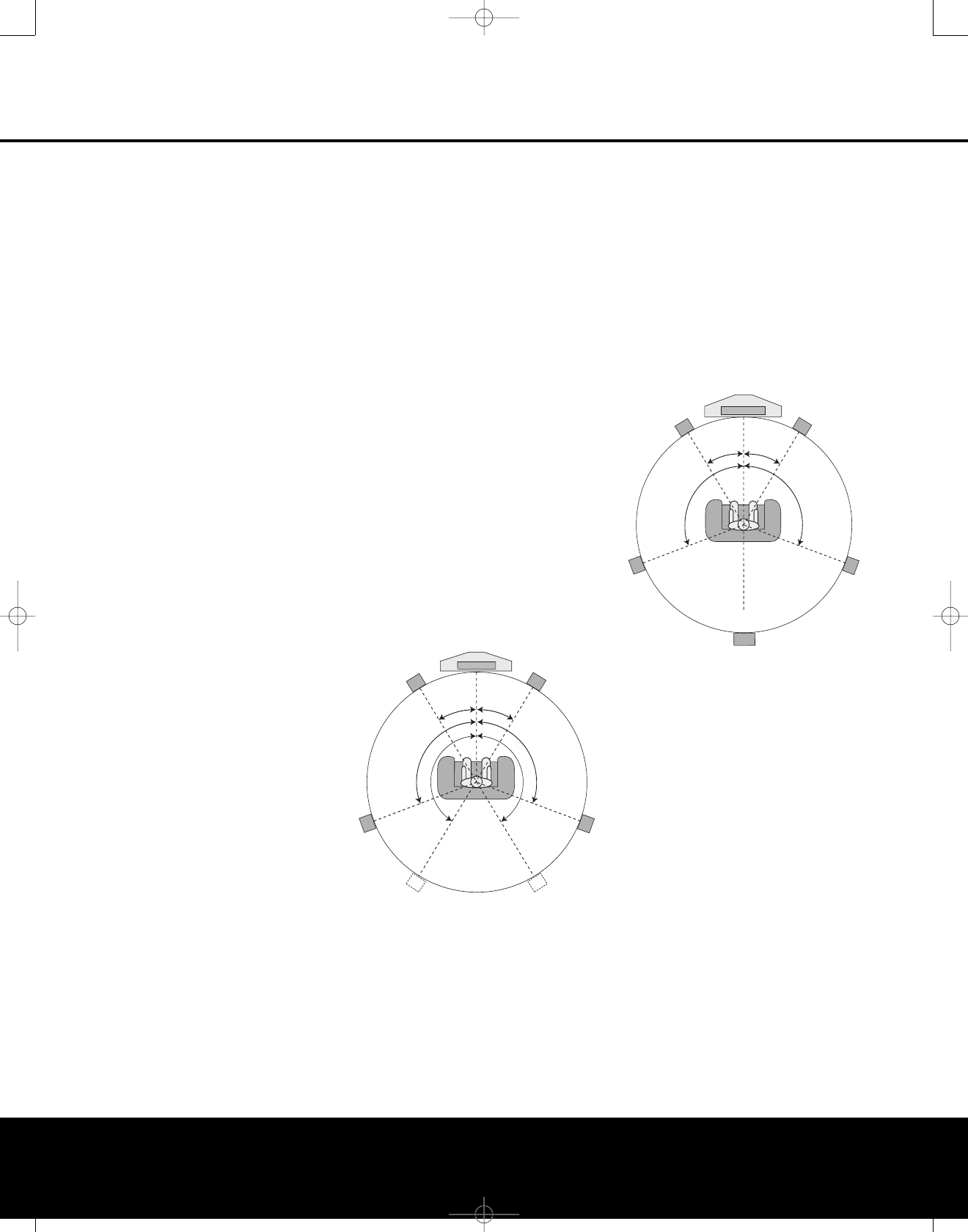
SYSTEM CONFIGURATION
When all audio, video and system connections have
been made, the final steps before listening to your new
AVR are to make the configuration adjustments that
tailor the unit to the other components in your system
as well as accommodate your personal listening pref-
erences. A few minutes spent to correctly calibrate and
configure your system will greatly add to your listening
pleasure.
Speaker Selection and Placement
While the most seamless surround sound reproduction
comes from the use of speakers with identical or care-
fully matched driver elements at each position, no
matter which brand or type of speakers you prefer, it
is always best to use the same model or series for
the left front, center and right front speakers. Similarly,
it is also desirable to use the same model or series
for the surround speakers. This ensures that the sound-
stage will be relatively seamless when a sound moves
from one side of the room to the other.
Speaker Placement
Once you have selected your speakers, it is important
that they be placed in positions that enable them to do
the best job of reproducing the sound as it was meant
to be heard, regardless of the program content. The
placement of speakers can have a noticeable impact
on the accuracy of the surround process, particularly in
multichannel systems.
When placing your speakers in a listening room, pic-
ture an imaginary circle starting at the center of your
video screen that arcs around the room with the prime
listening position, or “sweet spot,” at the center of the
circle. Depending on the number of speakers in your
system, there is a recommended placement along the
circle for each speaker, though the specific construc-
tion of your room, taking into account the available
walls, bookcases, or floor space at which the speakers
may be placed will obviously have some impact on
where the speakers are ultimately located. As a general
rule, try to place all speakers so that they are posi-
tioned at the same height as your ears when you are
seated at the prime listening position.
Use the following suggestions as a guide, and make
the changes needed to fit the speakers to your room.
Don’t be afraid to experiment a bit until you find the
right combination of locations that works for you. At
the end of the day, there is no real “right” or “wrong”
place to put the speakers; work to optimize their loca-
tions so that audio moves across the front of the room
smoothly, without seeming to jump from one speaker
to another.
Front Left/Right Speakers
The recommended placement for front left/right
speakers is at the 30-degree position with reference
to the center channel speaker. The distance between
them should be about the same as the distance from the
center channel speaker to the prime listening position.
Although the natural tendency is to place the speakers
so they are parallel to the wall behind them, and thus
in line with the video screen, the preferred placement
is to angle the speakers slightly (“toe in”) so that they
point at the prime listening position.
Center Channel Speaker
The ideal location for the center channel speaker is at
“0 degrees” in our circle, directly in front of the prime
listening position. Place the center channel speaker as
close to the top (or bottom) of the video screen as
possible so that when you position the front left/right
speakers the tweeters of all three front channel speak-
ers are within 24" of one another.
Surround Speakers for 5.1 Systems
In a 5.1 surround system, an additional pair of
left/right speakers is added. Although many believe
that these speakers should be placed at the rear of
the room, the preferred position for them is at the
sides of the room, with rear placement a second
option when room conditions prevent the use of side-
mounted surround speakers.
When side-wall placement is possible, place the
left/right surround speakers at a point that is 110
degrees along our circle from the center of the video
screen. This translates to placing them to the side and
slightly behind your preferred listening position. If pos-
sible, angle the speakers in slightly so that they are
pointing toward the listener’s ears.
5.1 Placement Diagram
If it is not possible to place the surround speakers at
the sides of the room, the alternate position is at the
back of the room, at a spot that is about 150 degrees
around our circle from the center of the video screen.
Another way to spot the optimal, alternate rear-wall
mounting position is to place the left surround speaker
on the back wall so that it points directly at the front
right speaker,and to have the right surround speaker
point directly at the front left speaker. If possible,
aim the surround speakers so that they point inward,
toward the listening area, rather than perpendicular
to the walls.
Surround Speakers for 6.1 Systems
A 6.1 surround speaker adds an additional center
back surround speaker to the system, enabling you to
enjoy the benefits of advanced surround modes such
as Dolby Digital EX, DTS-ES and Harman Kardon’s
proprietary Logic 7/7.1 processing.
To step up to a 6.1 system, first place the speakers
for a 5.1 system. The “sixth” speaker should ideally be
placed at the center of the room’s rear wall, pointing
directly toward the front center channel speaker.
6.1 Placement Diagram
NOTE: The 6.1-channel configuration is not recom-
mended for the AVR 745. We strongly recommend a
7.1-channel installation as described below. When
6.1-channel materials are played through a 7.1-chan-
nel system, the same surround back channel informa-
tion is played through both the left and right surround
back speakers.
If you are only able to install a single surround back
speaker at this time,you will not be able to run the full
EzSet/EQII 7.2-channel calibration procedure. In that
case, we suggest you install all of your speakers
except the surround back speaker, and run the
EzSet/EQII procedure for a 5.1-channel system (see
page 29). After EzSet/EQII has finished, connect the
single surround back speaker to the left Surround
Back Speaker Outputs B. Then follow the instruc-
tions starting on page 33 to manually configure your
surround back speaker.
We recommend that you consider adding a second
surround back speaker as soon as possible.
Center Speaker
Video Screen
Front Right
Speaker
Front Left
Speaker
Side Surround
Left Speaker
Side Surround
Right Speaker
Back Surround
Speaker
Listening Position
110 ° 110 °
30° 30°
Center Speaker
Video Screen
Front Right
Speaker
Front Left
Speaker
Side Surround
Left Speaker
Alternate placement
for Side Surround
Left Speaker
Side Surround
Right Speaker
Alternate placement
for Side Surround
Right Speaker
110 °
150°
110 °
150°
30° 30°
SYSTEM CONFIGURATION 19
AVR 745 OM 5/15/06 5:00 PM Page 19

SYSTEM CONFIGURATION
20 SYSTEM CONFIGURATION20 SYSTEM CONFIGURATION
Surround Speakers for 7.1 or 7.2 Systems
For the ultimate home theater experience, a 7.1 or
7.2 surround system uses both traditional surround
left/right channels and a surround back left/right
speaker pair. In a 7.1 system, the front left/center/right
speakers remain in the same place as they would be
for a 5.1 or 6.1 system, but due to the number of
speakers involved, the placement of the surround
speakers is different.
In a 7.1 system, you should place the main surround
left/right speakers at the 90-degree point on our cir-
cle. A good way to visualize proper surround speaker
positioning for 7.1 is to place the speakers directly to
the left and right of the ears of someone sitting in the
prime listening spot. The two speakers should ideally
face toward each other.
When two subwoofers are installed, the AVR 745 is
able to create a smoother low-frequency reproduction
with more powerful bass.
The additional Surround Back Left/Right speakers are
placed at about 150 degrees on the circle, pointing
inward, toward the listening area. The easiest way to
visualize the placement of these speakers is to place
the surround back left speaker directly opposite the
right front speaker and to place the surround back left
speaker directly opposite the left front speaker.
7.1 Placement Diagram
Subwoofer Placement
Since subwoofers produce nondirectional sound, they
may be placed almost anywhere in a room. Actual
placement should be based on room size and shape
and the type of subwoofer used. One method of find-
ing the optimal location for a subwoofer is to begin by
placing it in the front of the room, about six inches
from a wall, or near the front corner of the room.
Another method is to temporarily place the subwoofer
at your normal listening position, and then walk
around the room until you find a spot where the sub-
woofer sounds best. Place the subwoofer in that spot.
You should also follow the instructions of the sub-
woofer’s manufacturer, or you may wish to experiment
with the best location for a subwoofer in your listening
room.
The AVR 745 is equipped for 7.2 operation, which
means that you can increase the low-frequency per-
formance of your system by using two subwoofers,
rather than one. When using two subwoofers, the fol-
lowing tips will add to the smoothness and power of
the bass reproduction:
• Although it is not mandatory, you will have the best
performance when both subwoofers are identical in
terms of driver size, amplifier power and cabinet
design (e.g., ported or sealed).
• The optimal placement when two subwoofers are in
use is to have them on the side walls of the room,
to the immediate left and right of the listening posi-
tion. If that positioning is not practical, a good alter-
native is to place the subwoofers in the front left
and right corners of the room, or to place the
subwoofers in any two corners of the room.
• Regardless of which subwoofer placement option is
chosen, EzSet/EQII will help to smooth room condi-
tions to deliver the optimal bass response.
For more information on subwoofer placement, as well
as a variety of topics relating to audio and home the-
ater, visit the Technology section of our Web site at
www.harmankardon.com. Links are provided there to
informative white papers written by the acoustic and
electronics experts at Harman Kardon and at our par-
ent company, Harman International Industries, Inc.
NOTES ON SPEAKER PLACEMENT:
1. The limitations of your listening room, including the
placement of walls and furniture, may make it diffi-
cult to follow the speaker placement suggestions
shown above. Depending on the specific layout of
the room, here are some ways to compensate for
unusual conditions:
• Try to follow the suggested placement, but move
the speakers within a few feet from the preferred
locations.
• Regardless of where they are placed, always try
to make certain that the main surround speakers
are the same distance from the front speakers.
(For example, try not to have the right surround
speaker further back into the room than the left
surround speaker.)
• If it is not possible to wall-mount or place speak-
ers on a shelf, consider the use of optional floor
stands, available for many speakers.
2. When using ceiling-mounted in-wall speakers, fol-
low the same guidelines shown for conventional
floorstanding or shelf-mounted speakers.
3. When you have reassigned the surround back
channels for use in a multiroom system, follow the
speaker placement instructions for a 5.1-channel
system for your main listening area (see page 19).
Remote Control Setup
The AVR 745 comes with two remotes, Harman Kardon’s
TC 30 activity-based remote control with color LCD
and the ZR 10, which is designed primarily for use in
remote rooms but which may also be used as a com-
pact remote in your main home theater room.
The TC 30 remote packed with your new receiver will
operate the AVR 745 without any further program-
ming. However, in order to take full advantage of the
TC 30’s power and flexibility, you will need to program
it via the Internet so that the codes needed to control
the other devices in your system (such as a video dis-
play, DVD players and set-top boxes) are transferred
into the TC 30’s memory. Programming the TC 30
is easy, and complete instructions for setting up the
TC 30 may be found in the separate Installation
Guide for the remote.
Before using the TC 30, you must install the recharge-
able battery and connect the charging cradle to its
power supply. The battery should then be charged for
at least twelve hours before using the TC 30.
To allow you to continue with the setup of your
AVR 745 while the TC 30 battery is charging, the
ZR 10 may be used to navigate through the system
menus. No configuration is required; simply remove
the battery compartment door on the back of the ZR 10
and install the AAA batteries supplied with the AVR.
Replace the battery cover and you are ready to go!
System Setup
Once the speakers have been placed in the room and
connected, the remaining steps in the setup process
are to assign input and output connections, make any
video or audio adjustments, select a surround mode,
program the AVR 745’s bass management system for
the type of speakers used in your system, calibrate
the output levels and set the delay times used by the
surround sound processor.
Although it is necessary to assign input/output settings
and surround mode choices manually,we recommend
that you take advantage of the power and precision of
EzSet/EQII to automatically select and enter the set-
tings for all other audio parameters. This will not only
save you time; it will ensure that your room is calibrated
and equalized with an accuracy not possible when
these settings are made manually.
You are now ready to power up the AVR 745 to begin
these final adjustments.
1. Make certain that the AC power cord is firmly
inserted into the AC Power Cord Jack a
and plug the cord into an unswitched AC outlet.
Center Speaker
Video Screen
Front Right
Speaker
Front Left
Speaker
Side Surround
Left Speaker
Back Surround
Left Speaker
Side Surround
Right Speaker
Back Surround
Right Speaker
90°
150°
90°
150°
30° 30°
AVR 745 OM 5/15/06 5:00 PM Page 20

To maintain the unit’s safety rating, DO NOT
substitute the power cord for one with lower
current capacity.
2. Press the Main Power Switch Alocated
behind the Front-Panel Control Door 9in
until it latches and the word “OFF” on the top of
the switch disappears inside the front panel. Note
that the illumination around the Standby/On
Switch 1will turn amber, indicating that the
unit is in the Standby mode.
3. Carefully remove the protective plastic film from
the front-panel lens. If left in place, the film will
prevent proper operation of the remote control.
4. Turn the AVR 745 on either by pressing the
Standby/On Switch 0on the front panel, by
pressing the AVR Selector
ç
or any button
on the ZR 10 remote that selects an input source
(Input Source Buttons
∂
,Tuner Selector
É
,XM Radio Selector
ƒ
or The Bridge/
DMP Selector
®
), or by pressing the
Devices Button 4on the TC 30 and then
pressing the Screen Button 6at the top of
the left side of the remote, next to the screen
message AV Receiver.The lighting
around the Standby/On Switch 0and the
Volume Control 9will turn blue and the front
panel display will light to confirm that the unit
is on.
Using the On-Screen Display
When making the following adjustments, you may find
it easier to use the AVR 745’s on-screen display sys-
tem. These easy-to-read displays give you a clear pic-
ture of the current status of the unit and make it easy
to see which speaker,delay, input or digital selection
you are making.
To view the on-screen menus, make certain you have
made a video or HDMI connection on the rear panel
to the appropriate matching input of your TV or pro-
jector. In order to view the AVR 745’s displays, the
correct video source must be selected on the
video display.
IMPORTANT NOTE: When viewing the on-screen
menus using a CRT-based projector, plasma display
or direct-view CRT monitor or television, it is important
that they not be left on for an extended period of time.
Prolonged display of a static image such as these menus
may cause the image to be permanently “burned into”
the projection tubes,plasma screen or CRT display.This
type of damage is not covered by the AVR 745 warranty
and may not be covered by the video display’s warranty.
The AVR 745 has two on-screen display modes.
“Full-OSD” displays comprehensive menus of system
options that may be adjusted using the navigation but-
tons on the remote. The “semi-OSD” system displays
two-line messages at the bottom of the screen and is
typically used to make minor adjustments to previously
established settings with discrete function controls on
the remote. We strongly recommend that the full-OSD
system be used for the AVR 745’s initial setup and
configuration, as it contains many system options not
accessible through the discrete function buttons and
semi-OSD messages.
Making Configuration Adjustments
To activate and configure the AVR 745 using the full-
OSD system, either the TC 30 remote or the ZR 10
remote may be used, though you may find the
ZR 10 an easier choice for this purpose.
With the TC 30:
• Press the Devices Button 3.
• When the images on the LCD screen change, press
the Screen Button 6at the top of the left side
of the remote, next to the screen message AV
Receiver.
• Press the Menu Button Ato activate the OSD
menu system.
• When the Master Menu or any subsequent
menu is on the screen, use the ⁄/¤Navigation
Buttons Dto move through the menus or sub-
menus. Press the OK/Enter Button o, when
appropriate, to enter a selection.
• To scroll through the options available for a specific
menu, press the ‹/›Navigation Button D.In
most cases, you may simply select the option and
then use the ⁄/¤Navigation Button Dto
move to the next line, while in some cases you may
need to press the OK/Enter Button ofirst. The
detailed instructions for each menu will tell you
which buttons to press.
• Press the Menu Button Ato remove the menus
from the screen and return to normal operation.
With the ZR 10:
• Press the OSD Button
∫
to activate the menu
system. The MASTER MENU (Figure 1)
will appear.
• Once the MASTER MENU or any subsequent
menu is on the screen, use the ⁄/¤Navigation
Buttons
©
to move through the menus or sub-
menus. Press the Set Button
œ
,when appropri-
ate, to enter a selection.
• To scroll through the available options for a specific
menu, press the ‹/›Navigation Buttons
©
.
In most cases,you may simply select the option and
then use the ⁄/¤Navigation Buttons
©
to
move to the next option, while in some cases you
may need to press the Set Button
œ
first. The
detailed instructions for each menu will tell you
which buttons to press.
Figure 1
The full-OSD menus remain on the screen for twenty
seconds after the last button press, after which they
“time out” and disappear from the screen. The length
of time menus remain on the screen before the time-
out may be increased to as long as fifty seconds by
adjusting the settings for FULL OSD TIME
OUT in the ADVANCED SELECT menu,
as shown on page 50.
In addition to the menu-driven full-OSD system, a
number of settings and adjustments may be made
directly from the TC 30 remote, using the semi-OSD
system. To make adjustments using the semi-OSD,
with the TC 30:
• Press the Devices Button 3.
• When the images in the LCD change, press the
Screen Button 6at the top of the left side of
the remote control, next to the screen message
AV Receiver.
• The screen images will change again. To adjust
a setting on the first page of options, press the
Screen Button 6to the left or right of the item
you wish to change, and then use the ⁄/¤
Navigation Buttons Dto move through the
available settings and option choices. Press the
OK/Enter Button o,when appropriate,to enter
a selection.
• More adjustment options may be accessed by
pressing the Page Left/Right Buttons 8.
When the full-OSD system is in use, the menu selec-
tions are not shown in the Upper or Lower Display
Lines #$ and OSD ON will appear in the
Upper Display Line #to remind you that a video
display must be used. When the semi-OSD system is
used in conjunction with the discrete configuration but-
tons, the on-screen display will show the current menu
selection. That selection will also be shown in the
Upper or Lower Display Lines #$,depending
on which parameter is being adjusted.
NOTE: Semi-OSD messages are not available when a
720p or 1080i image is being viewed.
Setting the System Configuration Memory
The AVR 745 features an advanced memory system
that enables you to establish different configurations
for the component video assignment, digital input and
** MASTER MENU **
IN/OUT SETUP
VIDEO MONITOR SETTINGS
VIDEO SETUP
AUDIO ADJUST
SURROUND SETUP
EZSET/EQ
MULTI-ROOM
ADVANCED
→→
SYSTEM CONFIGURATION 21
SYSTEM CONFIGURATION
AVR 745 OM 5/15/06 5:00 PM Page 21

22 SYSTEM CONFIGURATION
22 SYSTEM CONFIGURATION
surround mode and other settings for each input
source. This flexibility enables you to customize the
way in which you listen to each source and have the
AVR 745 memorize those settings. Once these set-
tings are made, they will automatically be recalled
whenever you select that input.
To simplify initial configuration and operation, the
AVR 745 has been preconfigured with input settings
that are typical for home theater systems. These set-
tings are detailed in the worksheets in the Appendix.
Before adjusting the input settings, it is a good idea to
compare your input connections to the defaults so that
you may see where changes need to be made.
Before using the unit, you may want to change the
settings for some inputs so that they are properly
configured to reflect the use of digital or analog
inputs, the type of video display and speakers
installed, and the surround mode specifics of your
home theater system.
In/Out Setup
The first step is to configure each input source. When
an input is selected,
the settings will “attach” them-
selves to that input and be stored in a nonvolatile
memory. Once made, the selection of an input will
automatically recall those settings. For that reason, the
procedures described below must be repeated for
each input source so that you have the opportunity
to customize each source to your specific listening
requirements. However, once done, they need not
be changed again unless your system components
have changed.
When using the full-OSD system to make the setup
adjustments, press the Menu Button Aor OSD
Button
∫
once so that the MASTER MENU
(Figure 1) appears. The cursor will be next to the
IN/OUT SETUP line. Press the On/Enter
Button Eor the Set Button
œ
and the first
page of the IN/OUT SETUP menu (Figure 2)
will appear on the screen. Press the ‹/›Navigation
Button D
©
until the desired input name appears
in the highlighted video, as well as being indicated in
the front-panel Input Indicators !.
Figure 2
When one of the four Video inputs is selected as the
source, you have the option of renaming the input as it
appears in the on-screen and front-panel messages.
This is helpful if you have more than one VCR, if you
wish to associate a specific product brand name with
the input, or to simply enter any name that will help
you to remember which source is being selected.
To change the input name, press the ⁄/¤
Navigation Buttons D
©
on the remote so that
the cursor is pointing to TITLE. Next, press and
hold the Set Button
œ
for a few seconds until
a flashing box appears to the right of the colon.
Immediately release the On/Enter Button Eor
the Set Button
œ
, as you are now ready to enter
the device name.
Press the ⁄/¤Navigation Buttons D
©
and
note that alphanumeric characters will appear with
the start of the alphabet in capital letters, followed by
the lowercase letters, and then numbers and symbols.
When you press the ¤Navigation Button D
©
, the symbols and numbers will appear first, fol-
lowed by a reverse list of the alphabet in lowercase
letters. Press the button either way until the first letter
of the desired name appears. If you wish to enter a
blank space as the first character, press the ›
Navigation Button D
©
.
When the desired character appears, press the ›
Navigation Button D
©
and repeat the process
for the next letter, and continue until the desired name
is entered, up to a maximum of 14 characters. Press
the On/Enter Button Eor the Set Button
œ
to
enter the input name into the system memory and to
proceed with the configuration process.
After entering the input title, press the ⁄/¤
Navigation Buttons D
©
to move to the
next line.
The audio input defaults for all sources except the
Tuner, USB and 6/8-Channel Direct inputs are shown
in the table in the Appendix. If your system configura-
tion follows the default table, no changes are needed
and you may press the ⁄/¤Navigation Buttons
D
©
to move to the next line.
With the cursor pointing to AUDIO IN-PORT,
press the ‹/›Navigation Buttons D
©
to
change the default to a different audio input connec-
tion. When the name of the desired input appears,
press the ⁄/¤Navigation Buttons D
©
to
move to the next line.
Note that in addition to using the menu system to
change the audio input, you may change it at any time
with the TC 30 remote by following these steps:
• Press the Devices Button 3.
• When the images in the LCD change, press the
Screen Button 6at the top of the left side
of the remote, next to the screen message
AV
Receiver.
• At the next screen, press the Screen Button 6
to the left of the message Setup Menu.
• When the new list of options appears, press the
Screen Button 6to the right of Digital Input.
The current digital input name will begin to flash in
the Upper Display Line C.
• Press the ‹/›Navigation Buttons Duntil the
desired input name appears on the right side of
the Upper Display Line Cor in the semi-OSD
message.
• After five seconds, the input name will stop flashing,
as it is entered into the system memory and the unit
will return to normal operation.
In normal operation, when a digital audio stream is
interrupted, the unit will automatically switch to the
analog inputs associated with that source. This is par-
ticularly useful with cable set-top boxes where the
input is normally digital, but occasionally changes to
analog. If you wish to configure an input so that the
auto-poll circuit is turned off, while the on-screen cur-
sor is pointing to the AUDIO AUTO POLL
line, simply press the ‹/›Navigation Buttons
D
©
so that OFF (rather than ON) is in a white
video highlight.
When the desired auto-poll setting is entered, press
the ⁄/¤Navigation Button D
©
to move to
the next line.
When the cursor is at the VIDEO IN-PORT
line, you are able to select an alternative to the default
input setting for the video input associated with any
source. For the Video 1 and Video 4 inputs, the factory
default of AUTO will select either composite or S-
video, depending on which has an active signal. For
the Video 2, Video 3 and DVD inputs, the AUTO
setting will normally select the default component
input, but if it is not in use, the system will revert to a
composite or S-video output if either one is active.
To have the AVR always look to a specific source con-
nection when an input is selected, make certain that
the on-screen cursor is pointing to the VIDEO
IN-PORT line, and then press the ‹/›
Navigation Buttons D
©
until the name of the
desired input appears. The default setting for HDMI
inputs is AUTO and normally need not be changed.
However, in systems where the HDMI connection is
used for multichannel audio only (e.g., HDMI 1.1), but
the video connection is component, due to limitations
on the video display, the setting here should be
changed to COMPONENT.
When the desired video input setting has been made,
press the ⁄/¤Navigation Buttons D
©
to
move to the next line.
If your system includes any sources that are equipped
with Y/Pr/Pb component video outputs, the AVR 745
is able to switch them to send the proper signals to
your video display. Each of the Component Video
Inputs Qis assigned to a default source,as shown
in the table in the Appendix, but if you have connected
* IN/OUT SETUP *
SOURCE: VIDEO 1
TITLE:
AUDIO IN-PORT: ANALOG
AUDIO AUTO POLL: ON OFF
VIDEO IN-PORT: AUTO
COMPONENT INPUT: COMP 1
VIDEO PROCESS: FAROUDJA
A/V SYNC DLAY: 0mS
MASTER MENU PAGE 2
→
SYSTEM CONFIGURATION
AVR 745 OM 5/15/06 5:00 PM Page 22

SYSTEM CONFIGURATION
your system differently than the factory settings, you
may select any of the three inputs for any source
except the HDMI inputs or the Tuner. If you do not
need to change these defaults, press the ¤
Navigation Button oto go to the next setting.
To change the Component Video assignment, first
make certain that the cursor is pointing to the
COMPONENT INPUT line on the menu
screen, and then press the ‹/›Navigation Button
D
©
until you see the desired input in the high-
lighted video.
When the desired component input has been selected,
press the ¤Navigation Button D
©
to go to
the next setting.
At the VIDEO PROCESS line, you are able to
select which type of video processing or conversion, if
any, is to be used with the input source being config-
ured. The default setting is to have the AVR 745’s
Faroudja processing circuitry in use, which will deliver
the best image quality when a digital video display is in
use. If you do not need to change the setting, simply
press the ⁄/¤Navigation Buttons D
©
to
move to the next line.
If your video display is not capable of accepting high-
resolution (480p and above) signals through either
an HDMI or component video connection, it is very
important that this setting be changed. Three options
are available:
The default setting is FAROUDJA.Depending on
the input source, the video signals will be handled in
different ways:
• A standard-definition (480i) analog signal (compos-
ite, S-video or component) will be digitized and sent
to the Faroudja video processor for enhancement.
The signal will be available as both an analog
component and HDMI signal. The standard
definition video signal will also be available at the
record outputs.
• An analog component high-definition signal will be
digitized and sent to the Faroudja video processor
for enhancement. The signal will be available as
both an analog component and an HDMI signal, but
not at the analog composite or S-video monitor or
record outputs.
• Any HDMI signal other than 1080i will be sent to
the Faroudja video processor for enhancement and
it will be available as an output at both the HDMI
and analog component outputs. Program material
that carries HDCP copy protection encoding will only
be available through the HDMI output.
• HDMI signals in 1080i resolution will be sent directly
to the HDMI and analog component outputs without
processing. Program material that carries HDCP
copy protection encoding will only be available
through the HDMI output.
The V-CONVERSION setting will not apply
any video enhancement or processing to the incoming
video signal, but it will output it in one of the following
ways, depending on the input source.
• A standard-definition (480i) analog signal (compos-
ite, S-video or component) will be converted so that
it is available as an HDMI signal at its input resolu-
tion, as well as at the standard composite, S-video
or component analog video outputs. The signal will
also be available at the record outputs.
• An analog component high-definition signal will be
digitized and output at its input resolution through
the HDMI outputs and as an analog component
signal, but not through the analog composite or
S-video monitor or record outputs.
• HDMI input signals, regardless of their resolution, will
be output through both the HDMI and analog com-
ponent outputs. Program material that carries HDCP
copy protection encoding will only be available
through the HDMI output.
The BYPASS setting will not apply any video
enhancement or processing to the incoming video sig-
nal, but it will output it in one of the following ways,
depending on the input source.
• Analog signals (composite, S-video or component)
will output only in the resolution and format that
matches the input for both the main “Monitor” con-
nection as well as for the record outputs.
• HDMI input signals, regardless of their resolution, will
be output through the HDMI and analog component
outputs. Program material that carries HDCP copy
protection encoding will only be available through
the HDMI output.
In addition to the changes to the video processing
configuration that are made through the IN/OUT
SETUP menu, you may change the setting for an
input at any time by pressing the ‹/›Buttons H
on the front panel to cycle through the available
choices.
When any needed change to the video processing
setting has been made, press the ⁄/¤Navigation
Buttons D
©
to move to the next line.
At the A/V SYNC DELAY line, you are able to
enter a setting that delays the audio output slightly
behind the video so that the loss of lip sync that may
occur due to digital video processing in the transmis-
sion of a program, in the playback unit or in the dis-
play is corrected. This lack of lip sync is not a fault of
the sources; rather, it is a by-product of video signal
processing. In most cases, we recommend that the
delay adjustment be made using the direct-access
controls on the remote so that you may more accu-
rately adjust the delay while viewing the on-screen
image, following the instructions shown on page 36,
but you may also make it here using the menu sys-
tem. As the amount of delay needed may vary from
one source to another, we strongly recommend that
you adjust it for each input.
To adjust the A/V sync delay time from the
IN/OUT SETUP menu, make certain that the
cursor is pointing to the A/V SYNC DELAY
line, and then press the ‹/›Navigation Buttons
D
©
until the desired amount of delay is applied
so that the on-screen video matches the audio.
When all configuration adjustments on this menu
screen have been made, press the ⁄/¤Navigation
Buttons D
©
until the on-screen cursor is point-
ing to PAGE 2and then press the OK/Enter
Button Eon the TC 30 or the Set Button
œ
on the ZR 10 remote to move to the second screen
of input/output settings. If all settings for input configu-
ration are complete, press the ⁄/¤Navigation
Buttons D
©
until the on-screen cursor is point-
ing to MASTER MENU and then press the Set
Button
œ
on the ZR 10 remote to return to the
main menu screen.
The second page of the IN/OUT SETUP
menu (Figure 3) allows you to further configure the
AVR 745 for special custom features.
Figure 3
The TRIGGER 2 line enables you to choose
whether a trigger voltage signal is sent to the Trigger
2 Output Jack Iwhen a specific input is selected.
Unlike the Trigger 1 Output H, which always has a
trigger voltage present when the AVR 745 is turned
on, the default for the Trigger 2 connection is off. The
setting on this menu line allows you to turn it on for a
specific input so that an input or source-dependent
accessory (such as a motorized projection screen or
blinds) may only be activated when, for example, an
input which requires a projection screen or darkened
room is selected.
To change the setting, press the ‹/›Navigation
Buttons D
©
until the desired setting appears.
Press the ⁄/¤Navigation Buttons D
©
to
move to the next line when the setting is correct or if
no configuration changes are required.
The front-panel analog Video 4 Jacks Nare nor-
mally set as inputs for use with camcorders, video
games and other portable audio/video products,but
they may be switched to outputs. First, make certain
that you are at the IN/OUT SETUP menu.
* IN/OUT SETUP *
TRIGGER 2 :OFF ON
VIDEO 4 :IN OUT
COAXIAL 4 :IN OUT
REC OUT :ANALOG
MASTER MENU PAGE 1
➔
SYSTEM CONFIGURATION 23SYSTEM CONFIGURATION 23
AVR 745 OM 5/15/06 5:00 PM Page 23

24 SYSTEM CONFIGURATION24 SYSTEM CONFIGURATION
Press the ¤Navigation Buttons D
©
until the
cursor is pointing to the VIDEO 4 line. Press the
‹/›Navigation Buttons D
©
so that the word
OUT is highlighted. The Input/Output Status
Indicator Lbetween the S- and composite video
jacks will turn red, indicating that the analog Video 4
jacks are now record outputs.
Selection of the front-panel jacks as outputs will
remain effective as long as the AVR 745 is on. Once
the unit is turned off, the jacks will revert to their nor-
mal use as inputs when the unit is turned on again.
An exclusive Harman Kardon feature is the ability to
switch the front-panel coaxial digital audio and analog
audio/video jacks from their normal use as inputs to
output connections so that portable recording devices
may easily be connected. On the AVR 745, the
Coaxial 4 Digital Jack Mis normally an input, but it
may be switched to a digital output for use with digital
recorders. To change the jack to an output, press the
⁄/¤Navigation Buttons D
©
while the
IN/OUT SETUP menu is on screen until the
cursor is next to COAXIAL 4.Then press the
‹/›Navigation Buttons D
©
so that OUT is
highlighted. The Input/Output Status Indicator L
will then turn red, indicating that the jack is now a
record output.
NOTE: A signal will be sent to this jack only when the
input selected for use by the AVR 745 is digital. Digital
signals will be passed through, regardless of their for-
mat, and which digital input (optical or coax) they are
fed from. Analog signals are not converted to digital,
and their format (e.g., PCM, Dolby Digital or DTS) may
not be changed.
The REC OUT line enables you to select what
the audio output is at the analog record outputs for
the input source being configured. Press the ‹/›
Navigation Buttons D
©
to choose one of the
following if you wish to change the default setting:
•ANALOG selects an unprocessed pass-through
of an analog source and is the default setting for
most inputs.
• DSP DOWNMIX selects a two-channel down-
mix of a multichannel digital input.
When the adjustment has been made, or if no adjust-
ment is required and all settings on this page are
complete, press the ⁄/¤Navigation Buttons
D
©
until the on-screen cursor is pointing to
PAGE 1 and then press the OK/Enter Button
Eon the TC 30 or the Set Button
œ
on the
ZR 10 remote to return to the main IN/OUT
SETUP menu to configure another input, or if no
further input configuration adjustments are needed,
press the ⁄/¤Navigation Buttons D
©
until the on-screen cursor is pointing to MASTER
MENU and then press the OK/Enter Button E
on the TC 30 or the Set Button
œ
on the ZR 10
remote to return to the main menu screen.
Video Monitor Settings
The VIDEO MONITOR SETTINGS
menu (Figure 4) is unique in that it contains a mix of
information display lines that detail status information
about the AVR 745’s video system settings, along
with a few lines where a specific parameter may be
changed. With the MASTER MENU on the
screen, press the ⁄/¤Navigation Buttons D
©
until the on-screen cursor is pointing to
VIDEO MONITOR SETTINGS and
then press the OK/Enter Button Eon the TC 30
or the Set Button
œ
on the ZR 10 remote to
move to the menu screen.
Figure 4
The IN VIDEO FORMAT line is an informa-
tional display of the resolution of the incoming video
stream, and may not be adjusted.
The IN VIDEO COPY PROT line is an
informational display that shows whether or not an
incoming video signal contains copy protection
encoding, and may not be adjusted.
The VIDEO PROCESS line is an
informational display of the setting made in the
IN/OUT SETUP menu indicating how
incoming video is processed for the input being
viewed, and may not be adjusted.
The OUT VIDEO FORMAT line is a non-
adjustable informational display of the video resolution
of the output signal, as determined by the input and
whether or not video processing or conversion is in use.
The COMPONENT OUT line is an informational
display of whether or not the Composite Video outputs
are ENABLED or OFF,based on the input sig-
nal type and resolution, and whether or not the incom-
ing video signal has HDCP content protection. It may
not be adjusted.
The S-VIDEO OUT line is an informational dis-
play of whether or not the S-video outputs are avail-
able at a 480i resolution (or OFF), based on the
input signal type and resolution and whether or not the
incoming video signal has HDCP content protection.
It may not be adjusted.
The DISPLAY INTER line allows you to
choose between an ANALOG video output default
value and an HDMI/DVI output by pressing the
‹/›Navigation Buttons D
©
to make the
desired selection. When the setting is ANALOG,
the HDMI output is placed in a Standby mode so that
it automatically switches to HDMI when an HDMI signal
is detected. If a high-definition input source is not
HDCP-content-protected, it may be output through the
component jacks; otherwise, it will be sent only to the
HDMI outputs. The HDMI/DVI setting routes all
converted or processed video to the HDMI outputs.
The HDMI AUDIO OUT line allows you to
choose whether a two-channel downmix of the audio
that accompanies the selected source is sent over
the HDMI connection (YES) at the maximum bit rate
the display’s audio system is capable of handling, or
not (NO). To change the setting, press the ‹/›
Navigation Buttons D
©
to make the desired
selection.
When required adjustments have been made for this
input, or if no adjustment is required, press the ⁄/¤
Navigation Buttons D
©
until the on-screen
cursor is pointing to BACK TO MASTER
MENU and then press the OK/Enter Button E
on the TC 30 or the Set Button
œ
on the ZR 10
remote to return to the main menu screen.
Video Setup
The AVR 745 is among the very few audio/video
receivers that include an onboard video processing
system using DCDi by Faroudja technology. It is unique
in that it also allows the video controls to be individually
set for each video input source. This permits you to
compensate for the problems inherent in older tech-
nologies such as VCR while taking the maximum
advantage of new source options such as DVD,
digital cable and satellite programming.
IMPORTANT NOTE: The video processing is only
available when the AVR 745 is connected to a “digital-
ready” or HDTV video display that is able to accom-
modate input sources of 480p or greater via an ana-
log component or HDMI connection. If your video dis-
play does not have that capability,you may skip the
settings in this section, as they will not apply to your
home theater system.
Within the VIDEO MAIN menu are the settings
that define the input and establish the global settings
for the video output. The two video ADVANCED
CONFIGURATION submenus contain the
individual parameters that will be applied to the specific
video input in use. Before proceeding with the setup,
we suggest that you look at the default settings for
each input, which are listed in the appendix to this
manual. If the settings for any input mirror the configu-
ration of your home theater system, then no further
adjustment is needed.
It is worth noting that the impact of many of the indi-
vidual settings is subtle, and it is only when they are
grouped together that the full power of the video pro-
cessing system is unleashed. That means that there is
*VIDEO MONITOR SETTINGS*
IN VIDEO FORMAT: 1080i
IN VIDEO COPY PROT: ON
VIDEO PROCESS: FAROUDJA
OUT VIDEO FORMAT: 1080i
COMPONENT OUT: OFF
S-VIDEO OUT: OFF
COMPOSITE OUT: OFF
DISPLAY INTER: HDMI/DVI
HDMI AUDIO OUT: NO
BACK TO MASTER MENU
➔
➔
SYSTEM CONFIGURATION
AVR 745 OM 5/15/06 5:00 PM Page 24

SYSTEM CONFIGURATION
no “right” or “wrong” setting in many cases, and the
setting that looks best to your eyes is the one that is
truly correct for your specific combination of equip-
ment, room environment and your own personal view-
ing preferences. Feel free to experiment with different
setting combinations, as you can't “hurt” anything by
doing so.
When you do reach the combination of settings for
both your display system and each input, it is a good
idea to write those settings down using the worksheets
found on pages 55 – 57. (A copy of the blank work-
sheets may also be found in the support section our
Web site at www.harmankardon.com/support.)
To reach the VIDEO MAIN menu, first make
sure the MASTER MENU is on the screen, and
then press the ‹/›Navigation Buttons D
©
until the on-screen cursor is pointing to VIDEO
SETUP and then press the OK/Enter Button E
on the TC 30 or the Set Button
œ
on the ZR 10
remote. The VIDEO MAIN menu (Figure 5) will
appear on the screen.
Figure 5
Once the first VIDEO MAIN menu is displayed
with the on-screen cursor pointing to SOURCE,
press the ‹/›Navigation Buttons D
©
until
the name of the input you wish to change the settings
for is shown. At the same time,any video input name
previously changed to individualize the source setting
will be shown on the TITLE line. To change the
title, go back to the IN/OUT SETUP menu.
Once the source to be adjusted has been selected,
press the ⁄/¤Navigation Buttons D
©
until
the on-screen cursor is pointing to SOURCE
TYPE as the two lines below the TITLE line
are informational only,and their setting may not be
adjusted in this menu.
• The VIDEO IN-PORT line shows the video
input jacks used for this input. If AUTO has been
selected, the display will alternate between AUTO
and the actual active input.
• The VIDEO PROCESS line shows whether
the system is in the Bypass, Video Conversion or
Faroudja video processing mode. Note that the
FAROUDJA setting must be enabled for the input
being adjusted through the IN/OUT MENU
in order for the settings available on this menu and
the ADVANCED CONFIGURATION
menus to be active.
Once an input is selected, the first configuration choice
is to tell the AVR 745 what type of device is being
used for that source. To change this setting from the
system default, press the ¤Navigation Button
D
©
so that the on-screen cursor is pointing
to SOURCE TYPE and then press the ‹/›
Navigation Buttons D
©
to select, from among
the options shown, one that is closest to the type of
product connected to that input. The selection made
will change the settings on the ADVANCED
CONFIGURATION SUB-MENUS to
those best suited to that type of device. Of course, you
may also change these settings yourself at any time
through the submenus.
The list of input source defaults is:
DVD: This setting is optimized for use with the
output signal of a typical DVD player.
VCR: This setting is optimized for use with the
output signal of an analog videocassette recorder.
CABLE DIG: This setting is optimized for
use with digital cable set-top boxes. However, it is
important to note that even when a digital cable
system is in use, there may be a mix of digital and
analog channels. We recommend that you start with
this setting and then change the options in the
ADVANCED CONFIGURATION
menus as needed, to tailor the output to your
preferences.
SAT DIG: This setting is optimized for use
with digital satellite-system set-top boxes.
CABLE ANA: This setting is optimized for
use with analog cable set-top boxes.
SAT ANA: This setting is optimized for use
with analog satellite-system set-top boxes.
CAMERA ANA: This setting is optimized for
use with analog VCRs and camcorders.
CAMERA DIG: This setting is optimized for
use with digital camcorders or still-image cameras.
The DISPLAY TYPE line is a global, rather
than input-dependent setting, as there is only one dis-
play connected to the AVR. The settings here are pri-
marily changes to the video enhancement level and
aspect ratio for a specific type of device, and defaults
were selected after testing on a wide range of
brands. To change this setting, press the
¤Navigation Button D
©
so that the on-
screen cursor is pointing to DISPLAY TYPE
and then press the ‹/›Navigation Buttons D
©
to select, from among the options shown, one
that is closest to the type of display being used. The
selection will change the settings on the
ADVANCED CONFIGURATION
SUB-MENUS to the parameters best suited to
that type of display. Of course, you may also change
these settings yourself at any time, through the sub-
menus. The list of input source defaults is:
CRT: This setting is optimized for use with dis-
plays that use cathode ray tubes (CRTs) to display
images. For the purposes of this setting, it does not
matter whether the display is a single tube, direct-
view CRT TV or a three-tube front or rear projector.
The default aspect ratio is 4:3, but you may change
that setting, if desired, on the second page of the
Advanced Configuration
submenus, as shown on page 27.
REAR PROJECT: This setting is optimized
for rear projectors,regardless of the imaging tech-
nology used.
FRONT PROJECT: This setting is opti-
mized for front projectors, regardless of the imaging
technology used.
PLASMA: This setting is optimized for plasma
displays, regardless of whether they are true high-
definition or “ED” displays that are HD-compatible.
DLP: This setting is optimized for use with pro-
jectors that use light engines with Texas Instruments’
DLP®technology. For the purposes of this setting,
it does not matter whether the display uses one or
three chips, or whether the display is front or rear
projection.
LCD: This setting is optimized for use with dis-
plays that use liquid crystal display (LCD) technology.
For the purposes of this setting, it does not matter
whether the display is a direct-view LCD flat panel,
or front or rear projector.
The ENHANCE LEVEL setting adjusts the
degree to which the enhancement circuits that adjust
the high-frequency content of the signal are applied.
This is similar to the "Sharpness" control on a tradi-
tional television. This setting acts on the vertical and
horizontal as well as the luminance and chrominance
signals to offer what will appear as enhanced depth in
the picture as well as greater small object detail. In
general, lower settings are applicable for digital dis-
plays and sources, while higher settings may be pre-
ferred for CRT-based displays and digital sources.
If you wish to change the default setting to suit your
specific display type, input sources and personal
image preferences, when the VIDEO MAIN
menu is on the screen, press the ¤Navigation
Button D
©
so that the on-screen cursor is
pointing to ENHANCE LEVEL and then press
the ‹/›Navigation Buttons D
©
to enter the
setting that delivers the best image to your eyes on
the scale of 0 to 100.
After any changes to the ENHANCE LEVEL
line have been made,press the ⁄/¤Navigation
Buttons D
©
so that the on-screen cursor is
pointing to the PICT ADJUST line. At this
** VIDEO MAIN **
SOURCE :VIDEO 1
TITLE :
VIDEO IN-PORT :AUTO
VIDEO PROCESS :FAROUDJA
SOURCE TYPE :VCR
DISPLAY TYPE :CRT
ENHANCE LEVEL :32
PICT ADJUST :ORIGINAL
ADVANCED CONFIG SET
BACK TO MASTER MENU
→→
SYSTEM CONFIGURATION 25SYSTEM CONFIGURATION 25
AVR 745 OM 5/15/06 5:00 PM Page 25

26 SYSTEM CONFIGURATION26 SYSTEM CONFIGURATION
line, you are able to change the setting for the output
aspect ratio. In most cases, the default setting of
ORIGINAL provides the best result, but if the
combination of program material, input source device
capabilities and the adjustments available on your
video display do not provide the desired picture for-
mat, press the ⁄/¤Navigation Buttons D
©
to experiment with the six available options.
• ADJUST 1 will stretch a 4:3 letterbox input
vertically so that it fills a 16:9 screen.
• ADJUST 2 will apply a nonlinear horizontal
stretch of a full-screen 4:3 input to a 16:9 screen.
When this option is chosen, objects will appear to
be a bit “fatter,” due to the stretch.
• ADJUST 3will process a 2.35:1 image that is
formatted with a 4:3 letterbox and vertically stretch
it to fill a 16:9 screen, but it will also crop the left
and right sides of the image.
• ADJUST 4 will process a 2.35:1 image that is
formatted with a 4:3 letterbox and vertically stretch
it to fill a 16:9 screen, with nonlinear horizontal
processing so that the full image appears on the
screen. To accomplish this, you will find that objects
on the far left and right sides of the screen may
appear to be “skinnier” than normal.
• ADJUST 5 will apply a stretch to fit 4:3 full-
screen images to fill a 16:9 screen.
• ADJUST 6 is an automatic mode that will apply
the processing from ADJUST 3 to a letterbox
input or ADJUST 2 to a full-screen 4:3 input.
Once settings are made on the VIDEO MAIN
menu, you may either return to the MASTER MENU
or proceed to either of the two ADVANCED
CONFIGURATION setting menus. The
options on those pages are set by your choice on the
SOURCE TYPE line, but you may change one
or more of the settings to customize your video pres-
entation. To return to the MAIN MENU, press the
⁄/¤Navigation Buttons D
©
so that the on-
screen cursor is pointing to BACK TO MAS-
TER MENU and press the OK/Enter Button E
or the Set Button
œ
.To change the
settings on the
ADVANCED CONFIGURATION
menus, press
the ⁄/¤Navigation Button D
©
so that the
on-screen cursor is pointing to ADVANCED
CONFIG SET and press the OK/Enter Button
Eor the Set Button
q. The first page of the
ADVANCED
CONFIGURATION menus
(Figure 6) will appear on screen.
Advanced Configuration Settings
The Advanced Configuration Settings may be used to
change the individual items that make up the default
profile for each video input. You may change none,
one or as many of the settings as you wish, to create
the on-screen image that you prefer. As with all of the
video settings, you can't "hurt" anything by experi-
menting with the settings, and while the defaults repre-
sent the result of extensive lab testing with a variety of
display types, input sources and test signals, there is
no "right" or "wrong" setting other than the ones that
look best to you.
The settings that are available on PAGE 1 of the
ADVANCED CONFIGURATION menus
(Figure 6) are all On/Off settings. On that page, use
the ⁄/¤Navigation Buttons D
©
to move
the on-screen cursor next to the line for the setting
you wish to change. Then, press the ‹/›Navigation
Buttons D
©
to turn the setting on or off.
Figure 6
These settings are available on PAGE 1 of the
ADVANCED CONFIGURATION menu:
NOISE REDUCTION: When this setting
is turned on, there is a reduction in the video noise
that is often present in analog input sources.
X-COLOR SUPPRESSOR: When this
setting is on, there is a reduction in the cross-color
interference that typically appears in composite
video sources as moiré in finely detailed objects.
DCDi INTERPOLATION: DCDi
stands for Directional Correlation De-interlacing, and
it is a Faroudja technology that examines each pixel
for the optimal direction from which to interpolate
the video information, with regard to local edges.
This adaptive process prevents the appearance of
staircasing and the jagged edges that are often
visible with other means of de-interlacing.
FILM MODE DETECT: When this setting
is on, special circuits are used to detect the pres-
ence of film-originated material so that the original
film-frame sequence may be recovered by weaving
together the appropriate video fields.
FILM MODE EDIT DETECT: When
this setting is on, additional processing is applied
when film-based material is detected so that any
disruption in the frame sequence of film-based
material due to video edits or the overlay of video
text over film is compensated for by processing,
before artifacts such as feathering may appear.
FLESHTONE NOISE REDUCTION:
When this setting is on, the processing is adapted
to preserve the detail in faces and flesh tones while
reducing noise in the total picture.
COMPONENT VIDEO ENHANCE:
When this setting is on, component video signals
are processed to adjust the high-frequency content
of the signal to offer enhanced depth in the picture,
as well as greater small object detail.
When all settings on this submenu page that require
adjustment have been made, use the ⁄/¤
Navigation Buttons D
©
to move the on-
screen cursor next to PAGE 2 and then press
the OK/Enter Button Eor the Set Button
œ
to move to the next page of the ADVANCED
CONFIGURATION settings, or move the on-
screen cursor next to the TO VIDEO MAIN
line to return to the VIDEO MAIN menu.
Figure 7
These settings are available on PAGE 2 of the
ADVANCED CONFIGURATION menu
(Figure 7):
TEST VIDEO: The test signals that are
called up on this line are designed for use in factory
setup of the AVR 745’s video processing circuit and
they are not designed for user adjustment of any
controls on your video sources, on your video dis-
play or on the AVR 745 itself. You may bypass this
setting line unless you wish to view the signals, but
remember that they are not designed for any con-
sumer use.
To view the test signals, with the on-screen cursor
next to the TEST VIDEO line, press the ‹/›
Navigation Buttons D
©
to select one of the
test signals described below, and then press the
OK/Enter Button Eor the Set Button
œ
to
activate the test signal. The test signal will remain on
the screen for the length of time selected in the
ADVANCED SETTINGS menu for the
on-screen menus, as explained on page 50. The
four test signals are:
Color Bars: These are a variation of
traditional split-field color bars used to check the
internal settings for luminance/chrominance volt-
age levels with respect to the eight basic colors.
*ADVANCED CONFIG PAGE2*
TEST VIDEO :OFF
OUT ASPECT RATIO :4:3
BRIGHTNESS :100
CONTRAST :100
SATURATION :100
TO VIDEO MAIN PAGE1
→→
*ADVANCED CONFIG PAGE1*
NOISE REDUCTION :ON
X-COLOR SUPPRESSOR :ON
DCDi INTERPOLATION :ON
FILM MODE DETECT :ON
FILM MODE EDIT DET :ON
FLESHTONE NOIS RED :ON
COMPNT VIDEO ENHANCE:ON
TO VIDEO MAIN PAGE2
→→
SYSTEM CONFIGURATION
AVR 745 OM 5/15/06 5:00 PM Page 26

SYSTEM CONFIGURATION
Triangle Fixed: This test signal
puts two opposing triangles on screen, with a black
triangle on the right and a white triangle on the left,
to test aspects of the pull-down logic software.
Triangle Flashing: This test
signal also puts two opposing black and white
triangles on the screen, but it flashes them at a
high frame rate, to test the 3/2 pull-down edit
detection and other aspects of the processor and
interpolation software.
Ramp/Square: This complex pattern
uses a variety of fixed and pulsating gray-scale
tests to test different aspects of the 3/2 pull-
down edit detection and other aspects of the
processor and interpolation software.
The OUT ASPECT RATIO line sets the
aspect ratio for the input source currently being adjusted.
To make a change from the default setting, press the
‹/›Navigation Buttons D
©
. Remember that
this setting impacts the actual playback only. The on-
screen menus will always be output as a 4:3 signal,
though they may be stretched to 16:9 by a setting
available in your video display.
BRIGHTNESS: The changes to this setting
are similar to the Brightness control on your display,
changing the video level. If circumstances are such
that a source has a low signal and appears dark,
you may wish to change this setting, but be careful
not to increase it to the point where the video dis-
play is over-driven into clipping or blooming.
CONTRAST: The changes to this setting are
similar to the Contrast control on your display,
changing the black level to compensate for poor
contrast.
SATURATION: The changes to this setting
are similar to the Color control on your display,and
may be used as needed to compensate for over- or
under-color-saturation.
When all settings on this submenu page that require
adjustment have been made, use the ⁄/¤
Navigation Buttons D
©
to move the on-
screen cursor next to PAGE 1 and then press
the OK/Enter Button Eor the Set Button
œ
to return to the previous ADVANCED
CONFIGURATION settings page, or point
the on-screen cursor at TO VIDEO MAIN to
return to the VIDEO MAIN menu.
Audio Setup
This menu allows you to configure the tone controls.
If you do not wish to change any of those settings at
this time, proceed to the next menu screen. To make
configuration changes to those parameters, first make
certain that the MASTER MENU is on screen
with the cursor pointing to the AUDIO SETUP
line, and press the OK/Enter Button Eor the Set
Button
œ
. The AUDIO SETUP menu
(Figure 8) will appear.
Figure 8
The first line controls whether or not the bass/treble
tone controls are in the signal path. The normal default
is for them to be in-line, but if you wish to remove
them from the circuit for “flat” response, first make
certain that the cursor is pointing to the TONE line
on the menu and press the ‹/›Navigation
Buttons D
©
so that OUT is highlighted.
If you wish to leave the tone controls in the signal
path, the amount off boost or cut for bass and treble
may be adjusted up to ±12dB in 2dB steps by press-
ing the ⁄/¤Navigation Buttons D
©
so
that the cursor is next to BASS or TREBLE,
depending on which setting you wish to adjust. Next,
press the ‹/›Navigation Buttons ountil the
desired setting is shown.
When all desired changes have been made on this
menu, press the ⁄/¤Navigation Buttons
D
©
so that the cursor is next to the BACK
TO
MASTER MENU line; press the
OK/Enter
Button Eor the Set Button
œ
.
Surround Setup
T
he next step is to set the surround mode you wish
to use with the input that was previously selected in
the IN/OUT SETUP menu. Since surround
modes are a matter of personal taste, feel free to
select any mode you wish – you may change it later.
However, to make it easier to establish the initial
parameters for the AVR 745, we suggest Logic 7
(Cinema or Music) for most analog inputs. In the case
of inputs such as a CD Player, Tape Deck or Tuner,
you may wish to set the mode to Stereo (“Surround
Off”), as they are not typically used with multichannel
program material, and it is unlikely that sur
round-
encoded material will be used. Alternatively, the
Logic 7
Music
mode is a good choice for stereo-only source
material.
See page 41 for more information on avail-
able surround modes.
For digital program material, the AVR will always exam-
ine the data stream and automatically select a Dolby
Digital or DTS mode,as applicable.
To begin the surround setup process,from the
MASTER MENU (Figure 1), press the ⁄/¤
Navigation Buttons D
©
until the cursor is next
to the SURROUND SELECT line. Press the
OK/Enter Button Eor the Set Button
œ
until
the SURROUND SELECT menu (Figure 9)
is on the screen.
Figure 9
The first line on the menu allows you to select the
input for which the specific surround settings will
be applied. Press the ‹/›Navigation Buttons
D
©
to select the input source to be configured.
The AUDIO IN-PORT and AUDIO IN
lines are for display only and may not be changed
through the SURROUND SETUP menu. The
AUDIO IN-PORT displays the physical con-
nection source for the current active input, and the
AUDIO IN line shows the signal type present.
Note that an UNLOCK message in the AUDIO
IN line indicates that a digital physical input source
has been selected, but that no data stream is present.
When the input selection has been made, press the
⁄/¤Navigation Buttons D
©
to move to
the next configuration line.
The ADC SAMPLING line is where you deter-
mine whether the unit’s upsampling feature is turned
on or off. The default setting of 48kHz puts the
feature in a bypass, or “off,” mode and will pass digital
audio data through the DSP at its native sample rate.
To process incoming 44.1kHz signals at a higher res-
olution, upsampled 96kHz sample rate, press the ‹/›
Navigation Buttons D
©
once so that
96kHz is highlighted.
When the desired setting has been made, or if no
adjustment is required at this line,press the ⁄/¤
Navigation Buttons D
©
to move to the next
configuration line.
The SURR MODE and SELECT lines are
related, as they guide you to the choice of the sur-
round mode that will be activated whenever the input
being configured is selected.
At the SURR MODE line,press the ‹/›
Navigation Buttons D
©
to select the surround
mode group (such as Dolby modes, DTS modes,
Logic 7 modes, and DSP or Stereo modes) that is
applicable to the input source. After making a selec-
tion, press the ⁄/¤Navigation Buttons D
©
to move to the SELECT line.
** SURROUND SETUP **
SOURCE: VIDEO 1
AUDIO IN PORT: ANALOG
AUDIO IN: PCM 44.1kHz
ADC SAMPLING: 48K 96K
SURR MODE: LOGIC 7
SURR SELECT: MUSIC 5.1
DEFAULT SURR: LAST
SURROUND CONFIG
DOLBY SURR SETUP
BACK TO MASTER MENU
➔
* AUDIO SETUP *
TONE :IN OUT
BASS :0
TREBLE :0
BACK TO MASTER MENU
→
→
SYSTEM CONFIGURATION 27SYSTEM CONFIGURATION 27
AVR 745 OM 5/15/06 5:00 PM Page 27

SYSTEM CONFIGURATIONSYSTEM CONFIGURATION
28 SYSTEM CONFIGURATION28 SYSTEM CONFIGURATION
At the SELECT line, you are able to choose the
specific mode to be used from within the major sur-
round mode group. The choice of modes is governed
by the input type (as some modes such as Dolby
Digital or DTS-ES are not available for analog
sources), as well as by the speaker configuration,
since some modes are only available when a full 7.1
speaker complement is present. The full list of avail-
able modes is detailed in the surround mode chart on
page 41. In addition, you may also use the settings in
the SURROUND CONFIG menus to delete
modes you do not normally use from the available
choices.
When both a surround mode group and a specific
surround mode have been selected, press the ⁄/¤
Navigation Buttons D
©
to move to the next
configuration line.
The DEFAULT SURR mode line is where you
choose the mode that is activated when a digital
source is selected. The factory default setting of
LAST will activate the last-used mode for any digi-
tal source. If you prefer to always have a digital source
switch to the specific mode encoded by digital data
flags in the incoming audio data stream, press the
‹/›Navigation Buttons D
©
so that
ORIGINAL appears.
Before proceeding to the SURROUND CONFIG
line, it is worth noting that the settings in the sub-
menus attached to that line may require a consider-
able amount of time to complete. Although they are
useful in that they allow you to customize the list of
surround modes that appear in normal use of the AVR,
you may wish to bypass those settings at this time so
that you may complete the configuration process. You
may return to this menu line at a later time, once you
have had a chance to listen to the various surround
modes and determine which you want to “keep” and
which you do not want to use. The settings in this line
are not primary controls and do not impact the way
the AVR “sounds.”
To proceed to the SURROUND CONFIG line,
press the ⁄/¤Navigation Buttons D
©
to
move to that line; otherwise, press it again to move
to the DOLBY SURR SETUP line and skip
to the instructions for that setting.
The SURROUND CONFIG line is your gate-
way to a broad range of surround mode configurations.
To continue, press the OK/Enter Button Eon the
TC 30 or the Set Button
œ
on the ZR 10 remote
to go to the main SURROUND CONFIG
menu (Figure 10).
Figure 10
The LOGIC 7 GLOBAL line is the only item
on this menu page that is menu-specific, and it allows
you to select whether or not Logic 7 will be the default
surround mode for any incoming audio signal. The
default setting is OFF, which chooses the native
mode. Press the ‹/›Navigation Buttons D
©
so that ON appears, to activate the global Logic 7
setting for this input.
The remaining five items in this menu are global set-
tings that take you to a submenu listing the individual
surround modes available within the selected mode
group. To select a surround mode list, press the
⁄/¤Navigation Buttons D
©
until the on-
screen cursor is pointing to the desired mode, and
then press the OK/Enter Button Eon the TC 30
or the Set Button
œ
on the ZR 10 remote. Within
each menu, press the ⁄/¤Navigation Buttons
D
©
to move the cursor up and down through
the list, and then press the ‹/›Navigation Buttons
D
©
to turn the mode “ON” or “OFF.”
• When a mode is ON,the mode will appear in all
menu selections whenever you are changing the
surround mode.
•When a mode is OFF,the mode will not appear.
• Some modes, such as Dolby Digital, DTS and the
Stereo mode in the PCM menus,are not defeatable.
A complete list of the AVR 745’s surround modes
may be found on page 41, but here are some items
that will help you decide which modes you want
included in your setup, and which modes you may
wish to turn off.
• The DOLBY MULT CONFIG group con-
tains the surround modes available when a multi-
channel Dolby Digital, encoded source is present.
This includes both the native Dolby Discrete mode,
which cannot be turned off, as well as other modes
which may be applied as post-processing on the
source and system speaker configuration.
• The DOLBY 2.0 CONFIG group contains
the surround modes available when a two-channel
Dolby Digital-encoded source is present. This
includes both the native Dolby Discrete mode, which
cannot be turned off, as well as other modes which
may be applied as post-processing on the source
and system speaker configuration.
• The DTS CONFIG group contains the sur-
round modes available when a DTS-encoded digital
source is present. This includes both the native DTS
Discrete mode, which cannot be turned off, as well
as other modes which may be applied as post-
processing on the source and system speaker
configuration.
• The PCM 44.1/48kHz CONFIG
group contains the surround modes available when
a PCM digital data stream is present. This includes
not only PCM sources from DVD or CD players, but
also all two-channel analog sources that are in use,
as they are converted to PCM within the AVR 745.
The modes available include the proprietary Dolby
modes (including Dolby Headphone and Dolby
Virtual Speaker), DTS processing, our own Logic 7
modes, the conventional “DSP” modes (such as
“Hall” and “Theater”) and the “Stereo” modes.
• The PCM 96kHz CONFIG group contains
the surround modes available when a PCM digital
data stream is present. This includes not only 96kHz
PCM sources from DVD or CD players, but also all
two-channel analog sources when 96kHz is
chosen in the ADC SAMPLING mode line in
the SURROUND SETUP menu. The modes
available include the proprietary Dolby mode
(including Dolby Headphone and Dolby Virtual
Speaker), DTS processing, our own Logic 7 modes,
the conventional “DSP” modes (such as “Hall” and
“Theater”) and the “Stereo” modes.
When all surround modes that are not required have
been turned off, press the ⁄/¤Navigation
Buttons D
©
until the on-screen cursor is point-
ing to BACK TO SURROUND CONFIG;
then press the OK/Enter Button oon the TC 30
or the Set Button
œ
on the ZR 10 remote.
The final item on the SURROUND SETUP
menu is the DOLBY SURR SETUP line.
When the on-screen cursor is at this line,press the
OK/Enter Button oon the TC 30 or the Set
Button
œ
on the ZR 10 remote to call the
DOLBY SURROUND menu (Figure 11)
up on the screen.
Figure 11
With the exception of the Night mode setting, which
is global and applies to all inputs,the settings on
this page may be set individually for each input, but
they are only active when the Dolby Pro Logic II or
** DOLBY SURROUND **
MODE: DOLBY PLIIx
MUSIC
CENTER WIDTH : 3
DIMENSION : 0
PANORAMA: OFF ON
NIGHT: OFF MID MAX
BACK TO SURROUND SETUP
➔
** SURROUND CONFIG **
LOGIC 7 GLOBAL:OFF
DOLBY MULTI CONFIG
DOLBY 2.0 CONFIG
DTS CONFIG
PCM 44.1/48kHz CONFIG
PCM 96k CONFIG
BACK TO SURROUND CONFIG
➔
AVR 745 OM 5/15/06 5:00 PM Page 28

Dolby Pro Logic IIx modes are in use. Press the ‹/›
Navigation Buttons D
©
to select the desired
Dolby Pro Logic mode for adjustment, and then press
the ⁄/¤Navigation Buttons D
©
to move
through the three choices. Press the ‹/›Navigation
Buttons D
©
to adjust the settings, as desired.
The three Dolby surround settings are:
• CENTER WIDTH:This setting adjusts the
balance of the vocal information in the front sound-
stage between the center and front left/right speak-
ers. The lower settings spread the center channel
sound more broadly into the left and right channels.
A higher number (up to “7”) produces a tighter cen-
ter channel presentatioin.
• DIMENSION: This setting alters the perceived
depth of the surround field by creating a shallower
presentation that appears to move sounds toward
the front of the room, or a deeper presentation
that appears to move the center of the sound field
toward the back of the room. The setting of “O” is a
neutral default, with the range of adjustment shown
as “R-3” for a deeper, rear-oriented sound to “F-3”
for a shallower, front-oriented sound.
• PANORAMA: Switch this setting to ON to
add an enveloping wraparound presentation that
increases the perception of sound along the sides
of the room.
When any needed adjustments to the parameter set-
tings for the Dolby Pro Logic II and Dolby Pro Logic IIx
Music modes have been made, or if no adjustment
to those settings are required, press the ⁄/¤
Navigation Buttons D
©
to move to the
last line on the menu.
The NIGHT line adjusts the settings for the Night
mode, which is only available when specially encoded
Dolby Digital sources are being played.
The Night mode is a feature of Dolby Digital that uses
special processing to preserve the dynamic range and
full intelligibility of a movie soundtrack, while reducing
the peak level. This prevents abruptly loud transitions
from disturbing others, without reducing the sonic
impact of a digital source.
To adjust the Night mode setting, make certain that
the cursor is on the NIGHT line of the DOLBY
menu. Next, press ‹/›Navigation Buttons
D
©
to choose between the following settings,
as they appear in the on-screen display:
OFF: When OFF is shown, the Night mode will
not function.
MID: When MID is shown, a mild compression
will be applied.
MAX: When MAX is shown, a more severe com-
pression algorithm will be applied.
We recommend that you select the MID setting as
a starting point and change to the MAX setting later,
if desired.
When all settings on the DOLBY SURROUND
menu have been competed, press the ⁄/¤
Navigation Buttons D
©
until the cursor is next
to BACK TO SURROUND SETUP and
press the OK/Enter Button oon the TC 30 or the
Set Button
œ
on the ZR 10 remote. You may then
make any additional changes to the available options
from that screen, or use ⁄/¤Navigation Buttons
D
©
to move the cursor to the BACK TO
SURROUND CONFIG menu and press the
OK/Enter Button oon the TC 30 or the Set
Button
œ
on the ZR 10 remote again to back up
one menu.
At the main SURROUND SETUP menu, you
may change the SOURCE to make adjustments
to another input, or when all input sources have been
configured, use ⁄/¤Navigation Buttons D
©
to move the cursor to the BACK TO MASTER
MENU and press the OK/Enter Button oon the
TC 30 or the Set Button
œ
on the ZR 10 remote
to return to the main menu so that you may move to
the next step in configuring your AVR 745.
Using EzSet/EQII
The AVR 745 includes the latest Harman Kardon
EzSet/EQII technology to automatically configure your
system to deliver the best possible performance based
on your specific speaker selection, where the speakers
are placed in the room and the acoustic influences in
your listening room. By using a series of test signals
and the processing power of a Texas Instruments™
DA 610 digital signal processor, running at 250mHz.
EzSet/EQII eliminates the need for manual adjustment
of speaker “size”, crossover, delay and output level set-
tings while it adds the power of proprietary algorithms
and configurable digital filters to deliver optimal sound
reproduction.
In addition to making system setup quick and easy,
EzSet/EQII is more precise than manual settings.With
EzSet/EQII, you are able to calibrate your system in a
fraction of the time it would take to enter the settings
manually, and with results that rival those achieved with
expensive test equipment and time-consuming proce-
dures.The end result is a system-calibration profile
that enables your new receiver to deliver the best
possible sound, no matter what type of speakers you
have or what the properties of your listening room are.
EzSet/EQII includes a number of improvements to the
original version, including the ability to set up to three
different sets of EQ measurements and the capability
to handle dual subwoofers. The menu and setup sys-
tem not only delivers improved precision for all meas-
urements, but it also guides you through the step-by-
step process of EQ Design. With EzSet/EQII, you can
now “test drive” the settings by listening to the results
of the EzSet/EQII process before entering the settings
into the system memory.
We recommend that you take advantage of the
precision of EzSet/EQII to calibrate your system,
but if desired you may also make any of the
configuration settings manually, or trim the settings
provided by
EzSet/EQII by following the instructions
on pages 33–38.
Before starting EzSet/EQII, make certain that you have
connected all speakers for your system and that you
have both the EzSet/EQII microphone and the exten-
der rod handy. If you have a standard camera tripod,
attach the extender rod to the tripod, and then screw
the microphone to the top of the rod. Place the tripod
at your primary listening position, at least three feet
from the nearest hard surface, and adjust it so that the
microphone is at or above ear level. If you do not
have a tripod, simply screw the extender rod into the
bottom of the EzSet/EQII microphone.
Next, plug the microphone into the EzSet/EQII
Microphone Jack Jlocated behind the Front-
Panel Control Door 9.
Finally, before going further, make certain that the pro-
gram volume is at -25dB. If there is a volume or
“level” control on your subwoofer, make certain that it
is set to at least the mid-point, if not a bit higher
To start the EQ Design process, first navigate to the
EZSET/EQ MAIN menu (Fig. 12) by pressing
the OSD Button Con the ZR10 remote or the
Menu Button Aon the TC 30. Press the ⁄/¤
Navigation Buttons ountil the cursor is pointing
to EZSET/EQ in the MASTER MENU.
Press the OK/Enter Button oon the TC 30 or the
Set Button œto bring the new menu to the screen.
Figure 12
There are four choices in the EZSET/EQ
MAIN menu, three of which are relevant at this
time. Use the ⁄/¤Navigation Buttons D
©
to move the cursor next to the line that contains the
type of setup you wish to perform, and then press
the OK/Enter Button Eon the TC 30 or the
Set Button
œ
on the ZR 10 remote to start that
process.
• In most cases, you will want to use the Automatic
mode, which calibrates the system for speaker pres-
* EZSET/EQ MAIN *
Select activity
AUTOMATIC EQ DESIGN
MANUAL EQ DESIGN
EZSET/EQ MANUAL SETUP
EZSET/EQ PRESET SELECT
BACK TO MASTER MENU
→→
SYSTEM CONFIGURATIONSYSTEM CONFIGURATION
SYSTEM CONFIGURATION 29
SYSTEM CONFIGURATION 29
AVR 745 OM 5/15/06 5:00 PM Page 29

30 SYSTEM CONFIGURATION
SYSTEM CONFIGURATION
ence, speaker “size”, speaker crossover, channel
output level, speaker-to-listener delay time and
room equalization. To choose this mode, simply
press the OK/Enter Button Eon the TC 30 or
the Set Button
œ
,as the cursor is already point-
ing to Automatic when the menu appears on the
screen. Then press the OK/Enter Button Eon
the TC 30 or the Set Button
œ
again when the
AUTOMATIC EZSet/EQII menu
appears, and continue to Step 1 of the EQ Design
process.
• If you wish to set the speaker size and crossover,
channel delay or channel output levels manually and
then have EzSet/EQII set the room equalization, with
the EZSET/EQ MAIN menu (Figure 12) on
the screen, press the ⁄/¤Navigation Buttons
D©to move the cursor to the EZSET/EQ
MANUAL SETUP line and then press the
OK/Enter Button Eon the TC 30 or the Set
Button
œ
on the ZR 10 remote. Follow the
instructions on pages 33 to 38 for the items you
wish to set manually. During that process, a mes-
sage may appear reminding you to run EzSet/EQ,
which you may ignore at this time since you will
return to the EzSet/EQ menu at the conclusion of
your manual adjustments.
After completing all manual settings, press the
⁄/¤Navigation Buttons D
©
to move
the cursor to the BACK TO EZSET/EQ
MAIN line and then press the OK/Enter Button
Eon the TC 30 or the Set Button
œ
on
the ZR 10 remote. When that menu (Figure 12)
returns to the screen, press the ⁄/¤Navigation
Buttons D
©
again to move the cursor to the
MANUAL EQ DESIGN line and then press
the OK/Enter Button Eon the TC 30 or the
Set Button
œ
on the ZR 10 remote. A message
will appear,reminding you to manually set the sys-
tem parameters, but since you have just done that,
make certain that the cursor is at the CONTIN-
UE
line and press the OK/Enter Button Eon
the TC 30 or the Set Button
œ
on the ZR 10
remote.Follow the steps shown below to complete
the EzSet Design process.
• If you wish to enter the settings for speaker configu-
ration, channel output adjustment and delay times
manually,press the ⁄/¤Navigation Buttons
D
©
to move the cursor to the EZET/EQ
MANUAL SETUP line and then press the
OK/Enter Button Eon the TC 30 or the Set
Button
œ
on the ZR 10 remote. This will take
you to the MANUAL SETUP menu, where
additional submenus contain the configuration
adjustments. Skip to page 33 for details on
manual setup.
• The EZSET/EQ PRESET SELECT
line is used to recall one of the three EQ Designs
that may be stored with different settings. For more
information on using the Preset Selections, see
page 38 or 48.
EQ Design is done in a series of steps, with the Far
Field measurements first, followed by the Near Field
measurements and, finally, the Subwoofer measure-
ments. In each case, the process is the same: the
on-screen menus will direct you to place the micro-
phone in a specific location, and when that portion of
the process is started, test tones will be sent to the
speaker or speakers being measured. The system will
then pause slightly as the results of the measurement
are calculated and stored in system memory.
If the step was successful, an on-screen message will
report the test results and direct you to the next step.
If the step did not produce acceptable results, an error
message will appear, suggesting the adjustments
needed to correct the problem and start a re-test.
During each EQ Design step, you have the option
to perform the tests for that specific portion of the
process, or you may skip the settings and move to
another step or return to the
EZSET/EQ
MAIN
menu (Figure 12).
When the complete EQ Design process is complete,
you will be given an opportunity to “test drive” the set-
tings by listening to a source with the room equaliza-
tion filters applied. In order to take advantage of this
feature, before beginning the EQ Design, make certain
that a source is playing with program material you are
familiar with. If necessary, exit the menu system at this
time to select and start the playback, and then return
to EzSet/EQ. The source will mute during the EQ
Design, but will return when it is time for the “test
drive.”
Step 1. The EZSET DESIGN STEP 1
menu (Figure 13) will appear with instructions as to
where to place the microphone. As noted on the
screen, use the Volume Control )r to adjust
the volume level to –25dB, as shown on the line that
appears at the bottom of the menu when the volume
is adjusted. Press the OK/Enter Button Eon the
TC 30 or the Set Button
œ
when the volume is
set to the proper level.
Figure 13
The final menu screen before the EzSet/EQII process
starts is a warning screen (Figure 14) that serves as a
reminder to keep the room as quiet as possible while
the system is in use.
Figure 14
Extraneous noise of any kind may adversely affect the
accuracy of the system’s results. Do not talk while the
test tones are circulating and, if possible, turn off any
ventilation systems if the noise from the airflow is loud
enough for you to hear. Should an outside noise such
as a phone ringing occur during the test process,we
recommend that you rerun EzSet/EQII. To begin the
EzSet/EQII Far Field measurements, press the ‹/›
Navigation Buttons D
©
so that ON is high-
lighted in reverse video, and press the OK/Enter
Button Eon the TC 30, or the Set Button
œ
.
NOTE: Once the EzSet/EQII process starts, the vol-
ume control and Standby/Off switches are temporarily
disabled while the tests are in progress. Do not adjust
the volume or turn the unit off until you see the on-
screen message change to indicate that EzSet/EQII
is finished.
At this point, a series of test tones will circulate among
all the speakers in your system. While this is happen-
ing, the AVR 745 is reading the signal to determine
which speaker positions are active, what type of
speaker is present at each active position and what
the distance is from the listening position to each
speaker, and to begin to build a pro
file of the impact of
the room’s acoustics on the quality
of audio reproduc-
tion. When the tones stop, the system will pause for as
long as a minute while the processor makes its calcu-
lations based on the results of the signal measure-
ments. Do not be alarmed if the “WARNING” message
remains on the screen after tones stop until a results
message is displayed.
WARNING !!!
During measurements
Please keep silence.
Test signals will be
heard on all speakers.
START: OFF ON
BACK TO EZSET/EQ MAIN
→
* EZSET DESIGN STEP 1 *
Place mic at ear
level near preferred
listening position, at least
3ft/0.9m from any
hard surface.
Set volume to -25dB
CONTINUE TO FAR FIELD
SKIP FAR FIELD DESIGN
BACK TO EZSET/EQ MAIN
→→
SYSTEM CONFIGURATION
30 SYSTEM CONFIGURATION
AVR 745 OM 5/15/06 5:00 PM Page 30

NOTE: While these tests detect whether a speaker is
connected to a particular output, they cannot deter-
mine whether the speaker is in the correct position.
(For example, it can tell whether a speaker is connected
to the Surround Right output, but it cannot tell whether
the speaker is on the right or left side of your listening
room.) For that reason, we strongly recommend that
you try to listen carefully to make sure that the test
tone circulates in a clockwise rotation, starting with the
front left speaker, to the center, to the front right, and
so on to the subwoofer. If the tone is heard from a
speaker that seems as though it is out of sequence,
such as the tone coming from the surround left speaker
when the next speaker in the sequence should be the
surround right speaker, exit the EzSet/EQII system
when the test sequence is completed and use the
manual output level tone adjustment process, as out-
lined on page 37, to determine which, if any, speaker
is incorrectly connected.
When the Far Field tests are complete, a message
screen will appear to indicate whether the procedure
was successful or not. In most cases, there will not be
any problems and you will see the message shown in
Figure 15 on your screen.
Figure 15
If the speaker positions shown match the actual
speaker layout in your system, confirm that the
cursor is pointing to CONTINUE TO NEAR
FIELD and press the OK/Enter Button Eon
the TC 30 or the Set Button
œ
to take the Near
Field measurements in Step 2.
If the measurements are not successful, due to a
missing or malfunctioning speaker, an ERROR
message will appear as shown in Figure 16.
EzSet/EQII is programmed to look for speaker pairs at
the front left/ front right, surround left/surround right
and surround back left/surround back right positions. If
the test results indicate that one, but not both, of the
speakers in any of these pairs is present, the menu
will show NO next to the speaker position where the
tests did not report back that a speaker is present.
Should this message appear, make note of the sus-
pect speaker location, exit the menus and turn the
receiver off. Check all speaker wire connections and
then rerun EzSet/EQII.
Figure 16
In some cases, the system may not function properly
due to overly high output levels. When this occurs, you
will see the message shown in Figure 17.
Figure 17
If the EQ DESIGN OVERLOAD message
appears, first press the OK/Enter Button Eon the
TC 30 or the Set Button
œ
on the ZR 10 remote.
This will take you back to the EQ DESIGN
SETP 1 ERROR menu. Make certain that the
cursor is pointing to REPEAT TEST and press
the OK/Enter Button Eon the TC 30 or the Set
Button
œ
on the ZR 10 remote again. At the
EZSET DESIGN STEP 1 menu, lower the
volume by at least 6dB and follow the steps described
above to run the EzSet/EQII system again. Depending
on the amount of the overload, you may need to
repeat the process more than once to achieve
satisfactory results.
Step 2. When the Far Field measurements are com-
pleted, the next step is to take the Near Field meas-
urements. These measurements enable EzSet/EQII to
produce the most accurate settings for high-frequency
equalization. The Near Field measurements are similar
to the Far Field tests, except that the system will “listen”
to only one speaker at a time, rather than sending the
test signals to all speakers in rotation.
Figure 18
When it first appears, the NEAR FIELD
MENU (Figure 18) will show a list of all the possible
speakers and NO next to each speaker position
where the Far Field measurements detected a speaker
.
The Near Field measurements should be made for
each of those speakers to create a successful
EQ Design. To select a speaker position for measure-
ment, press the ⁄/¤Navigation Buttons
D
©
to move the cursor next to the desired
speaker position and then press the OK/Enter Button
Eon the TC 30 or the Set Button
œ
on the
ZR 10 remote.
Before the test begins, an informational message will
appear (Figure 19).
Figure 19
Follow the instructions and place the microphone
about halfway between the speaker and the listening
position where the microphone was placed during the
Far Field measurements. With the cursor pointing to
CONTINUE, press the OK/Enter Button E
on the TC 30 or the Set Button
œ
on the ZR 10
remote control.
When the WARNING message appears, press
the ›Navigation Button D
©
to start the test.
A short tone will be heard from the speaker being
tested, and after a short pause the on-screen menu
will show a message to inform you of whether the test
was successful or not.
• If the test was successful and there are more
speaker positions for which a Near Field measure-
ment is required, press the OK/Enter Button E
on the TC 30 or the Set Button
œ
on the
ZR 10 remote to return to the NEAR FIELD
MENU.Speaker positions where the Near Field
measurement has been completed will show
DONE to the right of the position name. Press the
⁄/¤Navigation Buttons D
©
to select a
position where NO still appears and repeat the
steps shown above until a Near Field measurement
has been taken at all speaker positions.
• If the test was successful and all Near Field meas-
urements have been completed, the on-screen
message will direct you to the Subwoofer measure-
ments. Make certain that the cursor is pointing to
CONTINUE TO SUB DESIGN and
press the OK/Enter Button Eon the TC 30 or
the Set Button
œ
on the ZR 10 remote (unless
EZSET DESIGN STEP 2
Put mic 2ft/0.6m from
selected speaker,
pointing at it, in a
direct path between
the listening position
and the speaker.
CONTINUE
BACK TO EZSET/EQ MAIN
→→
* NEAR FIELD MENU *
Please select a speaker:
1-LEFT FRONT : NO
2-CENTER FRONT : NO
3-RIGHT FRONT : NO
4-LEFT SURR : NO
5-RIGHT SURR : NO
6-LEFT BACK SURR : ---
7-RIGHT BACK SURR: ---
SKIP NEAR FIELD DESIGN
BACK TO EZSET/EQ MAIN
→→
EQ DESIGN OVERLOAD
Overload found. Check
microphone placement.
Reduce volume by 6dB
and run EZSET/EQ again.
CONTINUE
→→
* EQ DESIGN STEP 1 ERROR*
Detected speaker config
FL : YES SBR: YES
CEN : YES SBL: YES
FR : YES SL : YES
SR : NO
Verify spkr cons, mic
Position. Raise vol 5dB.
REPEAT TEST
BACK TO EZSET/EQ MAIN
→→
* DESIGN STEP 1 RESULTS*
STEP 1 successful
Detected speaker config
FL : YES SBR: YES
CEN : YES SBL: YES
FR : YES SL : YES
SR : YES
CONTINUE TO NEAR FIELD
SKIP NEAR FIELD DESIGN
BACK TO EZSET/EQ MAIN
→→
SYSTEM CONFIGURATIONSYSTEM CONFIGURATION
SYSTEM CONFIGURATION 31SYSTEM CONFIGURATION 31
AVR 745 OM 5/15/06 5:00 PM Page 31

you wish to choose another option to skip the sub-
woofer measurements and either complete the
EQ Design or return to the EZSET/EQ
MAIN menu.
• If there was an error during the test, the Design
Step 2 Error message will appear. Follow the on-
screen instructions to check speaker connections
(if no sound was heard from the speaker during
the test), check the microphone placement to make
certain it is no further than half the distance from the
speaker to the listening position and pointing directly
at the speaker, or increase the volume by 5dB. After
taking the corrective steps, make sure the cursor is
pointing to REPEAT TEST and press the
OK/Enter Button Eon the TC 30 or the Set
Button
œ
on the ZR 10 remote. Select the
speaker again and repeat the steps as needed until
a successful measurement is made.
Steps 3 and 4: The third and fourth steps in the
EzSet/EQ II Design process are the measurement for
the subwoofers, if present. Although the subwoofers
are generally considered one speaker position, since
the AVR 745 may be used with two subwoofers, two
separate measurement steps must be combined for a
complete EQ Design.
When the SUBWOOFER DESIGN message
appears, make certain that the cursor is pointing to
CONTINUE TO SUB DESIGN and press
the OK/Enter Button Eon the TC 30 or the Set
Button
œ
on the ZR 10 remote control. The
EZSET DESIGN STEP 3 (Figure 20)
message will appear.
Figure 20
Follow the instructions (using the extender rod if nec-
essary), to make sure that the microphone is at ear
level and to the left of where the microphone was
placed during the Far Field measurements. Press the
OK/Enter Button Eon the TC 30 or the Set
Button
œ
on the ZR 10 remote to continue.
When the WARNING message appears on
screen, press the ‹/›Navigation Buttons D
©
to start the test. The test tone will be sent to the sub-
woofer(s) and the system will then pause slightly to
perform the needed calculations. When the calcula-
tions are complete, the EZSET DESIGN
STEP 4 message will appear.
The instructions here are identical to those in Step 3
except that the microphone should be placed to the
right of where it was during Far Field measurements.
Press the OK/Enter Button Eon the TC 30 or the
Set Button
œ
on the ZR 10 remote to continue.
When the subwoofer tests in Steps 3 and 4 are com-
plete, a message (Figure 21) will appear after a brief
pause to display the results.
Figure 21
• If the tests were successful, the message will show
the number of subwoofers, as shown in Figure 21.
You may either press the OK/Enter Button Eon
the TC 30 (or the Set Button
œ
on the ZR 10
remote) to continue to the next step and conclude
the EzSet Design process, or press the ⁄/¤
Navigation Buttons D
©
and then the
OK/Enter Button Eon the TC 30 (or the Set
Button
œ
on the ZR 10 remote) to either repeat
the subwoofer test or return to the main EzSet/EQ
menu. In most cases you should select “Continue.”
• If the tests were not successful, a message similar
to Figure 21 will appear, except that the top line
will flash DESIGN STEP 3/4 ERROR.
Follow the suggestions in the message to verify that
the subwoofer(s) is properly connected and that the
microphone is in the proper position, and increase
the volume level by 5dB.Then, press the OK/Enter
Button Eon the TC 30 or the Set Button
œ
on the ZR 10 remote to repeat the test as often as
needed until a successful result is achieved.
Step 5: When all measurements are successfully
completed, the final step in the EzSet Design process
is to save the settings into the AVR 745’s memory.
You may program up to three different EQ settings to
accommodate differences in placement of the micro-
phone to reflect alternate listening positions, but we
recommend that you create two settings and leave
one memory in the “bypass” mode so that you have
the ability to compare the two equalized settings
against a “straight through” setting that has no equal-
ization applied.
At the conclusion of the measurements for an
EQ Design, make certain that the EZSET/EQ
DESIGN DONE menu (Figure 22) is on your
screen. It will appear when you are done with the
Subwoofer design, or when you “skip” through the
Near Field and/or Subwoofer steps.
Figure 22
The “test drive” feature allows you to listen to the
source that was playing before the EzSet/EQ Design
process was initiated, and it is a good way to make
sure that you are pleased with the results. The
“Warning” refers to the fact that the volume level may
have been raised during the Design process, so it is
always a good idea to lower the volume a bit. You may
always raise it once the playback starts.
With the cursor pointing to CONTINUE, press
the OK/Enter Button Eon the TC 30 or the Set
Button
œ
on the ZR 10 remote, and playback will
resume while the on-screen menu changes to the
DESIGN PREVIEW page (Figure 23).
Figure 23
• If you are pleased with the sound, press the
OK/Enter Button Eon the TC 30 or the Set
Button
œ
on the ZR 10 remote to move to the
next screen and store the settings.
• If the sound is not to your liking, press the ⁄/¤
Navigation Buttons D
©
so that the cursor is
next to NO and then the OK/Enter Button Eon
the TC 30 or the Set Button
œ
on the ZR 10
remote. Follow the on-screen prompts in the menus
to return to the EZSET/EQ MAIN menu
and repeat the EQ Design process.
• If this is your first attempt at running EzSet/EQII,
we recommend that you save the settings,even if
you are not sure whether you like them, then rerun
the
EQ Design process again. Since the AVR 745 is
able to store multiple EQ Design settings, this will give
you the opportunity to compare two different designs
to the bypass mode with no equalization applied. You
may then select the preset you like best.
If you proceed to store the settings,the next menu will
let you select which memory position will be used
(Figure 24).
* DESIGN PREVIEW *
EQ design has been
completed.
Do you like your current
listening experience?
YES
NO
→→
* EZSET DESIGN DONE *
To test drive your
Design, please connect
audio source, adjust
volume and play.
CONTINUE
BACK TO EZSET/EQ MAIN
→→
* DESIGN STEP 3/4 RESULTS *
EZSET successful
Detected speaker config:
SUBWOOFER 1:YES
SUBWOOFER 2:NO
CONTINUE
REPEAT SUBWOOFER TEST
BACK TO EZSET/EQ MAIN
→→
EZSET DESIGN STEP 3
Put mic at ear level,
3ft/0.9m to the left
Of the preferred
listening position.
CONTINUE
BACK TO EZSET/EQ MAIN
→→
SYSTEM CONFIGURATION
32 SYSTEM CONFIGURATION
AVR 745 OM 5/15/06 5:00 PM Page 32

Figure 24
When the PRESET SAVE SELECTION
screen appears for the first time, BYPASS will
appear next to all memory preset position. This indi-
cates that no settings are stored in any position. Press
the ⁄/¤Navigation Buttons D
©
to move
the cursor next to the preset where you wish
to save the settings and then press the OK/Enter
Button Eon the TC 30 or the Set Button
œ
on the ZR 10 remote. If you have previously stored an
EQ Design and wish to enter new settings to that posi-
tion, a warning message will appear, reminding you
that the existing settings for that preset will be over-
written. If that message appears, press the OK/Enter
Button Eon the TC 30 or the Set Button
œ
on the ZR 10 remote to continue, or press the ⁄/¤
Navigation Buttons D
©
to move the cursor
next to NO and then the OK/Enter Button Eon
the TC 30 or the Set Button
œ
on the ZR 10
remote to return to the PRESET SAVE
SELECTION screen so that you may select
another memory preset.
While an EQ Design is being stored, a message will
appear to remind you that the memory storage is in
process. When the settings are stored, you will be
returned to the EZSET/EQ MAIN menu.
Once a setting is stored, the next time you complete
an EQ Design and are at the PRESET SAVE
SELECTION page, the word DESIGN will
appear next to any preset where you have previously
stored data.
At this point, you may either follow the prompts in the
menu to exit back to another menu, create another
EQ Design, or use the manual setup menus to fine-
tune an EQ Design.
Thanks to EzSet/EQII, the settings for speaker “size,”
speaker crossover, channel output and individual chan-
nel delay time have been automatically set and require
no further adjustment. In addition, EzSet/EQII also per-
forms a complete room equalization that tailors the
system’s performance for the best possible sound with
your combination of speakers, speaker placement and
room acoustics. The next few pages in this manual
detail the procedure for manually entering system
data, but unless you want to view the setting informa-
tion and make an adjustment, you are now ready to
enjoy the finest in home theater and music reproduc-
tion. Go to page 39 for complete information on
operating your AVR 745.
Manual Setup
In most cases it is simpler, easier and more accurate
to let EzSet/EQII take care of entering the system
parameters for speaker “size”, speaker crossover,
channel output and individual channel delay time.
However, if you feel that your listening room or system
components are best suited to manual entry of these
settings, the AVR 745 also allows you to enter or trim
any of these traditional system parameters. Even if you
do make the settings manually, we recommend that
you run the EzSet/EQII tests first so that a baseline
setting is established, and then make your adjustments
from there. Note that once EzSet/EQII has been run,
you do not need to adjust all system settings, only
those that you want to adjust.
To view or change the current EQ Design settings,
make certain that the EZSET/EQ MAIN
menu (Figure 12) is on the screen. Press the ⁄/¤
Navigation Buttons D
©
to move the cursor
next to EZSET/EQ MANUAL SETUP and
then press the OK/Enter Button Eon the TC 30
or the Set Button
œ
on the ZR 10 remote. The
EZSET/EQ MANUAL SETUP menu
(Figure 25) will appear on the screen.
Figure 25
If you have already run the EzSet/EQII calibration sys-
tem, the first line of the menu enables you to hear
the difference between the settings established by
EzSet/EQII. The default setting is ON, which plays
the incoming source with the EzSet/EQII settings. To
hear the system in a Bypass mode, with none of the
equalization filters in the circuit path, press the ‹/›
Navigation Buttons D
©
so that OFF is high-
lighted. Once changed, this setting will remain until
you change it again in this menu. While you may want
to use this menu option to hear the difference that
EzSet/EQII makes, we recommend that you leave
the setting on to take advantage of the benefits of
EzSet/EQII’s advanced room correction technology.
The EZSET ADJUST line on the menu
enables you to set the system’s “Filt,” or high-frequen-
cy boost. To make this adjustment, first make sure that
the EZSET EQ line is set to ON, as this item is
not available when EzSet/EQII is not in the signal path.
To adjust the tilt setting, press the ⁄/¤Navigation
Buttons D
©
to move the cursor next to
EZSET ADJUST and then press the OK/Enter
Button Eon the TC 30 or the Set Button
œ
on the ZR 10 remote. The EZSET ADJUST
menu (Figure 26) will appear on the screen.
Figure 26
Press the ‹/›Navigation Buttons D
©
to
change the setting as needed. When the adjustment
is complete, press the ⁄/¤Navigation Buttons
D
©
to move the cursor next to BACK TO
MANUAL SETUP and then press the OK/Enter
Button Eon the TC 30 or the Set Button
œ
on the ZR 10 remote.
Note on Manual Setup Menus: Each manual setup
menu (SPEAKER SIZE/X-OVER,
DELAY ADJUST and CHANNEL
ADJUST)includes a line that reads EZSET
SETTINGS.
When the default setting of OFF is
shown, you are able to make any required adjust-
ments that are available on that menu. However, you
may change the
setting to ON at any time to recall the settings estab-
lished when EzSet/EQII was last run. It is also impor-
tant to note that when the EzSet/EQII settings are in
use, the AVR will not allow any changes to be made.
To trim the settings, press the ⁄/¤Navigation
Buttons D
©
until the cursor is in the EZSET
SETTINGS line on the menu in use and press
the ‹/›Navigation Buttons D
©
to change
the setting to OFF. This will allow you to make
changes to the settings in that menu.
Speaker Size Menu
Although most listeners will prefer to take advantage
of the accuracy and speed of EzSet/EQII to make all
of the necessary speaker adjustments, advanced users
may wish to experiment with how different combina-
tions of settings sound in their home theater environ-
ment or to use settings other than those calculated
by EzSet/EQII, to accommodate personal listening
preferences.
The menu system used in your AVR 745 differs
somewhat from conventional speaker setup menus in
that it consolidates the speaker “size” and crossover
into one convenient menu. Even if you are familiar with
making these adjustments, it is strongly recommended
that you read the following section of this manual.
* EZSET ADJUST *
TILT: 0dB
BACK TO MANUAL SETUP
→→
* EZSET/EQ MANUAL SETUP *
EZSET/EQ: OFF ON
EZSET ADJUST
SPEAKER SIZE/X-OVER
DELAY ADJUST
CHANNEL ADJUST
BACK TO EZSET/EQ MAIN
→→
* PRESET SAVE SELECTION *
PRESET 1: DESIGN
PRESET 2: BYPASS
PRESET 3: BYPASS
→→
SYSTEM CONFIGURATIONSYSTEM CONFIGURATION
SYSTEM CONFIGURATION 33SYSTEM CONFIGURATION 33
AVR 745 OM 5/15/06 5:00 PM Page 33

On the
SPEAKER SIZE/X-OVER
menu
(Figure 27), you have the option to change the type of
speaker configured for each of the four speaker posi-
tion groups, to change the crossover setting for any
one of those speakers, to adjust the setting point for
the low-pass filter that determines which frequencies
are sent to the subwoofer for low-frequency effects
(LFE) signals, to change the subwoofer bass redirec-
tion mode when the Front Left/Right speakers are set
to Large and to change the setting for the subwoofer
size. If, as recommended, you have first run the
EzSet/EQII system, the settings established by
EzSet/EQII will be displayed as a starting point for any
manual adjustments. You may reestablish those set-
tings at any time during an adjustment on this
menu
by pressing the ⁄/¤
Navigation Buttons D
©
until the cursor is on the EZSET SETTINGS
line of the menu and then pressing the ‹/›
Navigation Buttons D
©
so that ON is high-
lighted in reverse video. Note, however, that once this
is done, any manual adjustments made will be lost
and must be reentered.
Speaker Size
At each of the four speaker group positions, you have
the ability to select the speaker “size” and, when a
“Small” speaker is selected, the frequency below
which low-frequency information is sent to the sub-
woofer, as opposed to the speakers for the channel
being adjusted. For that reason, before making
the adjustments on the FL/FR,CENTER,
SL/SR and SBL/SBR menu lines, it is impor-
tant to know the frequency range for the speaker. This
information is typically found in the “Specifications”
section of the speaker’s owner’s manual. If you cannot
find the specification for the lowest frequency the
speaker can handle, start with the settings entered by
running EzSet/EQII and then try one setting above or
below the existing entry. We do not recommend
changing the crossover point more than that, due to
the possible impact that will have on the speaker’s
performance. If you do not have access to the owner’s
manual for a particular speaker, you should be able
to obtain the needed information from the Web site
or customer service department of the speaker’s
manufacturer.
To view or change the current speaker size settings,
make certain that the EZSET/EQ MAIN
menu (Figure 12) is on the screen. Press the ‹/›
Navigation Buttons D
©
to move the cursor
next to SPEAKER SIZE and then press
the OK/Enter Button Eon the TC 30 or the
Set Button
œ
on the ZR 10 remote control. The
SPEAKER SIZE menu (Figure 27) will
appear on the screen.
Figure 27
On the SPEAKER SIZE menu (Figure 27),
you will see a display of either the settings that
were established when EzSet/EQII was run, or the
factory default settings if you have not yet run
the automated system.
To change the setting for any of the four speaker posi-
tions, press the ⁄/¤Navigation Buttons D
©
until the cursor points to the line where you wish to
make the change. Press the ‹/›Navigation
Buttons D
©
to change the setting, but note that
when you do this for the first time in the menu, a
warning message (Figure 28) will appear in the on-
screen display, reminding you to rerun EzSet/EQII
when you are finished with any speaker configuration
changes. This is necessary to make any level output
adjustments needed after the setting changes, so that
the new configuration will be properly integrated.
Figure 28
The warning message will remain for five seconds and
then the SPEAKER SIZE menu will return to
the screen. At this point you may change the settings
to the “size” or crossover for any of the four speaker
positions using the Navigation ButtonsD
©
as
shown above. The information below details the set-
tings available for each of the speaker configurations.
At each of the four speaker position lines, you have
the option to set the speaker size and crossover. Note
that the “size” does not refer to the speaker’s actual
physical size, but rather to the ability of the speaker to
reproduce low-frequency information. If your speakers
at any position are traditional full-range models
capable of handling the full audio spectrum, select
LARGE. These speakers are called “large” since
the low-frequency drivers required to play bass without
strain or distortion are typically eight to fifteen inches
in diameter, in turn making the speaker cabinet larger
than those with small (or no) low-frequency drivers.
When the speakers at a particular position are smaller
frequency-limited speakers without the ability to properly
reproduce low-frequency sounds, select SMALL.
At all positions except for the front left/right speakers,
you may also select NONE. This setting tells the
system that no speakers are present at that position,
allowing the AVR to select the correct surround modes
that are compatible with the number of speakers
installed. For example, in order to use the
Dolby Digital
EX, Dolby Pro Logic IIx, DTS-ES,Logic 7/7-
channel and
“7 Stereo” modes, you must have either LARGE or
SMALL speakers entered as the setting for the
BACK SURR channels.
When LARGE is selected for any channel, a full-
range signal will be sent to the speaker outputs for
that channel. For all speaker positions except the front
left/right, when LARGE is chosen, no derived
sound will be sent to the subwoofer output, although
in all cases the special low-frequency effects (LFE)
signals available on 5.1 or 6.1 digital programs will
always be sent to the subwoofer output.
When SMALL is selected for any channel, you may
also enter a setting for the crossover frequency at
which sound is divided between the frequency above
which sound is sent to the channel’s speakers and
below which sound is sent to the subwoofer. When
configuring a “small” speaker, choose the setting that
has the frequency closest to that of the lowest fre-
quency the speakers in question are capable of han-
dling. If one of the six available crossover points does
not match, select the one that is above, but closest to,
the speaker’s low-frequency limit.
When there are no speakers available at a specific
position, select NONE.When this option is chosen
for the Center or Side Surround speakers,the sound
that would normally be sent to these channels will be
split between the front left and right speakers.When a
system does not include Center or Surround speakers,
the use of Dolby Virtual Speaker as a surround mode
may provide a sound field that simulates the presence
of these speakers. (See page 41 for more information
on the Dolby Virtual Speaker mode.)
When NONE is selected for the Back Surround
speakers, the 6.1/7.1-channel surround modes are
not available. If this is the case for your system, you
may wish to take advantage of the availability of the
unused amplifier channel pair to power a second set
of speakers in another room. (See page 51 for more
information on amplifier configuration.)
Once any desired changes have been made to the
speaker size and/or crossover, press the ⁄/¤
Navigation ButtonsD
©
to move the cursor to
any other line in this menu to make a setting change,
or go to the BACK TO MANUAL SETUP
menu and then press the OK/Enter Button Eon
the TC 30 or the Set Button
œ
to continue with
overall configuration.
WARNING !!
Changes done to these
settings will affect
EZSET/EQ performance. If
any changes are needed
please re-do EZSET/EQ.
Otherwise proceed with
adjustment.
BACK TO SPEAKER SIZE
* SPEAKER SIZE *
FL/FR :SM 100 kHz
CENTER :SM 100 kHz
SL/SR :SM 100 kHz
SBL/SBR :SM 100 kHz
LFE LP FLT :100Hz
SUB MODE :SUB L/R+LFE
NO. SUBS :2
SUB SIZE :10in/250mm
EZSET SETTINGS:OFF ON
BACK TO MANUAL SETUP
→→
SYSTEM CONFIGURATION
34 SYSTEM CONFIGURATION
34 SYSTEM CONFIGURATION
AVR 745 OM 5/15/06 5:00 PM Page 34

LFE Low-Pass Filter Setting
The LFE LP FLT line selects the frequency set-
ting below which sounds that may be available from a
special low-frequency effects (LFE) track are sent to
the subwoofer. In most cases, this setting will be set
accurately by EzSet/EQII but, should you wish to make
a change from that setting or the 120Hz frequency
that is most commonly used in the creation of LFE
channels by motion picture sound mixers, after making
sure that the SPEAKER SIZE menu (Figure
27) is on the screen, press the ⁄/¤Navigation
Buttons D
©
so that the cursor is pointing to
LFE LP FLT.Press the ‹/›Navigation
Buttons D
©
to begin the selection process, and
note that the warning
message (Figure 28) will appear,
reminding you to rerun EzSet/EQII after all changes
have been made.
When the SPEAKER SIZE menu returns to
the screen, press the ‹/›Navigation Buttons
D
©
to make your selection. When the desired
setting appears, press the ⁄/¤Navigation
Buttons D
©
to move the cursor to any other
line on this menu where you wish to make a setting
change, or go to the BACK TO MANUAL
SETUP menu and then press the OK/Enter
Button Ein the TC 30 or the Set Button
œ
to continue with overall configuration.
Sub Mode Setting
When the Front Left/Right speakers are configured as
“Large” and a subwoofer is detected by EzSet/EQII
or manually configured as being available, additional
options are available to further customize bass redirec-
tion. To change these settings, first make sure that
the SPEAKER SIZE menu (Figure 27) is on
the screen, and then press the ⁄/¤Navigation
Buttons D
©
so that the cursor is pointing to
SUB MODE. Press the ‹/›Navigation Buttons
D
©
to begin the selection process, and note that
the warning message (Figure 28) will appear, remind-
ing you to rerun EzSet/EQII after all changes have
been made.
The following options are available:
• The default setting for Large front left/right speakers
when a subwoofer is present is SUB L/R+LFE.
In this mode, all sounds below the crossover point
set on the LFE LP FLT line will be sent to
BOTH the subwoofer and front left/right speakers.
• To send only the LFE channel information to the
subwoofer, but have all other (“derived”) low-
frequency sounds sent to the front left/right
speakers, select the SUB (LFE) setting.
• To have low-frequency information sent to the sub-
woofer only when Large speakers are selected,
choose SUB (L/R).This option is only avail-
able when the unit is set to SURROUND OFF
so that a pure analog audio path is provided.
• When no subwoofer is present and Large speakers
are configured for the front left/right position, select
NONE. This will route all low-frequency informa-
tion to the front left/right speakers.
When the SPEAKER SIZE menu returns to
the screen, replacing the warning message, press the
‹/›Navigation Buttons D
©
to make your
selection. When the desired setting appears, press the
⁄/¤Navigation Buttons D
©
to move the
cursor to any other line on this menu where you wish
to make a setting change, or go to the BACK TO
MANUAL SETUP menu and then press the
OK/Enter Button Ein the TC 30 or the Set
Button
œ
to continue with overall configuration.
Subwoofer Configuration
The AVR 745 is among the very few A/V receivers or
surround processors that are capable of feeding two
subwoofers, as well as the standard configuration of a
single subwoofer. Although one subwoofer is capable
of delivering powerful bass, the use of two subwoofers
in conjunction with EzSet/EQII expands the bass
response over a wider listening area.
The default setting for the AVR 745 is a single sub-
woofer, but if you are using two subwoofers, it is
important to change the setting on the NO. SUBS
line. To do that, press the ‹/›Navigation Buttons
D
©
as needed so that the cursor is pointing to
NO. SUBS, and then press the ‹/›Navigation
Buttons D
©
so that the number shown changes
from 1to 2.
Subwoofer Size
The final setting on the SPEAKER SIZE menu
enables you to change the setting for the subwoofer
size. In the event that EzSet/EQII did not accurately
enter the correct size, or if you wish to experiment
with a different setting, first make sure that the
SPEAKER SIZE menu (Figure 27) is on
the screen; then press the ⁄/¤Navigation
Buttons D
©
so that the cursor is pointing to
SUB SIZE and then press the ‹/›Navigation
Buttons D
©
to begin the selection process.
Note that a warning message will appear for four
seconds to remind you to rerun EzSet/EQII after
all changes have been made.
Select a setting that best matches the diameter of
your subwoofer’s driver, or which provides the appro-
priate high-pass filter setting for your system. In each
case, the frequency of the high-pass filter determines
the frequencies below which no information is sent to
the subwoofer:
• The setting for an 8-inch/200mm driver activates a
38Hz subwoofer high-pass filter.
• The setting for a 10-inch/250mm driver activates a
30Hz subwoofer high-pass filter.
• The setting for a 12-inch/305mm driver activates a
20Hz subwoofer high-pass filter.
• The setting for a 15-inch/380mm driver activates a
15Hz subwoofer high-pass filter.
When all changes to speaker-related settings have
been made, press the ⁄/¤ Navigation Buttons
D
©
until the cursor is on the BACK TO
MANUAL SETUP menu; then press the
OK/Enter Button Eon the TC 30 or the Set
Button
œ
so that you may make any other adjust-
ments to the system parameters. Remember to rerun
the EzSet/EQII system if any changes have been
made to the settings in this menu, following the
instructions for using the Manual mode shown on
page 30.
The speaker configuration settings may also be adjusted
directly and without going into the OSD menu system
at any time using the TC 30 remote control. To adjust
the speaker settings, first press the Devices Button
4on the TC 30, and then press the Screen
Button 6at the top of the left vertical row, to the
right of the AVR image on the remote’s screen.
When the images in the LCD change, press the
Screen Button 6next to the box with the word
SPEAKER.Immediately press the ‹/›
Navigation Buttons D
©
until the desired
speaker position’s name appears in the Lower
Display Line D, and in the semi-OSD message,
if the video in use is a 480i source.
Within five seconds of stopping at the desired speaker
position, press the OK/Enter Button E. Use the
‹/›Navigation Buttons D
©
to select the
desired setting and then press the OK/Enter Button
Eagain to enter the setting into the system memory.
Delay Settings
Due to the different distances between the listening
position and each speaker position, the amount of
time it takes for sound to reach your ears from each
channel is different. You may compensate for this dif-
ference through the use of the delay settings to adjust
the timing for the speaker placement and acoustic
conditions in your listening room or home theater.
In most cases, the settings established by EzSet/EQII
are accurate to within one foot, but the placement of
the microphone and other factors may influence
the setting. Should you wish to manually adjust the
channel delay times, follow the instructions shown
below. Whenever adjustments to the delay settings are
made remember that the distance settings need not
be accurate to the inch, as the system is designed to
accommodate a typical listening area rather than the
precise measurement from the speakers to a specific
“sweet spot” position.
SYSTEM CONFIGURATIONSYSTEM CONFIGURATION
SYSTEM CONFIGURATION 35
SYSTEM CONFIGURATION 35
AVR 745 OM 5/15/06 5:00 PM Page 35

In addition to providing delaying adjustments for each
individual speaker position, the AVR 745 allows you to
adjust the delay for the combined output of all speak-
ers as a group. This feature is called A/V Sync Delay;
it allows you to compensate for delays to the video
image that may be caused by the processing in prod-
ucts such as digital video displays, video scalers, digital
cable or satellite systems, or personal video recorders.
With proper adjustment of the setting for A/V Sync
Delay, you can eliminate the loss of lip sync that may
be caused by digital video applications.
To view or change the current delay settings, make
sure the EZSET/EQ MAIN menu (Figure 12)
is on the screen. Press the ⁄/¤Navigation
Buttons D
©
to move the cursor to DELAY
ADJUST and then press the OK/Enter Button
Eon the TC 30 or the Set Button
œ
on the
ZR 10. The DELAY ADJUST menu (Figure
29) will appear on the screen.
Figure 29
Once the DELAY ADJUST menu is on your
screen, note that the default for distance settings is in
feet. If your measurements are in feet, proceed to the
next step; if your measurements are made in meters,
press the ¤Navigation Buttons D
©
until the
on-screen cursor is at the UNIT line on the menu.
Then, press the ‹/›Navigation Buttons D
©
so that METER is highlighted. When the change
in measurement units is made, press the ⁄/¤
Navigation Buttons D
©
to return the cursor
to the FL position.
If you wish to reset all delay settings to the factory
defaults, as shown in Figure 29, press the ⁄/¤
Navigation Buttons D
©
until the cursor is point-
ing to the DELAY RESET line. Next, press the
‹/›Navigation Buttons D
©
so that ON is
highlighted in reverse video.The settings will reset, and
you may now continue to make any needed changes
following the instructions below. Once you make the
first change to the default settings, the DELAY
RESET line will return to OFF, indicating that
the factory defaults are no longer in effect.
To change a setting, first make certain that the on-
screen cursor is pointing to FL,and press the ‹/›
Navigation Buttons D
©
until the distance from
the center speaker to the preferred listening position is
entered. Next, press the ‹/›Navigation Buttons
D
©
to move the cursor to the next line and use
the ‹/›Navigation Buttons D
©
again to
enter the distance from the main listening position to
the center speaker. Repeat the procedure for all active
speaker positions, first using the ⁄/¤Navigation
Buttons D
©
to change to the next position;
then use the ‹/›Navigation Buttons D
©
to
change the setting. Note that only the speaker posi-
tions that have been set to LARGE or SMALL
in the SPEAKER SIZE menu, as shown on
page 34, may be adjusted. The appearance of three
dashes next to a speaker position in place of a dis-
tance setting indicates that you have not configured
an active speaker for that location.
If you have already run EzSet/EQII, return to the set-
tings established by the automated system by pressing
the ⁄/¤Navigation Buttons D
©
until the
cursor is pointing to the EZSET SETTINGS
line. Next, press the ‹/›Navigation Buttons
D
©
so that ON is highlighted in reverse video.
The settings will be resent to the values calculated
by EzSet/EQII, and the menu will be locked so that
the settings may not be changed. To go back into
the menu and make any
manual changes to one or
more channels, you must first return the cursor to the
EZSET SETTINGS
line and press the ‹/›
Navigation Buttons D
©
so that OFF is high-
lighted in reverse video. This will unlock the menu to
allow changes.
When the delay time for all speaker positions has
been set, you may return to the manual setup by
pressing the ⁄/¤Navigation Buttons D
©
until the cursor points to BACK TO MANUAL
SETUP and then pressing the OK/Enter Button
Eon the TC 30 or the Set Button
œ
. However,
if you have a digital video source or a digital video dis-
play that causes lack of lip sync, you may use the A/V
sync adjust feature to delay the audio signal as it is
sent to all channels (as opposed to the individual set-
tings) so that the picture and sound are brought back
together. We recommend that this adjustment be
made using the direct-access controls on the remote,
as shown below.That enables you to see the image
while making the adjustment; however, you may also
adjust it here using the menu system.
To adjust the A/V sync delay, press the ⁄/¤Navigation
ButtonsD
©
so that the cursor is pointing to the
A/V SYNC DELAY line in the menu and then
press the ‹/›Navigation Buttons D
©
to
delay the sound until it matches the on-screen video.
The delay settings may also be adjusted directly and
without going into the OSD menu system at any time
using the TC 30 remote control and while viewing an
on-screen image. This is particularly helpful in the case
of the A/V sync delay, since it is important to be able
to view the impact of the A/V sync delay adjustment
with on-screen images.
To adjust the delay settings, first try to have a program
on the video display that has close-ups and dialogue.
If you feel that the audio is ahead of the picture, look
closely at the actors’ lips when they stop speaking,
and notice whether their lips move for a short duration
after the dialogue has stopped. When using the delay
adjustments, change the setting so that the movement
of the actors’ lips is in sync with the sound, so that the
sound stops when their lips stop. This is a good way
to get the image and sound locked together.
The controls for A/V sync delay are activated by first
pressing the Devices Button 4on the TC 30, and
then pressing the Screen Button 6at the top of
the left vertical row, to the right of the AVR image in
the remote’s screen. When the images in the LCD
change, press the Screen Button 6to the left of
the box with the word DELAY.
Within five seconds, when the A/V SYNC
DELAY message appears in the Lower Display
Line D, press the OK/Enter Button Eand then
use the ‹/›Navigation Buttons D
©
to bring
the image and sound into sync. When you have com-
pleted the adjustments, press the OK/Enter Button
E
again to enter the setting into the system memory.
When a 480i image is being viewed, you will see the
A/V sync time message appear as a semi-OSD on-
screen message, as well as in the front-panel display.
Semi-OSD messages are not available when 480p or
higher resolution video is in use.
To change the delay setting for an individual speaker
setting directly, rather than the A/V sync “group delay,”
follow these same instructions, but when the A/V
SYNC DELAY message appears, press the
‹/›Navigation Buttons D
©
until the desired
speaker position name appears, and then press the
OK/Enter Button Eto start the selection, the
‹/›Navigation Buttons Dto change the delay
settings, and finally the OK/Enter Button Eto
store the setting.
Note that the A/V sync delay setting is unique to
each video input source, so you may enter a different
setting to compensate for the differences with any
product attached to the different inputs.
When all changes to the Delay settings have been
made, press the ⁄/¤Navigation Buttons D
©
until the cursor is on the BACK TO MANUAL
SETUP menu and then press the OK/Enter
Button Eon the TC 30 or the Set Button
œ
so that you may make any other adjustments to the
system parameters. If the changes just made complete
the manual adjustments needed, press the Menu A
or OSD Button
∫
to exit the menu system and
resume normal system operation.
* DELAY ADJUST *
FL :12.0ft SBR :10.0ft
CEN :12.0ft SBL :10.0ft
FR :12.0ft SL :10.0ft
SR :10.0ft SUB :12.0ft
DELAY RESET:OFF ON
UNIT: FEET METER
A/V SYNC DELAY : 0mS
EZSET SETTINGS: OFF ON
BACK TO MANUAL SETUP
→→
SYSTEM CONFIGURATIONSYSTEM CONFIGURATION
36 SYSTEM CONFIGURATION36 SYSTEM CONFIGURATION
AVR 745 OM 5/15/06 5:00 PM Page 36

Output Level Adjustment
Output level adjustment is a key part of the configura-
tion of any surround sound product. It is particularly
important for a digital receiver such as the AVR 745,
as correct outputs ensure that you hear soundtracks
with the proper directionality and intensity.
In most cases, you will not need to make any
adjustments to the output level, as the settings
made by running EzSet/EQII are as accurate as those
made manually. However, you are able to use the
CHANNEL ADJUST menu to trim the settings
to suit your personal preferences or to configure the
system so that the output settings are different from
one input source to another. The ability to make indi-
vidual output level adjustments on a per-input basis is
useful for listeners who may prefer different settings
for the subwoofer or an individual channel group (such
as the front speakers) when playing musical selections
via the CD input, as opposed to the movie sound-
tracks more frequently used with the DVD input. This
menu also allows you to adjust the output levels using
external sources such as a test disc or other program
material that you use as a standard, rather than the
system’s test tone.
IMPORTANT NOTE: Listeners are often confused
about the operation of the surround channels. While
some assume that sound should always be coming
from each speaker,most of the time there will be little
or no sound in the surround channels. This is because
they are only used when a movie director or sound
mixer specifically places sound there to create ambi-
ence, a special effect or to continue action from the
front of the room to the rear. When the output levels
are properly set, it is normal for surround speakers
to operate only occasionally. Artificially increasing the
volume to the rear speakers may destroy the illusion
of an enveloping sound field, which duplicates the
way
you hear sound in a movie theater or concert hall.
Before beginning the output level adjustment process,
make certain that all speaker connections have been
properly made.The system volume should be set to the
level that you will use during a typical listening session.
We recommend that EzSet/EQII be used when the AVR
is first installed, to establish the initial level settings.
To view or change the current Channel Output set-
tings, make certain that the EZSET/EQ MAIN
menu (Figure 12) is on the screen. Press the ⁄/¤
Navigation Buttons D
©
to move the cursor
next to CHANNEL ADJUST and then press
the OK/Enter Button Eon the TC 30 or the
Set Button
œ
on the ZR 10 remote control. The
CHANNEL ADJUST menu (Figure 30) will
appear on the screen.
Figure 30
To provide the maximum flexibility, channel output level
adjustments may be made either with or without the
internal test tone, and when the tone is in use, it may
be programmed to automatically circulate among the
active channels or to only move from one channel to
the next on your command. When the CHANNEL
ADJUST menu appears, we recommend that you
first run the test tone once in the automatic mode to
verify that the speakers have been properly connected.
To do this, press the ⁄/¤Navigation Buttons
D
©
again until the cursor is on the TEST
TONE line and then press the ‹/›Navigation
Buttons D
©
until AUTO is in highlighted
video. The test tone will then circulate among all
channels for five seconds at each position.
As the test tone circulates, the cursor will flash as it
moves to each position, to indicate where the tone
should be coming from. If the tone is heard from a
different speaker than the one indicated on the menu
screen, turn the AVR 745 off using the Main Power
Switch Aand check the speaker wiring or connec-
tions to external power amplifiers to make certain that
each speaker is connected to the correct output ter-
minal. When you have verified that all speakers are
connected properly, turn the AVR 745 on and return
to this menu to resume the channel adjustment proce-
dure. If any speaker connections were changed, we
also recommend that you rerun EzSet/EQII before
making any manual calibration adjustments.
After checking for speaker placement, let the test
noise circulate again, and listen to see which channels
sound louder than the others. Using the front left
speaker as a reference,press the ‹/›Navigation
Buttons D
©
on the remote to bring all speakers
to the same volume level. The test noise circulation will
pause on the channel being adjusted to give you time
to make the adjustment. When you release the button,
the circulation will resume after five seconds.
Continue to adjust the individual channels until the
volume level sounds the same from each speaker.
Adjustments should be made with the ‹/›Navigation
Buttons D
©
on the remote only, NOT the main
volume controls. If you are using a sound-pressure
level (SPL) meter for precise level adjustment,
set the volume so that the meter reads 75dB,
C-Weighting Slow.
When all channels have an equal volume level, the
adjustment is complete. To exit this menu, press the
⁄/¤Navigation Buttons D
©
until the cursor
is next to the BACK TO MANUAL SETUP
line, and then press the OK/Enter Button Eon the
TC 30 or the Set Button
œ
to return to the
MANUAL SETUP.
In addition to having the test tone circulate automati-
cally, you may also turn the test tone on, but advance
it from one channel to the next manually. This allows
you to make calibration adjustments, but to have more
control over the way the test tone is moved among
the channels.
To change the tone manually, first make certain that
the CHANNEL ADJUST menu is on the
screen, following the instructions shown above, and
then press the ⁄/¤Navigation Buttons D
©
until the cursor is on the TEST TONE line.
Next, press the ‹/›Navigation Button ountil
MAN is highlighted. This will start the test tone from
the front left speaker position but, rather than circulat-
ing to the next channel every five seconds as is the
case in the automatic mode, you must press the
⁄/¤Navigation Buttons D
©
to change the
channel the test tone is being sent to. When you have
circulated through all channels, the test tone will stop,
but you may restart it by returning to the TEST
TONE line and activating manual sequencing.
The final option for tone adjustment using the menu
system is to not use the internal test tone at all. Simply
use the ⁄/¤Navigation Buttons D
©
to
change the channel and then use the ⁄/¤
Navigation Buttons D
©
to change the output
level. When making channel output adjustments with-
out the internal test tone, we strongly recommend that
you use a test disc in the “repeat” mode on your DVD
or CD player so that the signal being used is constant
throughout the adjustment process.
The output level settings may also be adjusted directly
(without going into the OSD menu system) at any time,
using the TC 30 remote control.To adjust the speaker
settings, first press the Devices Button 4on the
TC 30,and then press the Screen Button 6at the
top of the left vertical row, to the left of the AVR
image on the remote’s screen. When the images in
the LCD change, press the Screen Button 6next
to the box with the word TEST.
As soon as the button is pressed, the test tone will
begin to circulate, as indicated earlier. The correct
channel from which the test noise should be heard will
be shown in the lower third of the video screen and in
the Lower Display Line $. While the test noise is
circulating, the proper channel position will also be
indicated in the Speaker/Channel Input Indicators
@by a blinking letter within the correct channel.
* CHANNEL ADJUST *
FL : 0dB SBR : 0dB
CEN : 0dB SBL : 0dB
FR : 0dB SL : 0dB
SR : 0dB SW1 : 0dB
SW2 : 0dB
TEST TONE: AUTO OFF MAN
LEVEL RESET: OFF ON
CH ADJUST: GLOBAL
EZSET SETTINGS: OFF ON
BACK TO MANUAL SETUP
→
→
SYSTEM CONFIGURATIONSYSTEM CONFIGURATION
SYSTEM CONFIGURATION 37SYSTEM CONFIGURATION 37
AVR 745 OM 5/15/06 5:00 PM Page 37

To adjust the output level, press the ⁄/¤Navigation
Buttons D
©
until the desired level is shown in
the display or on the screen. Once the buttons are
released, the test noise will begin to circulate again in
five seconds. When all channels have the same output
level, press the Screen Button 6next to TEST
again to complete the process.
NOTE: Output level adjustment with the test tone is
not available in the Surround Off modes.
In addition to the controls for selecting channels and
the test tone operation, the settings on this menu
also allow you to reset the level settings to either
the factory default of 0dB or the settings that were
entered by running EzSet/EQII.
To reset all channel levels to 0dB, press ⁄/¤
Navigation Buttons D
©
so that the cursor is
pointing to the LEVEL RESET line and then
press the ⁄/¤Navigation Buttons D
©
once
so that ON appears in highlighted video.
To return to the settings established by EzSet/EQII,
even if you have made manual changes to the output
trims using the steps shown above, press ⁄/¤
Navigation Buttons D
©
so that the cursor is
pointing to the EZSET SETTINGS line and
then press the ‹/›Navigation Buttons D
©
once so that ON appears in highlighted video.
Remember that after turning the EzSet/EQII settings
back on, you must return to this menu line and
change the setting to OFF if you wish to make any
manual trim adjustments.
The final setting in this menu enables you to have the
output levels remain the same for all inputs or to be
adjusted differently for each (or any) input. While most
listeners prefer to keep the same output levels for all
sources, you may wish to raise or lower some channels,
particularly the subwoofer output, for a specific source
(such as a CD) that is primarily used for music playback.
To enter individual settings for a specific channel, first
make sure that you have run EzSet/EQII and/or made
any desired manual trim adjustments, to set a baseline
for all channels. Next, press the ⁄/¤Navigation
Buttons D
©
to move the cursor to the CH
ADJUST line and then press the ‹/›Navigation
Buttons D
©
so that INDEPENDENT
appears. After that is done, press the Menu Button
Aor the OSD Button
∫
to exit the menu sys-
tem and then select the input for which you wish to
enter different level settings by using either the Input
Source Selector 7on the front panel or the but-
tons on the TC 30 or ZR10 remote that are used to
select an input source dWh
ç∂
.Next,
return to the CHANNEL ADJUST submenu
using the steps outlined above.
When all changes to the Channel Output levels have
been made,press the ⁄/¤Navigation Buttons
D
©
until the cursor is on the BACK TO
MANUAL SETUP menu and then press the
OK/Enter Button Eon the TC 30 or the Set
Button
œ
so that you may make any other adjust-
ments to the system parameters. If the changes just
made complete the manual adjustments needed,
press the Menu Button Aor the OSD Button
∫
to exit the menu system and resume normal
system operation.
Additional Input Adjustments
After one input has been configured, go back to the
IN/OUT SETUP line on the MASTER
MENU (Figure 1) and enter the settings for each
input that you will use. In most cases, only the video
input, digital input and surround mode will be different
from one input to the next, while the speaker type,
crossover frequency, Night mode and output level
settings will usually be the same and may be quickly
entered by entering the same data used for the
original input.
Once the settings outlined on the previous pages have
been made, the AVR 745 is ready for operation. While
there are some additional settings to be made, these
are best done after you have had an opportunity to lis-
ten to a variety of sources and different kinds of pro-
gram material. These advanced settings are described
on pages 49 and 50 of this manual. In addition, any
of the settings made in the initial configuration of the
unit may be changed at any time. As you add new or
different sources or speakers, or if you wish to change
a setting to better reflect your listening taste, simply
follow the instructions for changing the settings for that
parameter, as shown in this section.
EzSet/EQ II Preset Selection
If you have stored more than one EQ Design using
EzSet/EQ II, you may select the Design you wish to
use from the EZSET/EQ PRESET
SELECT line of the EZSET/EQ MAIN
menu (Figure 12). Follow the instructions on page 29
to view the EZSET/EQ MAIN menu, and
then press the ⁄/¤Navigation Buttons D
©
to move the cursor to the EZSET/EQ
PRESET SELECT line. Press the OK/Enter
Button Eon the TC 30 or the Set Button
œ
on the ZR 10 remote to bring the next menu to the
screen, and then press the ⁄/¤Navigation
Buttons D
©
to move the cursor to the preset
number for the Design you wish to use.When your
selection is made, ⁄/¤Navigation Buttons
D
©
to move the cursor to BACK TO
EZSET/EQ MAIN and press the OK/Enter
Button E) on the TC 30 or the Set Button
œ
on the ZR 10 remote, or simply press the Menu
Button Aon the TC 30 or the OSD Button
∫
on the ZR 10 remote to exit the menu system.
You may also select an EQ Design directly, or turn the
EQ filters off by following the instructions on page 48.
Having completed the setup and configuration process
for your AVR 745, you are about to experience the
finest in music and home theater listening. Enjoy!
SYSTEM CONFIGURATIONSYSTEM CONFIGURATION
38 SYSTEM CONFIGURATION38 SYSTEM CONFIGURATION
AVR 745 OM 5/15/06 5:00 PM Page 38

OPERATION
OPERATION 39OPERATION 39
Basic Operation
Once you have completed the initial setup and configu-
ration, the AVR 745 is simple to operate and enjoy. The
following instructions will help you maximize the enjoy-
ment of your new receiver:
Before using the AVR 745, we strongly recommend
that you program the TC 30 remote, following the
instructions provided in both the separate TC 30
Installation Guide and the wizards available when the
TC 30 is connected to the Internet through your com-
puter. While the TC 30 is preprogrammed to operate
the AVR 745 and Harman Kardon DVD players right
out of the box, programming the TC 30 for all the
components in your system and setting it up for the
activities that best match the way you use your home
entertainment system will greatly add to the enjoyment
of your total home entertainment system.
Turning the AVR 745 On or Off
• When using the AVR 745 for the first time, you must
press the Main Power Switch Ato turn the
unit on. This places the unit in a Standby mode, as
indicated by the amber illumination surrounding
the Standby/On Switch 1.
• To turn the AVR 745 on or off from the front panel,
press the Standby/On Switch 1.
• To turn the AVR 745 on using the TC 30 remote:
■Press the Screen Button 6next to one of the
Activities shown on the LCD screen. The prepro-
grammed Activities include the remote control
codes that not only turn on the AVR 745, but
also switch it to the input associated with the
Activity and turn on a compatible Harman Kardon
DVD player when it is part of the Activity. If you
have programmed the TC 30 for your own
Activities, other devices will turn on and operate
as specified in the Activity design.
■Press the Devices Button 4and then press
the Screen Button 6to the left of AVR.
When the options on the LCD screen change,
press the Screen Button 6to the right of
ON to turn the unit on or the one next to OFF
to place it in the Standby mode.
• When using the ZR 10 remote, press the AVR
Selector
ç
to turn the unit on and select the
last source that was used. Press any of the Input
Selectors
∂
, or source-specific buttons such
as the Tuner Selector
é
,XM Radio Selector
Button
é
, or The Bridge/DMP Selector
Button
®
to both turn the AVR 745 on and
select that specific source.
Whenever the AVR is turned on, you will see all of the
front-panel indicators light up for a few seconds. This is
normal, and it is part of the unit’s power-on self-test
procedure.
NOTE: When an Input Selector or source-specific but-
ton on the ZR 10 remote
∂郮
is used
to turn the AVR 745 on, press the AVR Selector
ç
to use the remote for control of the AVR 745.
To turn the unit off at the end of a listening session,
simply press the Standby/On Switch 1on the front
panel or the Power Off Button 2
å
on the
remote. Power will be shut off to any equipment
plugged into the rear-panel Switched AC Accessory
Outlet Gand the illumination around the Standby/
On Switch 1will turn amber.
When the remote is used to turn the unit “off,” it is
actually placing the system in a Standby mode, as indi-
cated by the amber lighting around the Standby/On
Switch 1.
•To set the AVR 745 to turn off after a predeter-
mined time period, press the Devices Button
4, followed by the Screen Button 6at the
top of the row of buttons on the left side of the
TC 30, to the left of the A/V receiver image on
the LCD screen. Next, press the Page Left/Right
Buttons 8to view PAGE 2 of the AVR
functions.
• To put the AVR in the Sleep mode, press the
Screen Button 6to the right of the word
SLEEP in the LCD. Each press of the button
will decrease the time before the AVR shuts down
in the following sequence.
Once you have set the desired Sleep Time, the front-
panel display will automatically dim to half-brightness.
The display will return to full-brightness when any but-
ton on the front panel or a remote is pressed, and
then return again to half-brightness. To check on the
time remaining until the unit shuts down, follow the
instructions shown above to access the Screen
Button 6for Sleep and press it once.
To cancel the Sleep function, follow the instructions
shown above to access the Screen Button 6for
Sleep and press it first until the information display
returns to normal brightness and then again as many
times as needed until the words SLEEP OFF
appear in the Lower Display Line D..
When you will be away from home for an extended
period of time, it is always a good idea to completely
turn the unit off with the front-panel Main Power
Switch A.
NOTE: All preset memories are lost if the unit is left
turned off by using the Main Power Switch Afor
more than four weeks.
Source Selection
• To select an input source from the front panel, press
the Input Source Selector Button 6. Each press
of the button will move the input selection through
the list of available choices. If the button is pressed
when the AVR is in the Standby mode, the first
press of the button will turn the unit on and select
the last used input.
• When the AVR is already turned on, you may select
the tuner directly by pressing the Tuner Band
Selector 3. The first press will select the last
tuned frequency band and station. Each subsequent
press will change the band to the last tuned station
or XM preset.
• Two options are available for selecting an input
source using the TC 30 remote.
■Pressing the Activities Button
3
will display
the list of preprogrammed activities. Press the
Screen Button 6next to any activity to turn
the unit on, select the input source shown, and
perform any other steps that have been pro-
grammed into the activity.
■T
o directly select a source, first press the Devices
Button 4and then press the Screen Button
6to the left of AV Receiver
at the
top of the list of options on the LCD Screen
7
. To select an audio-only input source (Tuner,
CD, 6/8-Channel Direct, DMP/The Bridge or
Tape), press the Screen Button 6to the left
of Audio Inputs.When the screen
display changes, press the Screen Button 6
next to the desired input. To select an audio/video
input source (Video 1/2/3/4, DVD or HDMI 1/2)
press Screen Button 6to the right of A/V
Inputs. When the screen display changes,
press the Screen Button 6next to the
desired input.
• To select an input using the ZR 10 remote, press
one of the Input Selectors
∂
, or the source-
specific buttons for Tuner
é
,XM Radio
ƒ
or
The Bridge
®
.
• When a new input is selected, the AVR will automat-
ically switch to the digital input (if selected), surround
mode, component video input, A/V sync delay and
Night mode configurations that were in effect the
last time that input was used.
• The front-panel Video 4 Inputs N,Optical
Digital 3 Input Kor the Coaxial Digital 3 Input
Mmay be used to connect a device such as a
video game or camcorder to your home entertain-
ment system on a temporary basis.
• As the input source is changed, the new input name
will appear momentarily as an on-screen display in
the lower third of the video display (except when
720p or 1080i sources are in use). The input name
AVR 745 OM 5/15/06 5:00 PM Page 39

will also appear in the Upper Display Line #and
in the front-panel Input Indicators !.
• When an audio only source is selected, the last video
input used remains routed to the Video 1/Video 2
Video Outputs Uand Video Monitor Outputs R.
This permits simultaneous viewing and listening to
different sources.
• When a composite or S-video source is selected, the
video signal for that input will be routed to the Video
Monitor Output Rand will be viewable on a TV mon-
itor connected to the AVR 745.
6-Channel/8-Channel Direct Input
There are four input choices available for use with
sources such as DVD-Audio SACD player or HD-DVD
or Bluray disc player that are connected to the
8-Channel Direct Inputs f. Select the appropriate
input according to the way your system and source
equipment is configured:
• The 6 CH DIRECT input should be used
when the SBR and SBL inputs are NOT in use and
the input source device has its own internal bass
management system. This input passes the input
from the source directly through to the volume con-
trol without any analog-to-digital conversion, and it
mutes the unused input jacks to prevent unwanted
noise from interfering with system performance.
• The 6 CH DVD AUDIO input should be used
when the SBR and SBL inputs are NOT in use and
when the input source does NOT have its own inter-
nal bass-management system. When this input is in
use, the analog source is converted to digital so that
you may use the same bass-management options
for the direct input as are used for all other inputs.
This input also mutes the unused input jacks to pre-
vent unwanted noise from interfering with system
performance.
• The 8 CH DIRECT input should be used
when an input is connected to all eight 8-Channel
Direct Inputs fand when the input source device
has its own internal bass-management system. This
input passes the input from the source directly
through to the volume control without any analog-
to-digital conversion.
• The 8CH DVD AUDIO input should be used
when an input is connected to all eight 8-Channel
Direct Inputs fand when the input source does
not have its own internal bass-management system.
When this input is in use, the analog source is con-
verted to digital so that you may use the same
bass-management options for the direct input as
are used for all other inputs.
Volume and Tone Control
• Adjust the volume to a comfortable level using the
front-panel Volume Control )or remote Volume
Up/Down Buttons C
˙
.
• To temporarily silence all speaker outputs, press the
Mute Button B4. This will interrupt the output
to all speakers and the headphone jack, but it will
not affect any recording or dubbing that may be
in progress. When the system is muted, the word
MUTE will flash in the on-screen display (except
when 720p or 1080i sources are in use) and
Upper Display Line #;press the Mute Buttons
B4 again to return to normal operation.
• The unit’s tone controls may be taken out of the
signal path by pressing the Tone Mode Button on
the front panel Cor by pressing the Devices
Button 4on the TC 30 remote and then press-
ing the Screen Button 6to the left of Tone
Mode at the bottom of the list of options on the
bottom left side of the LCD Screen 7. The first
press of either button will show a message in the
on-screen display (except when 720p or 1080i
sources are in use) and Lower Display Line $
with the current status of the tone controls. The sys-
tem default is TONE IN,which indicates that
the bass and treble controls are active. Press the
⁄/¤Navigation Buttons Don the TC30
remote or the ‹/›Buttons Hon the front panel
to change the setting to TONE OUT, which
is “flat” response without the tone controls
being active.
• When the tone controls are active, the amount of
bass and treble boost/cut may be adjusted up to
12dB in 2dB steps by first pressing the Tone Mode
Button on the front panel Cor by first pressing
the Devices Button 4on the TC 30 remote and
then pressing the Screen Button 6to the left of
Tone Mode at the bottom of the list of
options on the bottom left side of the LCD Screen
7two or three times until the desired setting
(BASS MODE or TREBLE MODE)
appears in the on-screen display and the Lower
Display Line $. Next, use the ‹/›Navigation
Buttons Don the remote or the ‹/›
Navigation Buttons on the front panel Hto
change the setting as desired. The unit will return to
normal operation within five seconds after the set-
ting is changed.
• For private listening, simply place a standard
1/4" stereo headphone plug or adapter into the
Headphone Jack Bbehind the door 9on the
front panel. The speakers will automatically mute
and a two-channel stereo signal will be sent to the
headphones. The Lower Display Line $will read
DOLBY H: BP,indicating that the headphone
output is in the Bypass mode, and to confirm that
no processing is being used. To listen through the
headphones using the Dolby Headphone mode,
simply press the buttons on the remote or front
panel as shown below for changing a Dolby mode.
DOLBY H: DH will appear in the Lower
Display Line when the Dolby Headphone mode
is in use.
Surround Mode Selection
One of the most important features of the AVR 745
is its ability to reproduce a full multichannel surround
sound field from digital sources, analog matrix
surround-encoded programs and standard stereo
programs.
Selection of a surround mode is based on personal
taste, as well as the type of program source material
being used. For example, motion pictures or TV pro-
grams bearing the logo of one of the major surround-
encoding processes, such as Dolby Surround or DTS
Stereo may be played in either the Dolby Digital,
Dolby Pro Logic II Cinema, DTS Neo:6 Cinema, or
Logic 7 Cinema surround modes, depending on the
source material.
NOTE: Once a program has been encoded with matrix
surround information, it retains the surround information
as long as the program is broadcast in stereo. Thus,
movies with surround sound may be decoded via any
of the analog surround modes such as Pro Logic II
Cinema, Logic 7 Cinema or DTS Neo:6 Cinema, when
they are broadcast via conventional TV stations,cable,
pay-TV and satellite transmission. In addition, a growing
number of made-for-television programs,sports broad-
casts, radio dramas and music CDs are also produced
in surround sound. You may view a list of these pro-
grams at the Dolby Laboratories Web site at
www.dolby.com.
Even when a program is not listed as carrying inten-
tional surround information, you may find that the Dolby
Pro Logic II, Dolby Pro Logic IIx, Logic 7 or DTS Neo:6,
and the Hall or Theater modes often deliver enveloping
surround presentations through the use of the natural
information present in all stereo recordings.
Surround modes may be changed at any time by
using either the front panel or remote control. To
select a new surround mode from the front panel, first
press the Surround Mode Group Selector Button
2until the desired major surround mode group such
as Dolby, DTS or Logic 7 is selected. Next, press the
Surround Mode Selector Button 3to choose the
specific individual surround mode.
To select a surround mode using the TC 30 remote,
first press the Devices Button 4, followed by the
Screen Button 6at the top of the row of buttons
on the left side of the TC 30, to the left of the A/V
receiver image on the LCD screen. After the list of
options displayed on the LCD Screen 7changes,
Continued on page 42
OPERATION
40 OPERATION
AVR 745 OM 5/15/06 5:00 PM Page 40

OPERATIONOPERATION
OPERATION 41
Surround Mode Chart
MODE FEATURES
Dolby Digital Available only with digital input sources encoded with Dolby Digital data. It provides up to five separate main audio channels and
a special dedicated low-frequency effects channel.
Dolby Digital EX Available when the receiver is configured for 6.1/7.1-channel operation, Dolby Digital EX is the latest version of Dolby Digital. When used with
movies or other programs that have special encoding, Dolby Digital EX reproduces specially encoded soundtracks so that a full 6.1/7.1 sound
field is available. Even if a source does not contain specific EX encoding, the special algorithms may be used to derive a 6.1/7.1 output.
DTS 5.1 When the speaker configuration is set for 5.1-channel operation, the DTS 5.1 mode is available when DVD, audio-only music or laser discs encoded
with DTS data are played. DTS 5.1 provides up to five separate main audio channels and a special dedicated low-frequency channel.
DTS-ES 6.1 Matrix When the speaker configuration is set for 6.1/7.1 operation, playback of a DTS-encoded program source will automatically trigger the selection
DTS-ES 6.1 Discrete of one of the two DTS-ES modes. Newer discs with special DTS-ES discrete encoding will be decoded to provide six discrete, full-bandwidth
channels plus a separate low-frequency channel. All other DTS discs will be decoded using the DTS-ES Matrix mode, which creates a 6.1-channel
sound field from the original 5.1-channel soundtrack.
Dolby Pro Logic II Dolby Pro Logic II decodes full-range, discrete, left, center right, right surround and left surround channels from either matrix surround-encoded
Movie programs and conventional stereo sources when an analog input is in use. The Dolby Pro Logic II Movie mode is optimized for movie soundtracks,
Music while the Pro Logic II Music mode should be used with musical selections. The Pro Logic II Game mode is designed to enhance the soundtrack
Game of video games from either dedicated consoles or computers.The Pro Logic mode re-creates original Pro Logic processing for those who
Pro Logic prefer that presentation.
Dolby Pro Logic IIx Dolby Pro Logic IIx is the latest extension of Dolby Laboratory’s benchmark matrix surround technology which creates a discrete 7.1 sound field from
Movie matrix surround or two-channel stereo sources when your system is configured for surround back speakers. Movie, Music and Game versions are
Music available that customize the processing to the type of source in use. These modes may also be used to create 7.1 sound fields from 5.1 digital
Game soundtracks.
Logic 7 Cinema Exclusive to Harman Kardon for A/V receivers, Logic 7 is an advanced mode that extracts the maximum surround information from either
Logic 7 Music surround-encoded programs or conventional stereo material. When your system has been configured for use with Surround Back speakers
(see page 41), you may choose between either 7.1 or 5.1 versions of the Logic 7 modes, while only the 5.1 versions are available when
there are no Surround Back speakers. The Logic 7 C (or Cinema) mode should be used with any source that contains Dolby Surround or similar
matrix encoding. Logic 7 C delivers increased center channel intelligibility, and more accurate placement of sounds with fades and pans. The
Logic 7 M (or Music) mode enhances the listening experience by presenting a wider front soundstage and greater rear ambience. Both Logic 7
modes also direct low-frequency information to the subwoofer (if installed and configured) to deliver maximum bass impact. Logic 7 adds
additional bass enhancement that circulates low frequencies in the 40Hz to 120Hz range to the front and surround speakers to deliver a less
localized soundstage that seems broader and wider than when the subwoofer is the sole source of bass energy. Logic 7/7 may also be used
to add surround back channels to many 5.1 digital soundtracks.
DTS Neo:6 Cinema These two modes are available when any analog source is playing to create a three-channel, five-channel or six-channel surround presentation from
DTS Neo:6 Music conventional Matrix-encoded and traditional Stereo sources. Select the Cinema version of Neo:6 when a program with any type of analog Matrix
surround encoding is present. Select the Music version of Neo:6 for optimal processing when a nonencoded, two-channel stereo program is
being played.
DTS 96/24 DTS 96/24 is available on specially encoded (and labeled) optical discs that offer five channels of audio with a 96kHz sampling rate that delivers
greatly improved audio performance.When a DTS 96/24 disc is in use and the player is connected with a digital link, this mode is selected
automatically.
Theater The Theater mode creates a sound field that resembles the acoustic feeling of a standard live-performance theater.
Hall 1, Hall 2 The two Hall modes create sound fields that resemble a small- (Hall 1) or medium-sized (Hall 2) concert hall.
Dolby Virtual Speaker Dolby Virtual Speaker technology uses a next-generation advanced algorithm to reproduce the dynamics and surround sound effects of a precisely
Reference placed 5.1-channel speaker system using only front left and right speakers. In the Reference mode, the apparent width of the sound across the front
Wide image is defined by the distance between the two speakers. The Wide mode provides a wider, more spacious front image when the two speakers are
close together. Depending on the number of speakers available in your system, a variety of different sound field options are available for both the
Reference and Wide modes.
5-Channel Stereo This mode takes advantage of multiple speakers to place a stereo signal at both the front and back of a room. Depending on whether the AVR
7-Channel Stereo has been configured for either 5.1 or 6.1/7.1 operation, one of these modes, but not both, is available at any time. Ideal for playing music in
situations such as a party, it places the same signal at the front-left and surround-left, and front-right and surround-right speakers.
The center channel is fed a summed mono mix of the in-phase material of the left and right channels.
Surround This mode turns off all surround processing and presents the pure left- and right-channel presentation of two-channel stereo programs.
Off (Stereo)
Dolby Headphone (DH) Dolby Headphone enables ordinary stereo headphones to portray the sound of a five-speaker surround-playback system.
For additional information on the specifics of surround modes and processing, information about Dolby modes may be found at www.dolby.com. Information about DTS modes
is available at www.dtsonline.com.
AVR 745 OM 5/15/06 5:00 PM Page 41

OPERATION
42 OPERATION
press the Screen Button 6to the right of Surr
Menu. The options list will change again, this time
showing the major display category modes. The first
press of a button will show the current mode from that
group if it is already in use, or the first available mode
if you are currently using another mode. To cycle
through the available modes in that group, press the
button again until the desired mode appears in the
Lower Display Line $, the on-screen display and
the front-panel Surround Mode Indicators %.
The Dolby Digital, Dolby Digital EX, DTS 5.1, DTS-ES
Matrix and DTS-ES Discrete modes may only be
selected when a digital input is in use. In addition,
when a digital source is present, the AVR 745 will
automatically select and switch to the correct mode,
regardless of the mode that has been previously
selected. For more information on selecting digital
sources, see the Digital Audio Playback section below.
When the 6-channel/8-channel direct inputs are in
use, there is no surround processing, as these inputs
take the analog output signals from an external source
device and carry them straight through to the volume
control without any further digital processing.
To listen to a program in traditional two-channel
stereo,using the front left and front right speakers
only (plus the subwoofers, if installed and configured),
first follow the instructions shown above so that the
AVR: Surround Menu page of the
TC 30 remote is on the LCD Screen 7, and then
press the Screen Button 6to the right of the
Stereo option until SURROUND
OFF appears
in the Lower Display Line $. From the front panel,
press the Surround Mode Group Selector 2until
the Stereo
modes appear in the on-screen display
and Lower Display Line $. Next, press the
Surround Mode Selector Button 3until
SURROUND OFF appears in the on-screen
display and Lower Display Line $.
Digital Audio Playback
Digital audio is a major advancement over older analog
surround processing systems. It delivers up to six dis-
crete channels,and each channel reproduces a full-fre-
quency range (20Hz to 20kHz) and offers dramatically
improved dynamic range and significant improvements to
signal-to-noise ratios. In addition, digital systems have the
capability to deliver an additional channel that is specifi-
cally devoted to low-frequency information. This is the
“.1” channel referred to when you see these systems
described as “5.1,” “6.1” or “7.1.” The bass channel is
separate from the other channels, but since it is inten-
tionally bandwidth-limited, sound designers have given
it that unique designation. When a digital soundtrack
is playing, the number of channels available will
vary according to the way in which the program was
recorded. Although most movies recorded with digital
sound have 5.1 soundtracks, some have 6.1 or 7.1
sound, while others retain the original two-channel or
even monaural sound. When the program source is a
broadcast, cable or satellite delivered digital program,
only one type of soundtrack may be delivered at a
time, while optical sources such as DVD may provide
more than one audio option. In either case, the deci-
sion of what type of sound track and how many chan-
nels to offer is up to the program’s producer. With the
AVR 745 you are able to not only play back the origi-
nal compatible digital format, but using the processing
power of the Texas Instruments DSP processor, it is
possible to decode the basic digital track for 2.0 or
5.1 sound and then select an additional “post-pro-
cessing” mode to deliver additional channels.
Dolby Digital
Dolby Digital is the default format for DVD discs and
for the (ATSC) high-definition system used in the
United States and Canada. It is also used by the digital
satellite program services and is available on most
digital cable set-top boxes. When the AVR 745 is con-
nected to a blue-laser-based high-definition optical
disc player via an HDMI, coaxial or optical digital con-
nection, the soundtrack from the player is also avail-
able in the standard Dolby Digital format so that it may
be decoded by the AVR.
An optional, external RF demodulator is required to
use the AVR 745 to listen to the Dolby Digital sound-
tracks available on laser discs. Connect the RF output
of the LD player to the demodulator and then connect
the digital output of the demodulator to the Optical
or Coaxial Inputs KMde of the AVR 745. A
demodulator is not required for use with high-definition
optical disc or DVD players, or with DTS-encoded
laser discs.
In order to provide maximum playback compatibility
with DVDs, the AVR 745 receiver will always default
first to the playback mode embedded in a disc’s digital
“flag” information. For Dolby Digital discs, the following
playback modes are initially selected after the AVR
locks to the incoming digital audio data stream to
identify the selected:
• When a Dolby Digital 5.1 data stream is detected,
the choice of which surround mode is activated is
determined by the setting on the DEFAULT
SURR line of the SURROUND CONFIG
menu (Figure 19), as shown on page 28.
• When a disc with the Dolby Digital EX format flag is
played, your system will automatically switch to the
EX mode when seven main-channel speakers are
available.
• When a disc with 2.0 Dolby Digital data is detected,
the default mode is Dolby Digital with Pro Logic II
postprocessing when you have a 5.1 speaker sys-
tem, or Dolby Digital with Pro Logic IIx postprocess-
ing when you have a 7.1 speaker system.
• Depending on the number of speaker channels
available in your system, once the AVR locks to
the digital signal, you may select any surround
mode or postprocessing option that is available,
based on the incoming data stream’s possible
restrictions and the number of speakers in your
system. For example, when a 5.1 or 2.0 audio
stream is in use, you may select alternate post-
processing such as Logic 7/7-channel Movie Mode
postprocessing to create the rear surrounds in 7.1
speaker systems.
DTS
DTS is another digital audio system that is capable
of delivering 5.1 or 6.1 discrete or matrix sound field
reproduction. Although both DTS and Dolby Digital are
digital, they use different methods of encoding the sig-
nals, and thus they require different decoding circuits
to convert the digital signals back to analog.
DTS-encoded soundtracks are available on select DVD
and LD discs, as well as on special audio-only DTS
discs. You may use any LD or CD player equipped
with a digital output to play DTS-encoded discs with
the AVR 745. All that is required is to connect the
player’s output to either an Optical or Coaxial Input
on the rear panel de or front panel KM.
In order to listen to DVDs encoded with DTS sound-
tracks, the DVD player must be compatible with the
DTS signal, which is indicated by a DTS logo on the
player’s front panel. Early DVD players may not be
able to play DTS-encoded DVDs. If you are in doubt
as to the capability of your DVD player to handle DTS
discs, consult the player’s owner’s manual.
When the AVR 745 is connected to a blue-laser-
based high-definition optical disc player via an HDMI,
coaxial or optical digital connection, the soundtrack
from the player is also available in the standard DTS
format so that it may be decoded by the AVR.
NOTE:
• Some DVD players have a default setting that does
not pass through the DTS signal. Before playing
DVDs with a DTS soundtrack, make certain that
the
settings in your DVD player have been properly
adjusted
so that DTS audio is passed through.
Consult the owner’s manual for your DVD player for
more information on making these settings.
• When selecting surround modes, any mode where
the setting in its mode group (Dolby, DTS, Logic 7,
PCM, etc.) has been set to OFF in one of the
SURROUND CONFIG menus will not
appear. You may change the settings in this list at
any time by following the instructions on page 28.
AVR 745 OM 5/15/06 5:00 PM Page 42

OPERATION
OPERATION 43OPERATION 43
Selecting a Digital Source
To utilize either digital mode, you must have properly
connected a digital source to the AVR 745. Connect
the digital outputs from DVD players, HDTV receivers,
satellite systems or CD players to the Optical or
Coaxial Inputs KMde. In order to provide a
backup signal and a source for analog stereo recording,
the analog outputs provided on digital source equipment
should also be connected to their appropriate inputs on
the AVR 745 rear panel (e.g., connect the analog stereo
audio output from a DVD to the DVD Audio Inputs
on the rear panel when you connect the source’s
digital outputs).
If you have not already configured an input for a
digital source using the on-screen menus, as shown
on page 22, first select the input using the remote or
front-panel controls, as outlined in this manual. Next,
press the Devices Button 4, followed by the
Screen Button 6at the top of the row of buttons
on the left side of the TC 30, to the left of the A/V
receiver image on the LCD screen. After the list of
options displayed in the LCD Screen 7changes,
press the Screen Button 6to the left of Setup
Menu. After the options change, press the
Screen
Button 6
to the right of Digital Input
and then press the ‹/›Navigation Buttons Don
the TC 30 remote or the ‹/›Navigation Button
Hon the front panel to
choose any of the OPTI-
CAL or COAXIAL
inputs, as they appear in the
Upper Display Line #or on-screen display. When
the digital source is playing, the AVR 745 will automat-
ically detect which type of digital data stream is being
decoded and display that information in the Upper
Display Line #.
When both a digital and an analog connection are
made between a source device and the AVR, the digi-
tal input is the default. If the digital stream is not pres-
ent or is interrupted, the unit will automatically switch
over to the analog inputs for the selected source.
If you wish to disable the auto-polling feature, you
may do so by following the instructions shown for the
IN/OUT SETUP menu (Figure 2), as shown
on page 22
.
Digital Bitstream and Surround Mode Indications
When a digital source is playing, the AVR 745 senses
the type of bitstream data that is present, and auto-
matically selects the proper surround mode. For exam-
ple, DTS bitstreams will cause the unit to switch to
DTS decoding, and Dolby Digital bitstreams will enable
Dolby Digital decoding. When the unit senses PCM
data from CDs or LDs, you may select any of the stan-
dard Dolby or DTS surround modes or Logic 7. Since
the range of available surround modes is dependent
on the type of digital data that is present, the AVR 745
shows you what type of signal is present to help you
understand the choice of modes.
When a digital source is first detected, the AVR 745
will display a message to indicate the type of bitstream
being received. It will remain in the Lower Display
Line $for about 5 seconds before that portion of the
display returns to the normal surround mode indication.
For Dolby Digital and DTS sources, a numerical indica-
tion (such as 3/2/2.1) will appear, showing the
number of channels present in the data.
The first number in the display message indicates how
many discrete front-channel signals are present.
• A “3” tells you that separate front left, center and
front right signals are available. This will be displayed
for Dolby Digital 5.1, Dolby Digital EX and DTS 5.1
or DTS-EX programs.
• A “2” tells you that separate front left and right sig-
nals are available, but there is no discrete center
channel signal. This will be displayed for Dolby
Digital bitstreams that have stereo program material.
• A “1” tells you that there is only a mono channel
available in the Dolby Digital bitstream.
The middle number in the display message indicates
how many discrete surround channel signals are present.
• A “3” tells you that separate, discrete left surround,
center surround and right surround signals are pres-
ent. This is available only on discs with DTS-ES
digital audio.
• A “2” tells you that separate surround left and right
signals are available. This will be displayed for Dolby
Digital 5.1 and DTS 5.1 programs.
• A “1” tells you that there is only a single, surround-
encoded surround channel. This will appear for
Dolby Digital bitstreams that have matrix encoding.
• A “0” indicates that there is no surround channel
information. This will be displayed for two-channel
stereo programs.
The last number indicates whether there is a discrete
low-frequency effects (LFE) channel. This is the “.1” in
the common abbreviation of “5.1” sound and it is a
special channel that contains only bass frequencies.
• A “.1” tells you that an LFE channel is present. This
will be displayed for Dolby Digital 5.1 and DTS 5.1
programs, as available.
• A “0” indicates that there is no LFE channel infor-
mation available. However, even when there is no
dedicated LFE channel, low-frequency sound will be
present at the subwoofer output when the speaker
configuration is set to show the presence of a
subwoofer.
• The information on the right side of the display will
tell you whether the digital audio data contains a
special flag signal that will automatically activate the
appropriate 6.1 or 7.1 mode. This will be shown as
EX-ON or EX-OFF for Dolby Digital bitstreams and
ES-ON or ES-OFF for DTS bitstreams.
When a 2.0 or 5.1 digital source is playing on a sys-
tem configured for 5.1 operation, you may use Dolby
Digital EX, DTS-ES, Logic 7/7 or Dolby Pro Logic IIx
to add rear channels for full 7.1 sound fields. Note,
however, that the availability of specific modes for
postprocessing is dependent on the format of the
incoming source material. While some combinations
(e.g., a Dolby Digital or DTS 5.1 source with Logic 7/
7 or Dolby Pro Logic IIx postprocessing) are allowable,
others (e.g., a Dolby Digital 5.1 source with DTS
Neo:6) are not. If you wish to add surround back
channels to a 2.0 or 5.1 source, we recommend that
you experiment with the various options to see which
may be available and which are best suited to your
taste and listening environment.
It is always a good idea to check the readout for the
channel data to make certain that it matches the audio
logo information shown on the back of a DVD pack-
age. In some cases, you will see an indication for
“2/0/0” even when the disc contains a full 5.1, or
3/2/.1, signal. When this happens, check the audio
output settings for your DVD player or the audio menu
selections for the specific disc being played to make
certain that the player is sending the correct signal
to the AVR.
PCM Playback
PCM is the abbreviation for Pulse Code Modulation,
the digital signal format used for standard CD play-
back, and other non-Dolby Digital and non-DTS digital
sources such as MiniDisc. When a PCM signal is
detected, the Lower Display Line $will briefly
show a message with the letters PCM, in addition to a
readout of the sampling frequency of the digital signal.
In most cases, this will be PCM 44.1kHz or
PCM 48kHz, though in the case of specially
mastered, high-resolution audio discs, you will see a
PCM 96kHz indication. Note that the sampling
rate displayed is that of the incoming digital signal, and
not the upsampled rate that may be applied to PCM
sources when Dolby Pro Logic or Pro Logic II pro-
cessing is applied, as shown on page 27.
During PCM playback, you may select any surround
mode except Dolby Digital or DTS/DTS-ES mode.
USB Playback
The AVR 745 is among the very few A/V receivers
capable of direct connection to a computer for audio
playback. Once the AVR is connected, audio streams
and playback are possible through your AVR, with all
the power and performance of the high-current amplifi-
er,your own speakers, and the enhanced multichannel
playback made possible through the use of Logic 7,
Dolby Pro Logic II/IIx or DTS Neo:6 processing.
33
34
35
36
37
38
39
40
41
48
49
46
47
44
45
42
43
38
39
40
41
31
32
30
28
29
25
26
27
28
29
30
24
23
22
21
20
31
37
36
35
34
33
32 31
37
36
35
34
33
32
48
49
50
51
47
46
45
44
43
42
AVR 745 OM 5/15/06 5:00 PM Page 43

OPERATION
44 OPERATION
The AVR 745’s USB connectivity may be used with
PC-compatible computers running either Microsoft®
Windows®2000 with Service Pack 4 or higher
installed, or Windows XP®or Windows XP Media
Center Edition with Service Pack 1 or higher installed.
Connect one of the available USB jacks on your com-
puter or a USB hub to the USB Jack Zon the AVR
using a cable with a standard USB plug on one side
and a USB “Mini B” plug on the other side. You may
use an optional cable available at most electronics and
computer stores for this purpose, or you may use the
cable supplied for use with the TC 30 remote, if it is
not being used to program the remote.
In addition, you will need to have a media player
installed on the computer. The AVR 745 has been
tested for operation with Windows Media Player®
Version 8.0 and above, but it is also compatible with
many other popular players such as iTunes®, WinAmp®
and Real Player®. In most cases, it is best to always
make certain that you have the latest version of the
player installed to ensure the best compatibility.
When the connection between a computer and the
AVR is made for the first time, or if the USB connection
is plugged into a different USB jack on a computer
or
hub that has not been previously connected to the
AVR, you will see a series of pop-up messages from
Windows to indicate that the computer is configuring
itself for the new device. Since the AVR provides a
number of different functions, you may see the “Found
New Hardware” message up to four times, one each
for “A/V Receiver,” “Compatible Device,” “Audio
Receiver” and “Human Interface Device.” When all
messages have appeared and then cleared the
screen, you are almost ready to begin.
Before selecting the USB input, first make certain
that one of the media players listed above has been
opened on the computer. Then you may select the
USB input in any of the following ways:
• To select USB as a source from the front panel,
press the Input Source Selector Button 6until
USB appears as the input name in the Upper
Display Line Cand in the semi-OSD display,
if available. The USB Input Source Indicator A
will also light up on the front panel.
• Two options are available for selecting an input
source using the TC 30 remote.
■ Press the Activities Button 3to display
the list of preprogrammed activities and then
press the Screen Button 6to the left of
Listen to USB. This will both select
the USB input and change the remote codes so
that the buttons will control the media player on
your computer.
■ To directly select the USB input as a source,
first press the Devices Button 4and then
press the Screen Button 6to the left of
AV Receiver. When the next page of
options appears in the LCD Screen 7, press
the Screen Button 6to the left of USB.
• To select USB as an input using the ZR 10 remote,
press the USB Input Selector
∂
.
When the USB input is selected and the AVR 745 is
connected to a compatible computer with one of the
media players mentioned above open, you may then
use the TC 30 to start and stop playback, as well as
move to the next track using either the commands
that appear in the LCD Screen 7in conjunction
with presses of the Screen Buttons 6,or the
Transport Controls A. Activity of the Transport
buttons may vary from one media player to another,
but at the very least you will be able to use the Play
and Stop buttons. You may also control the media
player on a connected computer using the Transport
Controls
π
on the ZR 10 remote.
Once playback is started, the audio from a USB
source is treated the same as any other two-channel
audio source, and you may apply any of the appro-
priate surround processing modes. When playing
back audio from a computer via the USB connection,
the internal speakers in a laptop computer are
often muted.
Speaker/Channel Indicators
In addition to the bitstream indicators, the AVR 745
features a set of unique channel-input indicators that
tell you how many channels of digital information are
being received and/or whether the digital signal is
interrupted (Figure 31).
Figure 31
The letters inside the boxes tell you which channels
are receiving an input signal. Since conventional ana-
log audio is only two channels, the “L” and “R” letters
will light with any analog source. When a digital source
is in use, you will see letters displayed that correspond
to the number of channels in the incoming data
stream, which may be just the L and R for two-chan-
nel PCM or 2.0 Dolby Digital material. When a 5.1
signal is being received, the L/C/R/SL/SR indicators
will light, with the LFE indication also being shown
when an LFE signal is present. All seven indicators,
including the SBL/SBR letters, will light for a 7.1 sig-
nal, and a horizontal line is shown to connect the
SBL/SBR indicators when a 6.1 source is in use.
It is important to note that although Dolby Digital, for
example, is referred to as a “5.1” system, not all Dolby
Digital DVDs or programs are encoded for 5.1. Thus,
it is sometimes normal for a DVD with a Dolby Digital
soundtrack to trigger only the “L” and “R” indicators.
NOTE: Many DVD discs are recorded with both “5.1”
and “2.0” versions of the same soundtrack. When
playing a DVD, always be certain to check the type of
material on the disc. Most discs show this information
in the form of a listing or icon on the back of the disc
jacket. When a disc does offer multiple soundtrack
choices, you may have to make some adjustments to
your DVD player (usually with the “Audio Select” button
or in a menu screen on the disc) to send a full 5.1
feed to the AVR 745. It is also possible for the type of
signal feed to change during the course of a DVD’s
playback. In some cases, the previews of special
material will only be recorded in 2.0 audio, while the
main feature is available in 5.1 audio. The AVR 745
will automatically sense changes to the bitstream and
channel count and reflect them in these indicators.
The letters used by the Speaker/Channel Input
Indicators @will flash to indicate when a bitstream
has been interrupted. This will happen when a digital
input source is selected before the playback starts, or
when a digital source such as a DVD is paused. The
flashing indicators remind you that the playback has
stopped due to the absence of a digital signal and not
through any fault of the AVR 745. This is normal, and
the digital playback will resume once the playback is
started again.
The boxes around the channel indication letters are
used to show which speakers are configured in your
system. A small box around the letter indicates that a
“Small” speaker has been assigned to that position,
while a larger, double box indicates a “Large” speaker
assignment.
Note that in some cases, such as an analog stereo or
2.0 digital sources you will see empty speaker posi-
tion boxes, which indicates that the speaker is active
and will receive sound, but that there is no discrete
signal for that channel. In other cases you may see
letters with no speaker boxes.This indicates that there
is a discrete signal for that channel, but due to the
mode in use (e.g., Dolby VS with a 5.1 source) there
is no signal being sent to the channel.
Night Mode
A special feature of Dolby Digital is the Night mode,
which enables specially encoded Dolby Digital input
sources to be played back with full digital intelligibility
while reducing the minimum peak level by 1/4 to 1/3.
This prevents abruptly loud transitions from disturbing
others, without reducing the impact of the digital
source. The Night mode is available only when Dolby
Digital signals with special data are being played.
LFE 1 LFE 2
AVR 745 OM 5/15/06 5:00 PM Page 44

OPERATION 45
OPERATION
The Night mode may be engaged at any time when
a Dolby Digital source is playing by pressing the
Devices Button 4on the TC 30, followed by the
Screen Button 6at the top of the row of buttons
on the left side of the TC 30, to the left of the AV
Receiver image on the LCD screen. After
the list of options displayed on the LCD Screen 7
changes, press the Page Left/Right Button 8
to display the next page of options, and press the
Screen Button 6to the left of the word Night.
Each press of the button will change the Night mode
setting, as shown in the lower third of the on-screen
display (except when 720p or 1080i sources are in
use). To turn the Night mode off, press the button as
described until D-RANGE OFF is shown.
The Night mode may also be selected to always be on
at either level of compression using the options in the
DOLBY SURROUND menu. See page 29 for
information on using the menus to set this option.
IMPORTANT NOTES ON DIGITAL PLAYBACK:
• When playing DVDs, please note that even when you
have selected a specific digital audio format for play-
back, an individual disc may change formats or the
number of available channels during playback. For
example, even if you select a DTS mode for the movie,
you may see Dolby Digital in use when the trailers,
menus or copyright warnings are playing. This is not a
fault with either the AVR or your DVD player, as both
are responding to the way the disc was created.
• When viewing digital television signals,note that the
number of audio channels available may vary during
the course of a program, depending on the content.
For example, while a sports event may have 5.1
sound, the commercials or local station content may
be in 2.0. In addition, not all local stations are currently
equipped for carrying the 5.1 digital audio signals. This
may mean that even though the actual program is
produced with 5.1, it may be transmitted in a 2.0
configuration in some areas. Your AVR will automatically
change to react to the proper type of audio stream if it
is changed by the broadcast station.
• Although the AVR 745 will decode virtually all current
DVD movies, CDs and HDTV sources, it is possible
that some future digital sources may not be compati-
ble with the AVR 745.
• Not all digitally encoded programs contain full 5.1-
or 6.1-channel audio. Consult the program guide
that accompanies the DVD or laser disc to deter-
mine which type of audio has been recorded on the
disc. The AVR 745 will automatically sense the type
of digital surround encoding used and adjust to
accommodate it.
• When a digital source is playing, you may not be
able to select some of the analog surround modes
such as Dolby Pro Logic II, Dolby Pro Logic IIx,
Stereo, Hall, Theater or Logic 7.
• When a Dolby Digital or DTS source is playing,
it is not possible to make an analog recording using
the Tape Outputs aand Video 1 Audio Outputs
g. However, the digital signals will be passed
through to the Digital Audio Outputs abM.
U
Us
si
in
ng
g
The AVR 745 is equipped for use with Harman Kardon’s
optional iPod docking station.
When The Bridge is connected to the AVR and an
iPod properly docked, you may use the TC 30 or
ZR 10 remote to control the iPod for audio playback
using either the TC 30 or ZR 10 remote, while using
the front-panel display and on-screen semi-OSD mes-
sages to help you locate tracks or view information
about the track being played. In addition, connecting
an iPod to the AVR 745 through The Bridge also
charges the iPod’s battery. Using the DMP AUTO
POWER menu option, as described on page xx,
you may even have the AVR 745 automatically turn
on with your iPod as a playback source whenever
the iPod is turned on.
You may select The Bridge as an input by pressing the
Devices Button 4on the TC 30 and then press-
ing the Screen Button 6next to Listen
to the Bridge. The LCD Screen 7will
change to display options that allow you to control the
iPod by pressing the Screen Button 6next to the
function you would like to use. You may also use the
ZR 10 to control the iPod using the controls outlined
in the instructions that are furnished with .
When The Bridge is connected and a compatible iPod
properly docked, the iPod’s menu will be replaced with
“harman/kardon” at the top of the iPod’s screen and
the front panel display and semi-OSD message will
show messages that will guide you through the menu
and content selection. If the Lower Display Line D
shows an UNPLUGGED… message, please
check to see that the correct iPod adapter is used in
The Bridge and that the iPod is properly seated.
The AVR’s front-panel controls may also be used to
access a limited number of iPod functions. Press the
Tuner Mode Button Gto play or pause the current
track. The Tuning Selector 8may be used to
search in reverse (left side of button) or forward (right
side of button) through the tracks. Press the Tuner
Band Selector Ato call up the iPod’s menu. Press
the Preset Station Selectors Dto scroll and the
Set Button Bto select. For complete information
on using the remote or front-panel controls to operate
an iPod, see the instructions that are included with
The Bridge.
Video Adjustments and Operation
The AVR 745’s video system uses the power of DCDi
by Faroudja processing in combination with HDMI 1.1
connectivity to allow for connection to virtually any
video display with the best possible picture. If the
Faroudja processing has not been activated for any
source in the IN/OUT SETUP menu (Figure
2), you may return to that menu and make the
changes shown on page 23 to set a new choice for
VIDEO PROCESSING, or you may turn the
processing on or off using one of these two options:
• From the front panel, press the ‹/›Navigation
Buttons
˙
and observe the choices shown in
the Lower Display Line Dor in the semi-OSD
message until the desired option appears.
• To change the setting with the TC 30 remote,
first press the Devices Button 4and then
press the Screen Button 6to the left of AV
Receiver. When the next page of options
appears in the LCD Screen 7, press the Screen
Button 6to the right of Video On/Off
to change the setting until the desired processing
mode name is shown in the Lower Display Line
Dor in the Semi-OSD message.
It is important to note that in some cases you may
choose a combination of video processing mode and
output settings that is not compatible with the circuitry
of your video display. When this happens, an error
message will appear in the video display. Follow
the on-screen instructions to move back to one
of the video menus, and as needed, navigate to the
IN/OUT SETUP menu (Figure 2) to make the
setting change.
Once you’re familiar with the operation of the AVR 745,
you may wish to experiment with the various source,
output, aspect ratio, picture control and display-type
settings available in the IN/OUT SETUP
(Figure 2), VIDEO MONITOR (Figure 4) and
VIDEO SETUP (Figures 5–7) menus, as
described on pages 24–27. This will allow you to cus-
tomize the appearance of your system to the unique
characteristics of your specific combination of sources
and video display.
AM/FM Tuner Operation
The AVR 745’s AM/FM tuner is capable of tuning AM,
FM and FM Stereo broadcast stations. Stations may be
tuned manually, or they may be stored as favorite sta-
tion presets and recalled from a 30-position memory.
Tuner and Station Selection
The AVR 745’s AM/FM tuner may be selected as the
unit’s source, and stations changed, by following one
of these steps:
• From the front panel, press the Input Source
Selector 6until the desired tuner frequency band
The
Bridge
TM
The
Bridge
TM
The
Bridge
TM
OPERATION
AVR 745 OM 5/15/06 5:00 PM Page 45

OPERATION
46 OPERATION
(AM, FM or XM) appears. To change stations within
a frequency band, press the Tuning Selection 3.
• You may also press the front panel’s Tuner Band
Selector 4to select the tuner. The first press
will select the last used frequency band and station.
Subsequent presses will change the frequency
bands, selecting the last used station or XM pro-
gram used. Press the Tuning Selection 3to
change stations within a frequency band.
• From the TC 30 remote, press the Devices Button
4and then press the Screen Button 6to the
left of Audio Inputs.When the next page
of options appears on the LCD Screen 7,press
the Screen Button 6to the left of Tuner.
The tuner will become the active input and the
options on the LCD screen will become those needed
for tuner operation. Press the Screen Button 6
next to any option to use it. For example, press the
Screen Button 6next to FM-AM-XM to
change the frequency band. To tune up or down
through the current frequency band, press the
Screen Button 6next to Tuning Up or
Tuning Down.When the tuner is the active
device on the TC 30, the Channel Up/Down buttons
are used to change station presets.
• To directly access the commands used for listening
to FM radio, press the Activities Button 3and
then press the Screen Button 6to the right of
Listen to FM Radio.
• To select the tuner from the ZR 10 remote, press
the Tuner Selector
É
, or for XM Radio press
the XM Radio Selector Button
ƒ
(when an
optional XM Connect & Play or Passport module
is connected and the programming service has
been activated).
• To change the tuning mode, press the Tuning Mode
Selector 8or the TC 30 Screen Button 6next
to Tune M.
When the button is pressed so that AUTO/
STEREO appears in the Upper Display Line
#, each press will put the tuner in a scan mode
that seeks the next higher or lower frequency station
with acceptable signal strength. An AUTO ST
TUNED indication will momentarily appear when
the station stops at a stereo FM station, and an
AUTO TUNED indication will momentarily
appear when an AM or monaural FM station is
tuned. Press the Tuning buttons again to scan to
the next receivable station.
When the button is pressed so that MANUAL/
MONO appears in the Upper Display Line #,
each tap of the Selector will increase or decrease
the frequency by one increment. When the tuner
receives a strong-enough signal for adequate recep-
tion, MANUAL TUNED will appear in the
Lower Display Line $.
• Stations may also be tuned directly in either the
automatic or manual mode. To enter a station’s fre-
quency directly, first select the AM or FM band as
shown above. Next, press the Direct Button
µ
or the Screen Button 6next to Direct.
Within 5 seconds of when DIRECT IN scrolls
in the Upper Display Line #, enter the station
frequency by pressing the Numeric Keys k.
If you press an incorrect button while entering a
direct frequency, press the Clear Button
¬
to
start over.
NOTE: When FM reception of a station is weak, audio
quality will be increased by switching to Mono mode
by switching to the MANUAL/MONO mode.
Preset Tuning
Using the remote, up to 30 stations may be stored in the
AVR 745’s memory for easy recall, using the front-panel
controls or the remote.
To enter a station into the memory, first tune the station
using the steps outlined above.Then:
1. Press the Memory Button
ø
on the ZR 10
remote; the station’s frequency will flash or press the
Screen Button 6next to Memory.
2. Within 5 seconds,press the Numeric Keys
∆
Hcorresponding to the location where you wish
to store this station’s frequency.Once entered, the
preset number will appear in the Upper Display
Line #.
3. Repeat the process after tuning any additional
stations to be preset.
Recalling Preset Stations
• To manually select a station previously entered in
the preset memory,press the Numeric Keys
∆
Hthat correspond to the desired station’s memory
location.
• To manually tune through the list of stored preset sta-
tions one by one, press the Preset Stations Selector
Buttons 6v on the front panel or the remote,the
Prev/Next Transport Controls
π
on the ZR 10
remote, or the Channel Up/Down Buttons Gon
the TC 30 remote control when the tuner is the
active input device.
XM Radio Operation
XM Radio is a satellite-delivered service that offers
hundreds of program channels,as well as local traffic
and weather information for select cities. The AVR 745
is “XM Ready,” which means that the unit is able to
receive the XM service when an optional XM Connect
and Play or Passport module is connected and the
service activated. You may purchase the antenna
module needed for XM Radio from many electronics
or online retailers, or directly from XM Radio through
the “Home Receivers” section of the XM Radio Store
at www.xmradio.com.
Once you have purchased the XM module, follow
the instructions accompanying it to activate the XM
Service. Connect the plug on the XM module to the
XM Ready Module Input Yon the rear panel of the
AVR 745. For best results, point the antenna module
out a window, again, following the instructions packed
with the XM product. If a window view is not available
for the antenna, XM Radio operates a series of terres-
trial repeater stations that may be able to provide
reception, though this service is not available
everywhere.
IMPORTANT NOTE: XM Radio requires both the
optional, external antenna module and a sub-
scription to the XM Radio service. Antenna and
service sold separately; XM Radio is not avail-
able in Alaska or Hawaii.
If you need to view the antenna module’s number,
connect it to the AVR and then follow one of the steps
shown below to select XM Radio as the input source.
Tune to “000” to get a readout of the number.
Once you have an activated module connected, follow
one of these steps to select XM Radio as your sys-
tem’s audio source:
• From the front panel, press the Input Source
Selector 6.If XM was the last used tuner source,
it will appear; or press the button again until XM
Radio is heard. Press the Tuning Selection 3
to change stations within a frequency band. Press
the Tuning Selection 3to select a different
XM channel.
• From the TC 30 remote, press the Devices Button
4and then press the Screen Button 6to the
left of Audio Inputs. When the next page
of options appears on the LCD Screen 7, press
the Screen Button 6to the left of Tuner.
The tuner will become the active input and the
options on the LCD screen will become those need-
ed for tuner operation. Press the Screen Button
6next to any option to use it. For example, to
tune up or down through the current frequency
band, press the Screen Button 6next to
Tuning Up or Tuning Down. When
the tuner is the active device on the TC 30, the
Channel Up/Down buttons may be used to change
station presets.
• The easiest way to select XM Radio as a source
with the TC 30 remote is to invoke the XM Activity.
First press the Activities Button 3and then
press the Screen Button 6to the right of
Listen to XM Radio. This will both
select XM Radio as the unit’s input and change the
options shown on the LCD Screen 7to those
appropriate for XM Radio. To tune through the list of
OPERATION
46 OPERATION
AVR 745 OM 5/15/06 5:00 PM Page 46

available XM channels, press the Screen Button
6next to Tuning Up or Tuning
Down.
• To select the tuner from the ZR 10 remote control,
press the XM Radio Selector Button
ƒ
.
Channels are selected using the Prev/Next
Transport Controls
π
.
While using XM Radio is similar in many ways to
AM/FM terrestrial radio, the wide range of program
choices available, as well as the ability of the XM serv-
ice to add special data and information tags into the
digital audio data stream, means that some of the
front-panel and remote controls traditionally used for
tuner operation have different functions with XM
Radio.
• When XM Radio is the AVR’s source, the channel
number will appear in the Upper Display Line C,
along with an indication of the Preset number, if any,
and a series of bars at the far right end of the dis-
play. These bars (not shown in the semi-OSD mes-
sage), show the current signal strength similar to the
signal strength displays on a cellular phone.
• The current channel’s name will normally appear in
the Lower Display Line D. For local traffic infor-
mation, the name of a city will be shown in place of
the channel name. You may change this display to
show the current artist and track title information by
pressing the Tuning Mode Selector 7
ø
or
the Screen Button 6that is next to Tune
M-XM Display when you are using the
TC 30’s Tuner pages to operate the AVR. When you
are listening to a channel with local traffic informa-
tion in the “200” series of channel numbers, these
buttons change the display to show the temperature
and current weather for the selected city.
• To tune a channel number directly, simply press the
Numeric Keys H
∆
.Unlike standard AM/FM
tuner operation, it is not necessary to press the
Direct Button first.
• The AVR 745 has five banks of preset memories for
XM Radio, each with eight memory positions and
designated by a letter (“A” through “E”). To store a
channel into a memory group, first press the
OK/Enter Button Ewhen using the TC 30
remote control to operate the AVR’s XM Radio func-
tion, or the Set Button
œ
on the ZR 10 remote
until PRESET SEARCH appears in the
Upper Display Line Cand on the top line of the
semi-OSD display. Next, press the ‹/›Navigation
Buttons D
©
until the desired preset memory
bank letter appears in the Lower Display Line D
and in the bottom line of the semi-OSD display.
Next, press the Memory Button
ñ
or the
Screen Button 6next to the word Memory
on the LCD screen and note that a dash will start to
flash next to the preset memory bank letter. Within
five seconds, press the Numeric Button H
∆
from 1 to 8 for the memory slot you wish to use.
• To tune up or down through a list of channels stored
in the currently active preset memory, press the
Channel Up/Down Buttons Gon the TC 30
or the Screen Button 6next to Next
Preset or Prev Preset when the
“Listen to XM Radio Activity” is in use. You may also
use the Preset Station Selector 5on the front
panel. To change to another preset bank, press the
Set Button I
œ
on the front panel or the
ZR 10 remote, or the OK/Enter Button Ewhen
using the TC 30 remote, and then press the ‹/›
Navigation Buttons D
©
until the desired
preset memory bank letter appears in the Lower
Display Line Dand in the bottom line of the
semi-OSD display.
• Each XM Radio channel is assigned a category,
which may be viewed by pressing the Tuning
Mode Selector 7
ø
or the Screen Button
6that is next to Tune M-XM
Display when you are using the TC 30’s
Tuner pages to operate the AVR. You may search
for an XM channel in any of the categories by first
pressing the Set Button I
œ
on the front panel
or ZR 10 remote, or the OK/Enter Button E
when using the TC 30 remote, and then pressing
the ‹/›Navigation Buttons D
©
until the
desired category name appears in the Lower
Display Line Dand in the bottom line of the
semi-OSD display. Press the Set Button I
œ
or
OK/Enter Button Eagain to start the search for
the next channel in that category.
• Note that you may see a LOADING message,
indicating that the XM tuner is downloading content
and may not be able to operate. If the message
continues to appear, check to see whether the XM
antenna is properly positioned toward a south-facing
window, experiment with the antenna position, or
change to another input and then reselect XM Radio.
Recording
In normal operation, the audio or video source
selected for listening through the AVR 745 is sent to
the record outputs.This means that any program you
are watching or listening to may be recorded simply
by placing machines connected to the outputs for
Tape Outputs or Video 1/Video 2 Audio and
Video Outputs ‡· in the record mode.
When a digital audio recorder is connected to the
Digital Audio Outputs kM,you are able to
record the digital signal using a CD-R, MiniDisc or
other digital recording system.
NOTES:
• The digital outputs are active only when a digital sig-
nal is present, and they do not convert an analog
input to a digital signal, or change the format of the
digital signal. In addition, the digital recorder must
be compatible with the output signal. For example,
the PCM digital input from a CD player may be
recorded on a CD-R or MiniDisc, but Dolby Digital
or DTS signals may not.
• The Front-Panel Video 4 Nand Coaxial 4 M
jacks may be configured for use as outputs, allowing
connection to a recorder, when the steps shown in
the section below are followed.
• Please make certain that you are aware of any
copyright restrictions on any material you copy.
Unauthorized duplication of copyrighted materials
is prohibited by federal law.
Front-Panel Connections
In addition to the rear-panel digital and analog outputs,
the AVR 745 offers Harman Kardon’s exclusive config-
urable front-panel output-jack feature. For easy con-
nection of portable devices, you may switch the front-
panel Video 4 Jacks Nor the Coaxial Digital 4
Jack Mfrom an input to an output by following
these steps:
1. Press the Devices Button 4on the TC 30
remote and then press the Screen Button 6
next to AV Receiver and then press the
Menu Button Aor press the OSD Button
∫
to view the MASTER MENU (Figure 1).
2. Press the OK/Enter Button Eor the Set
Button
œ
to enter the IN/OUT SETUP
menu (Figure 2).
3. Press the ¤Navigation Button D
©
so that
the on-screen
cursor is next to VIDEO 4 or
COAXIAL 4.
4. Press the OK/Enter Button Eor the Set
Button
œ
and then press the ‹/›Navigation
Buttons D
©
so that the word OUT is
highlighted.
5. Press the OK/Enter Button Eor the Set
Button
œ
to enter the change.
6. Press the Menu Button Aor press the OSD
Button
∫
to exit the menus and return to
normal operation.
Once the setting is made, the Input/Output Status
Indicator Lwill turn red, indicating that the jacks are
now outputs, instead of in the default setting as inputs.
Once changed to an output, the setting will remain as
33
34
35
36
37
38
39
40
41
48
49
46
47
44
45
42
43
38
39
40
41
31
32
30
28
29
25
26
27
28
29
30
24
23
22
21
20
31
37
36
35
34
33
32 31
37
36
35
34
33
32
48
49
50
51
47
46
45
44
43
42
33
34
35
36
37
38
39
40
41
48
49
46
47
44
45
42
43
38
39
40
41
31
32
30
28
29
25
26
27
28
29
30
24
23
22
21
20
31
37
36
35
34
33
32 31
37
36
35
34
33
32
48
49
50
51
47
46
45
44
43
42
33
34
35
36
37
38
39
40
41
48
49
46
47
44
45
42
43
38
39
40
41
31
32
30
28
29
25
26
27
28
29
30
24
23
22
21
20
31
37
36
35
34
33
32 31
37
36
35
34
33
32
48
49
50
51
47
46
45
44
43
42
33
34
35
36
37
38
39
40
41
48
49
46
47
44
45
42
43
38
39
40
41
31
32
30
28
29
25
26
27
28
29
30
24
23
22
21
20
31
37
36
35
34
33
32 31
37
36
35
34
33
32
48
49
50
51
47
46
45
44
43
42
OPERATIONOPERATION
OPERATION 47
AVR 745 OM 5/15/06 5:00 PM Page 47

long as the AVR 745 is turned on, unless the setting is
changed in the OSD menu system, as described
above. However, once the AVR 745 is turned off, the
setting is canceled. When the unit is turned on again,
the front-panel jacks will return to their normal default
setting as inputs. If you wish to use the jacks as out-
puts at a future time, the setting must be changed
again using the OSD menu system, as described
above.
Output Level Trim Adjustment
Normal output level adjustment for the AVR 745 is
established using EzSet/EQII, as outlined on pages
29–33. In some cases, however, it may be desirable
to trim the output levels using program material such
as a test disc, or a selection you are familiar with.
Additionally, the output level for the subwoofer can
only be adjusted using this procedure.
To adjust the output levels using program material, first
set the reference volume for the front left and front right
channels using the Volume Control )
∫˙
.
Press the Devices Button 4on the TC 30 remote
and then press the Screen Button 6next to AV
Receiver.Next, press the Screen Button
6next to Setup Menu and after the choic-
es in the LCD Screen 7change, press the Screen
Button 6next to Channel and FRONT
L LEVEL will appear in the Lower Display Line
$. To change the level, first press the OK/Enter
Button Eor the Set Button
œ
, and then use
the ⁄/¤Navigation Buttons D
©
to raise or
lower the level. DO NOT use the volume control, as
this will alter the reference setting.
Once the change has been made, press the OK/Enter
Button Eor the Set Button
œ
and then press
the ⁄/¤Navigation Buttons D
©
to select
the next output-channel location that you wish to
adjust. To adjust the subwoofer level, press the
⁄/¤Navigation Button ountil WOOFER
LEVEL appears in the Lower Display Line $
or on-screen display.
Repeat the procedure as needed until all channels
requiring adjustment have been set. When all adjust-
ments have been made and no further adjustments
are made for 5 seconds, the AVR 745 will return to
normal operation.
The output levels may also be adjusted using the on-
screen menu system to either the internal test tone or
an external test disc by following the instructions
shown on page 37
EzSet/EQII Operation
A major advantage of EzSet/EQII over competitive
systems is its ability to store up to three different EQ
Designs. This allows you to preset different combina-
tions of speakers or manually set adjustments, or per-
haps create different EQ Designs with the microphone
in different locations to optimize the system for either
your favorite listening position, or for a different setting
when more people are in the listening room. You may
also turn off the EzSet/EQII system entirely so that
you may compare the sound of your system with
the system in a particular EQ Design, or with it out of
the system.
To access the settings for selecting an EQ Design pre-
set, press the Devices Button 4on the TC 30
followed by the Screen Button 6at the top of
the row of buttons on the left side of the TC 30, to the
left of AV Receiver on the LCD screen. After
the list of options displayed in the LCD Screen 7
changes, press the Page Left/Right Button 8
to go to the second page of AV Receiver
settings. When that page of settings appears, you may
do the following:
• Press the Screen Button 6to the left of EQ
On/Off to bring the EQ settings into the signal
path, or to put the system in the Bypass mode,
which removes the equalization filters.
• Press the Screen Button 6to the left of EQ
Presets to cycle through the EQ Designs
stored in each of the three memory positions, as
shown in the instructions on page 38.
Subwoofer Control
If you have a 7.2 system with two subwoofers pres-
ent, you may occasionally wish to turn one of the sub-
woofers off to accommodate your preferences with a
particular movie or musical program, or to demon-
strate the change made by using one subwoofer or
two. To do this, press the Devices Button 4on
the TC 30 followed by the Screen Button 6at
the top of the row of buttons on the left side of the
TC 30,to the left of AV Receiver on the
LCD screen. After the list of options displayed on the
LCD Screen 7changes, press the LCD Screen 7
to go to the second page of AV Receiver
settings. When that page of settings appears, press
the Screen Button 6to the left of Sub 2
On/Off to turn the feed to the second sub-
woofer on or off.
Dim Function
Since the AVR 745 will often be used when movies
or other kinds of video programming are viewed under
low-light conditions, you may wish to lower the bright-
ness of the front-panel displays and indicators so that
they do not distract from the video presentation. You
may dim the displays using the menu system, as
shown on page 49, or you may control the brightness
directly from the remote.
Press the Devices Button 4on the TC 30 remote
and then press the Screen Button 6next to AV
Receiver. Next, press the LCD Screen 7
and after the choices in the LCD Screen 7
change, press the Screen Button 6next to
Dim. Note that when the displays are dimmed or
turned off, the blue lighting around the Standby/On
Switch 1will continue to stay lit as a reminder that
the AVR is still turned on. The accent lighting for the
Volume Control )will remain at its normal level,
rather than dim when the panel displays are at half-
brightness.
Note that all changes to the front-panel brightness
level are temporary; the displays will return to full-
brightness after the AVR is turned off and then on
again. To return the displays to full-brightness without
turning the unit off, return the TC 30 to the AVR
Device screen, and press the Screen Button 6
next to Dim as needed until the displays are on.
In addition to lowering the brightness of the displays
or turning them off completely, you may wish to have
them appear whenever a button on the remote or
front panel is pushed, and then gradually fade out after
a set time period. You may do this by making the
appropriate settings in the VFD FADE TIME
OUT line of the ADVANCED SELECT
menu, as shown on page 49.
Memory Backup
This product is equipped with a memory backup
system that preserves the system configuration infor-
mation and tuner presets if the unit is accidentally
unplugged or subjected to a power outage. This
memory will last for at least four weeks, after which
time all information must be reentered.
OPERATION
48 OPERATION48 OPERATION
AVR 745 OM 5/15/06 5:00 PM Page 48

ADVANCED FEATURES
The AVR 745 is equipped with a number of advanced
features that add extra flexibility to the unit’s operation.
While it is not necessary to use these features to
operate the unit, they provide additional options that
you may wish to use.
To change a setting from its factory default, you
will use the ADVANCED SELECT menu.
First press the TC 30’s Devices Button 4and
then press the Screen Button 6next to AV
Receiver and press the Menu Button A.
With the ZR 10 remote, press the OSD Button
∫
to call up the MAIN MENU (Figure 1). Next,
press the ⁄/¤Navigation Buttons D
©
so
that the cursor is next to ADVANCED; then press
the OK/Enter Button Eon the TC 30 or the Set
Button
œ
on the ZR 10. When the
ADVANCED SELECT menu (Figure 32)
appears, follow the instructions shown below to make
any needed configuration adjustments.
Figure 32
Front-Panel Display Fade
In normal operation, the front-panel displays and indi-
cators remain on at full-brightness, although you may
also dim them or turn them off, as shown on page 48.
As an additional option, you may also set the AVR so
that the displays are on whenever a button is pressed
on the front panel or remote, but then fade out after a
set period of time.
With the ADVANCED SELECT menu on
your video display, press the ⁄/¤Navigation
Buttons D
©
so that the cursor is pointed to
the VFD FADE TIME OUT line.Next, press
the ‹/›Navigation Buttons D
©
so that the
amount of time that you wish the displays to fade out
after a button is pressed is shown. When OFF is
selected, there is no display fade-out.
Once this time is set and the unit returned to normal
operation, the displays will remain on for the time
period selected whenever a button is pressed on the
front panel or remote. After that time, they will gradual-
ly fade out, with the exception of the lighting surround-
ing the Standby/On Switch 1,which remains on to
remind you that the AVR is turned on. Note that if the
displays have been turned completely off using the
Dim Button, as shown on page 48, the Fade function
will not operate.
If you wish to make adjustments to other items on
the ADVANCED SELECT menu, press the
⁄/¤Navigation Buttons D
©
so that the
cursor is next to the desired item, or place the cursor
next to the BACK TO MASTER MENU line
and press the OK/Enter Button oor the Set
Button qto make an adjustment to another menu.
If you have completed all adjustments, press the
Menu Button Aor the OSD Button
∫
to exit the menu system.
Display Brightness
The AVR 745’s front-panel displays and indicators are
set at a default brightness level that is sufficient for
viewing in a normally lit room. However, you may wish
to occasionally lower the brightness of the display, or
turn it off completely.
Next, press the ⁄/¤Navigation Buttons ountil
the cursor is next to the VFD line. Press the ‹/›
Navigation Buttons D
©
until the desired bright-
ness level is highlighted in the video display. When
FULL is highlighted, the display is at its normal bright-
ness. When HALF is highlighted, the display is at
half the normal brightness level. When OFF is high-
lighted, all of the front-panel indicators will go dark.
However, the blue lighting surrounding the Standby/
On Switch 1will remain lit to remind you that the
AVR is still turned on.
Once the desired brightness level is selected, it will
remain in effect until it is changed again or until the
unit is turned off.
If you wish to make other adjustments, press the
⁄/¤Navigation Buttons D
©
until the cursor
is next to the desired setting or the BACK TO
MASTER MENU line and press the OK/Enter
Button Eor the Set Button q. If you have
no other adjustments to make, press the Menu
Button Aor the OSD Button
∫
to exit the
menu system.
Turn-On Volume Level
As is the case with most audio/video receivers, when
the AVR 745 is turned on, it will always return to the
volume setting in effect when the unit was turned off.
However, you may prefer to always have the AVR 745
turn on at a specific setting, regardless of what was
last in use when the unit was turned off.
With the ADVANCED SELECT menu on
the screen, press the ⁄/¤Navigation Buttons
D
©
as needed until the cursor is next to the
DEFAULT VOL SET line. Press the ‹/›
Navigation Buttons D
©
until the desired
volume level is shown on the DEFAULT
VOL SET line.This setting may NOT be made
with the regular volume controls.
NOTE: Since the setting for the turn-on volume can-
not be heard while the setting is being made, you
may wish to determine the setting before making the
adjustment. To do this, listen to any source and adjust
the volume to the desired level using the regular
Volume Controls )C
˙
. When the desired
volume level to be used at turn-on is reached, make a
note of the setting as it appears in the lower third of
the video screen or in the Lower Display Line $.
(A typical volume level will appear as a negative
number such as –25dB.) When making the adjust-
ment, use the ‹/›Navigation Buttons D
©
to enter this setting.
Unlike some of the other adjustments in this menu,
the turn-on volume default will remain in effect until
it is changed or turned off in this menu, even when
the unit is turned off.
If you wish to make other adjustments, press the
⁄/¤Navigation Buttons D
©
until the on-
screen cursor is next to the desired setting or the
BACK TO MASTER MENU line, and press
the OK/Enter Button Eor the Set Button q.
If you have no other adjustments to make, press the
Menu Button Aor the OSD Button
∫
to exit
the menu system.
Semi-OSD Settings
The semi-OSD system places one-line messages at
the lower third of the video display screen whenever
the Volume, Input Source, Surround Mode, Tuner
Frequency or any of the configuration settings is
changed. The semi-OSD system is helpful in that it
enables you to have feedback on any control changes
or remote commands using the video display when it
is difficult to view the front-panel displays.However,
you may also prefer to turn these displays off perma-
nently. You may also want to adjust the length of time
the displays remain on the screen. Both of those
options are possible with the AVR 745.
With the ADVANCED SELECT menu on
the screen, press the ⁄/¤Navigation Buttons
D
©
so that the cursor is pointing to the SEMI
OSD/TIME OUT line. Select one of these
options:
• To keep the semi-OSD system activated, but to
adjust the length of time the displays remain on
the screen, press the ‹/›Navigation Buttons
D
©
until the desired time-out is shown. The
default setting is 5 seconds.
• To turn the semi-OSD system off so that it does not
appear at any time, press the ‹/›Navigation
Buttons D
©
so that OFF is shown on the
right side of the line.
* ADVANCED SELECT *
VFD FADE TIME OUT: OFF
VFD BRIGHTNESS: FULL
VOLUME DEFAULT: OFF ON
DEFAULT VOL SET: -25dB
SEMI OSD TIME OUT: 2s
FULL OSD TIME OUT: 20s
DMP AUTO POWER: OFF ON
HDMI VIDEO AUTO: OFF ON
BACK TO MASTER MENU
→→
ADVANCED FEATURES 49
ADVANCED FEATURES
ADVANCED FEATURES 49
AVR 745 OM 5/15/06 5:00 PM Page 49

To make other adjustments, press the ⁄/¤
Navigation Buttons D
©
until the cursor is
next to the desired setting or the BACK TO
MASTER MENU line and press the OK/Enter
Button Eor the Set Button
œ
. If you have
no other adjustments to make, press the Menu
Button Aor the OSD Button
∫
to exit the
menu system.
Full-OSD Time-Out Adjustment
The FULL OSD menu system is used to simplify
the setup and adjustment of the AVR 745 by using a
series of on-screen menus. The factory default setting
for these menus leaves them on the screen for 20
seconds after a period of inactivity before they disap-
pear from the screen (Time-Out). Time-Out is a safety
measure to prevent image retention of the menu text
in your monitor or projector, which might happen if it
were left on indefinitely. However, some viewers may
prefer a slightly longer or shorter period before the
on-screen display disappears.
With the ADVANCED SELECT menu on the
screen (Figure 32) make certain that the cursor is next
to the FULL OSD TIME OUT line by press-
ing the ⁄/¤Navigation Buttons D
©
as
needed. Next, press the ‹/›Navigation Buttons
D
©
until the desired time is displayed in sec-
onds. Unlike most of the other options in this menu,
this is a permanent setting change, and the Time-Out
entry will remain in effect until it is changed, even if
the unit is turned off.
If you wish to make other adjustments, press the
⁄/¤Navigation Buttons D
©
until the cursor
is next to the desired setting or the BACK TO
MASTER MENU line and press the OK/Enter
Button Eor the Set Button
œ
. If you have
no other adjustments to make, press the Menu
Button Aor the OSD Button
∫
to exit the
menu system.
DMP/ Auto Power
When using Harman Kardon’s optional
iPod docking station, the normal operation is to have
the iPod selected as the input source only when it is
specifically chosen. However, you may set the AVR so
that whenever the iPod is turned on, the AVR will also
turn on automatically and set The Bridge as the input.
To change the setting, first make certain that the
ADVANCED SELECT menu (Figure 32) is
on the screen, and then press the ⁄/¤Navigation
Buttons D
©
until the cursor is pointing to
DMP AUTO POWER.Press the ⁄/¤
Navigation Buttons D
©
so that ON is
highlighted to have the AVR turn on in sync with
an iPod, or OFF for standard operation.
HDMI Video Auto Function
In normal operation when the AVR 745 is connected
to an HDMI-equipped video display, the display will
almost always use a signal called EDID (extended dis-
play identification data), which communicates a variety
of information that helps the AVR to properly format
the output video signal to conform with the capabilities
of the display. In most cases, the goal is for the AVR or
any other source device using EDID to tell all other
devices in the signal chain which resolutions and
aspect ratios are available. The AVR default setting is
to allow for this automatic operation.
In some cases, you may wish to override the default
settings, perhaps to send a lower resolution output
from the AVR to the display, so that you may demon-
strate the difference between the various output
resolutions offered by the AVR 745. The HDMI
VIDEO AUTO line enables you to do this,by
formatting the video output the resolution set in the
video configuration menus, or when the Faroudja video
processing is set to Bypass, to the resolution of the
incoming video signal.
To turn off the automatic HDMI configuration so
that the display’s EDID signal is ignored, press the
⁄/¤Navigation Buttons D
©
while the
ADVANCED SELECT menu is on screen
until the cursor is pointing to HDMI VIDEO
AUTO. Press the ‹/›Navigation Buttons
D
©
to select OFF,or select ON to return
the AVR to normal operation.
When all needed adjustments to the ADVANCED
SELECT menu have been made, press the
⁄/¤Navigation Buttons D
©
until the cursor
is pointing to BACK TO MASTER MENU to
make changes to other menus, or press the Menu
Button Aor the OSD Button
∫
to exit the
menu system and return to normal operation.
The
Bridge
TM
The
Bridge
TM
50 ADVANCED FEATURES
ADVANCED FEATURES
50 ADVANCED FEATURES
AVR 745 OM 5/15/06 5:00 PM Page 50

MULTIROOM OPERATION
The AVR 745 is fully equipped to operate as the con-
trol center for a complete multiroom system that is
capable of sending one audio/video source to a sec-
ond zone in the house while a separate source is lis-
tened to in the main room. In addition to providing for
control over the selection of the remote source and its
volume, the AVR 745 offers a comprehensive range of
options for powering the speakers in the second zone.
• Using the line-level Multiroom Audio/Video
Outputs 8L, the selected source may be fed to
optional, external power amplifiers that may be
matched to the specifics of the installation.
• When the main room system is configured for 5.1
operation, the Surround Back Left/Right amplifier
channels may be used to power the remote zone so
that no additional amplifiers are required.
• Using built-in A-BUS/READY technology, optional
A-BUS modules may be connected to the AVR 745
via a single Category 5/5e or higher cable, so that
remote zone speakers may be powered directly
from the A-BUS module without the need for addi-
tional power, IR sensor or volume control wires to
be run to the second zone.
In addition, the AVR 745 includes a remote IR sensor
input so that remote control commands from the
ZR 10 remote included with the unit may be transmitted
to the unit, while standard IR input/output jacks allow
the remote zone’s commands to be sent to compatible
IR-controlled source devices.
Installation
Although simple remote room systems may be
installed by the average do-it-yourself hobbyist,
the complexity of your multizone/multiroom system
involves running wires inside of walls where the ser-
vices
of a specially trained installer may be required.
Regardless of who does the work, please remember
that local building codes may govern in-wall electrical
work, including proper specification of any wiring used
and the way in which it is connected. You are respon-
sible for making certain that all multiroom installation
work is done properly and in compliance with all appli-
cable codes and regulations.
For standard installations, follow the instructions shown
on page 17 for the connection of speaker wire and IR
remote wiring to the AVR 745.
For installations where the Surround Back Left/Right
amplifier channels are used to power the remote zone,
make certain that the system is configured for that
type of operation, as shown on this page.
For installations where A-BUS modules are used, fol-
low the instructions provided with the A-BUS remote
modules or keypads. Additional information will also be
made available through the Harman Kardon Web site
at www.harmankardon.com.
RS-232 Control
The AVR 745 provides the capability for full bidirec-
tional remote control from compatible computers or
specialized remote control systems. RS-232 program-
ming requires specialized programming knowledge
and for that reason we recommend that it only be
done by qualified professionals. For more information
on using the RS-232 port for remote control, visit the
Harman Kardon Web site at www.harmankardon.com
or contact our customer service department.
Multiroom Setup
Once the audio and IR link connections have been
made, the AVR 745 needs to be configured for
multiroom operation.To change a setting from its facto-
ry default, you will use the MULTI-ROOM
SETUP menu. With the TC 30, first press the
Devices Button 4on the TC 30 remote and then
press the Screen Button 6next to AV
Receiver and press the Menu Button A.
With the ZR 10 remote, press the OSD Button
∫
to call up the MAIN MENU (Figure 1). Next,
press the ⁄/¤Navigation Buttons D
©
so
that the cursor is next to MULTI-ROOM, then
press the OK/Enter Button Eon the TC 30
or the Set Button
œ
on the ZR 10. When the
MULTI-ROOM SETUP menu (Figure 33)
appears, follow the instructions shown below to make
any needed configuration adjustments.
Figure 33
When the MULTI-ROOM menu appears, the
cursor will be at the MULTI-ROOM line.Since
this line is used to turn the system on and off, don’t
make an adjustment here unless you wish to turn the
system on at this time.To turn the system on, press the
›Navigation Button D
©
so that ON is high-
lighted. If you do not wish to turn the system on at this
time, or to proceed to the next step, press the ⁄/¤
Navigation Buttons D
©
so that the on-screen
cursor is next to the MULTI IN line.
At the MULTI IN line, press the ‹/›Navigation
Buttons D
©
until the desired input to the multi-
room system appears in the highlighted video. In addi-
tion to direct selection of any active input source, you
may also select the DSP DOWNMIX mode,
which outputs a two-channel down-mixed version of
multi-channel digital sources. When the selection has
been made, press the ¤Navigation Button
D
©
once so that the cursor is next to
MULTI VOL.
At the MULTI VOL line, press the ‹/›
Navigation Buttons D
©
until the desired vol-
ume level for the multiroom system is entered. DO
NOT use the regular volume control knobs for this set-
ting. When all settings for the multiroom setup have
been made, press the ⁄/¤Navigation Buttons
D
©
until the cursor is next to the BACK TO
MASTER MENU line. If you have no other
adjustments to make, press the Menu Button A
or the OSD Button
∫
to exit the menu system.
Surround Channel Amplifier Assignment
The AVR 745 is equipped with seven full-power
amplifier channels to allow for complete 7.1-channel
operation. However, if your system is only configured
for 5.1 channels in the main listening room, you may
take advantage of the “extra” two channels by using
them to power speakers placed in a second zone
location. This enables you to use the multiroom capabili-
ties of the AVR 745 without the cost of an additional,
external power amplifier.
To change the setting so that the Surround Back
amplifiers are fed by the source selected through
the Multiroom system rather than the SBL/SBR
channels of the main room, make certain that the
MULTI-ROOM SETUP menu (Figure 33)
is on the screen; then press the ‹/›Navigation
ButtonsD
©
so that the cursor is pointing to
the SB AMPS line. Press the ‹/›Navigation
Buttons D
©
so that MULTI is shown in
highlighted video. When this change is made, connect
the wires feeding the remote zone speakers to the
Surround Back/Multiroom Speaker Outlets E.
When the SBL/SBR speakers are set for multiroom
operation, you may still configure the AVR 745 for 7.1
modes in the main listening room by making certain
that the SURR BACK line in the SPEAKER
SIZE menu (Figure 27) is set to SMALL or
LARGE, as shown in the instructions on page xx.
When that is done, the word MULTI will appear
next to the large or small designator to alert you to the
fact that the internal SBL/SBR amplifiers are assigned
to the multiroom system, and that an optional, external
two-channel power amplifier must be connected to the
SBL/SBR Preamp Outputs ¡in order to use sur-
round back channel speakers.
* MULTI-ROOM SETUP *
MULTI-ROOM:OFF ON
MULTI IN :FM PRESET01
MULTI VOL :25dB
SB AMPS :MAIN MULTI
CARRIER OUT: ZONE II
BACK TO MASTER MENU
→→
MULTIROOM OPERATION 51
MULTIROOM OPERATION 51
MULTIROOM OPERATION
AVR 745 OM 5/15/06 5:00 PM Page 51

Once this setting is made, press the ⁄/¤
Navigation Buttons D
©
to select another
configuration item on this page, or press the Menu
Button Aor the OSD Button
∫
if you have
completed your adjustments to the Multi-room system.
Infrared Output Selection
The AVR 745 enables you to select which IR input
will be used to feed the Full Carrier IR Output B.
The factory default setting is the IR signal that is fed
to the Multiroom IR Input P, but you may select
other options.
To change this setting, first make sure the
MULTI-ROOM SETUP menu is on the
screen, and then press the ⁄/¤Navigation
Buttons D
©
so that the cursor is next to
CARRIER OUT; then press the OK/Enter
Button Eon the TC 30 or the Set Button
œ
on the ZR 10. Press the ⁄/¤Navigation Buttons
D
©
to select one of these options:
• ZR 10 feeds the signal present at the Multiroom
IR Input Pto the Full Carrier IR Output B.
• A-BUS feeds the signal carried back from an
optional A-BUS module connected to the AVR to
the Full Carrier IR Output B.
• FRONT feeds the received through the front-
panel Remote Sensor Window Fto the Full
Carrier IR Output B.
When all needed adjustments to the MULTI-
ROOM SETUP menu have been made, press the
⁄/¤Navigation ButtonsD
©
until the cursor
is pointing to BACK TO MASTER MENU to
make changes to other menus, or press the Menu
Button Aor the OSD Button
∫
to exit the
menu system and return to normal operation.
Multiroom Operation
When operating the AVR 745 from a remote room
location where an IR sensor link has been connected
to the AVR 745’s rear-panel Multiroom IR Input P
or via an A-BUS module, you may use either the
TC 30 or the ZR 10 remote.
With the remote pointing toward an IR sensor or A-BUS
module in the remote room, you may turn on the sec-
ond zone system by pressing the AVR Selector
Button
ç
on the ZR 10 remote to turn the system
on with the last used source for the multiroom system
active, or you may press one of the Input Selectors
∂
or the Tuner Selector
é
,the XM Radio
Selector
ƒ
or Selector
®
to turn
the multiroom system on directly to a specific source.
To turn the multiroom system on using the TC 30
remote, press the Devices Button 4on the TC 30
remote and then press the Screen Button 6next
to AV Receiver. When the choices on the
LCD Screen 7change, press the Page Left/Right
Buttons 8once and then press the Screen
Button 6next to Multi-Room.
When the multiroom system is turned on, you may
use the same buttons on either remote that would
normally be used to control an AVR function such as
volume, source selection, tuner control or the opera-
tion of an iPod docked to The Bridge. If any of the
input devices are connected to the IR Output Cor
Full Carrier IR Output B, by either a hard-wire con-
nection or through an optional IR “blaster,” you may
use the Transport Controls
π
on the ZR 10 to
operate compatible Harman Kardon products or the
appropriate controls that have been programmed for
any source device into the TC 30.
To turn the system off from the remote room, press
the Power Off Button
å
on the ZR 10. Remember
that the AVR 745 may be turned on or off from the
remote room, regardless of the system’s operation or
status in the main room.
NOTE: When the tuner is selected as the source for
the remote zone, any change to the frequency or pre-
set will also change the station being listened to in the
main room, if the tuner is in use there. Similarly, if
someone in the main room changes the station, the
change will also have an impact on the remote room.
To turn the multiroom system on from the room where
the AVR 745 is located, press the Devices Button
4on the TC 30 remote and then press the Screen
Button 6next to AV Receiver. When the
choices on the LCD Screen 7change, press the
Page Left/Right Buttons 8once and then press
the Screen Button 6next to Multi-
Room. If the AVR is in the Standby mode (not
turned “on”), the multiroom system will automatically
be turned on. If the AVR is on, a MULTI-ROOM
ON/OFF message will appear in the Lower
Display Line D. Press the OK/Enter Button E
and then press the ⁄/¤Navigation Buttons
D
©
to turn the system on.
To turn the multi-room system off from the room
where the AVR 745 is located, press the Devices
Button 4on the TC 30 remote and then press the
Screen Button 6next to AV Receiver.
When the choices on the LCD Screen 7change,
press the Page Left/Right Buttons 8once and
then press the Screen Button 6next to
Multi-Room.A MULTI-ROOM
ON/OFF message will appear in the Lower
Display Line D.Press the OK/Enter Button E
and then press the ⁄/¤Navigation Buttons
D
©
to turn the system off.
NOTE: The multiroom system will remain on even
when the AVR is turned off in the main listening room
where it is located. When the AVR 745’s multiroom
system is turned on, but the unit is in the Standby
mode (turned “off”) in the room where the AVR 745
is located, the light surrounding the front-panel
Standby/On Switch 0will remain blue, rather than
amber, and a MULTI-ROOM ON message
will be shown in the Lower Display Line D.
When the Multiroom system is turned on, the input
selected using the Multiroom menu will be fed to the
Multiroom Audio/Video Outputs 8Lon the rear
panel as well as the A-BUS Connector ¢. The vol-
ume will be as set in the previous selection, although it
may also be adjusted using an optional IR sensor and
the ZR 10 remote in the remote location, or the A-BUS
keypad, or on the optional audio power amplifier con-
nected to the Multiroom Audio Outputs 8.
Although changes to the input source or remote room
volume will normally be made using an IR sensor in
the remote room that is connected to the AVR, it is
also possible to change those settings from the main
listening room. This is useful for situations where some
or all of the remote rooms do not have an IR sensor,
or to take control over the remote room without
actually being in that room.
In addition to using the MULTI-ROOM menu,
as shown on the previous page, you may change the
source or volume in the remote zone using the
remote. Using the TC 30 remote, press the Devices
Button 4on the TC 30 remote and then press the
Screen Button 6next to AV Receiver.
When the choices on the LCD Screen 7change,
press the Page Left/Right Buttons 8once and
then press the Screen Button 6next to
Multi-Room. Press the ⁄/¤Navigation
ButtonsDto select either MULTI INPUT
or MULTI LEVEL.
To change the remote room’s input source, when
MULTI INPUT appears, press the OK/Enter
Button Eor the Set Button
œ
, and then press
the ⁄/¤Navigation Buttons D
©
until the
desired input appears in the on-screen display and in
the Lower Display Line $.
To change the remote room’s volume, when
MULTI LEVEL appears, press the OK/Enter
Button Eor the Set Button
œ
, and press the
⁄/¤Navigation ButtonsD
©
to change the
volume setting. Note that this volume adjustment con-
trols the level for the output to the Multiroom Audio
Outputs and for any speakers connected to the
Surround Back/Multiroom Speaker Outputs ‚
when the Surround Back amplifier channels are con-
figured for Multiroom use,as shown on page 57. This
adjustment does NOT change the volume level for any
room where an A-BUS module is used, as that setting
is only adjustable using the A-BUS module’s volume
control or a remote pointed at the A-BUS module’s
built-in sensor.
33
34
35
36
37
38
39
40
41
48
49
46
47
44
45
42
43
38
39
40
41
31
32
30
28
29
25
26
27
28
29
30
24
23
22
21
20
31
37
36
35
34
33
32 31
37
36
35
34
33
32
48
49
50
51
47
46
45
44
43
42
The
Bridge
TM
MULTIROOM OPERATION
52 MULTIROOM OPERATION
52 MULTIROOM OPERATION
AVR 745 OM 5/15/06 5:00 PM Page 52

To turn the Multiroom system off from a remote room
using the ZR 10 remote, press the Power Off Button
å
. To turn the Multiroom system off from the
remote room using the TC 30, press the Devices
Button 4on the TC 30 remote and then press the
Screen Button 6next to AV Receiver.
When the choices on the LCD Screen 7change,
press the Page Left/Right Buttons 8once
and then press the Screen Button 6next to
Multi Room. Press the OK/Enter Button E
and then the ⁄/¤Navigation Buttons D.
MULTIROOM OPERATION 53
MULTIROOM OPERATION
AVR 745 OM 5/15/06 5:00 PM Page 53

54 TROUBLESHOOTING GUIDE
TROUBLESHOOTING GUIDE
SYMPTOM CAUSE SOLUTION
Unit does not function when Main • No AC Power • Make certain AC power cord is plugged into
Power Switch is pushed a live outlet
• Check to see whether outlet is switch-controlled
Display lights, but there is no sound • Intermittent input connections • Make certain that all input and speaker connections
or picture are secure
• Mute is on • Press Mute Button B
ß
• Volume control is down • Turn up volume control
Unit turns on, but front-panel • Display brightness is turned off • Follow the instructions in the Display Brightness section
display does not light up on pages 48–49 so that the display is set to VFD FULL
No sound from any speaker; • Amplifier is in protection mode • Check speaker wire connections for shorts at receiver and
light around power switch is red due to possible short speaker ends
• Amplifier is in protection mode • Contact your local Harman Kardon service center
due to internal problems
No sound from surround or • Incorrect surround mode • Select a mode other than Stereo
center speakers • Input is monaural • There is no surround information from mono sources
• Incorrect configuration • Check speaker mode configuration
• Stereo or Mono program material • The surround decoder may not create center- or rear-channel
information from nonencoded programs
Unit does not respond to • Weak batteries in remote • Change remote batteries
remote commands • Wrong device selected • Press the AVR selector
• Remote sensor is obscured • Make certain front-panel sensor is visible to remote
or connect remote sensor
Intermittent buzzing in tuner • Local interference • Move unit or antenna away from computers, fluorescent
lights, motors or other electrical appliances
Letters flash in the channel indicator • Digital audio feed paused • Resume play for DVD
display and digital audio stops • Check that Digital Input is selected
Fan does not appear to operate • Additional cooling may not be required • The fan is activated only when additional cooling is required due to
high internal temperature,it is normal for the fan to be inactive at
normal volume levels
In addition to the items shown above, additional information on troubleshooting possible problems with your AVR 745, or installation-related issues, may be found in the list of
“Frequently Asked Questions” which is located in the Product Support section of our Web site at www.harmankardon.com.
Processor Reset
In the rare case where the unit’s operation or the dis-
plays seem abnormal, the cause may involve the erratic
operation of the system’s memory or microprocessor.
To correct this problem, first unplug the unit from the
AC wall outlet and wait at least 3 minutes. After the
pause, reconnect the AC power cord and check the
unit’s operation. If the system still malfunctions, a
system reset may clear the problem.
To clear the AVR 745’s entire system memory includ-
ing tuner presets, output level settings, delay times and
speaker configuration data, first put the unit in Standby
by pressing the Standby/On Switch 1. Next, press
and hold the Surround Mode Group Selector 2
and the Tuning Mode Selector 8buttons for 3
seconds.
The unit will turn on automatically and display the
RESET message in the Upper Display Line #.
NOTE: Resetting the processor will erase any configu-
ration settings you have made for speakers, output
levels, surround modes, and digital input assignments,
as well as the tuner presets. After a reset, the unit will
be returned to the factory presets, and all settings for
these items must be reentered.
If the system is still operating incorrectly, there may
have been an electronic discharge or severe AC line
interference that has corrupted the memory or
microprocessor.
If these steps do not solve the problem, consult an
authorized Harman Kardon service center.
54 TROUBLESHOOTING GUIDE
AVR 745 OM 5/15/06 5:00 PM Page 54
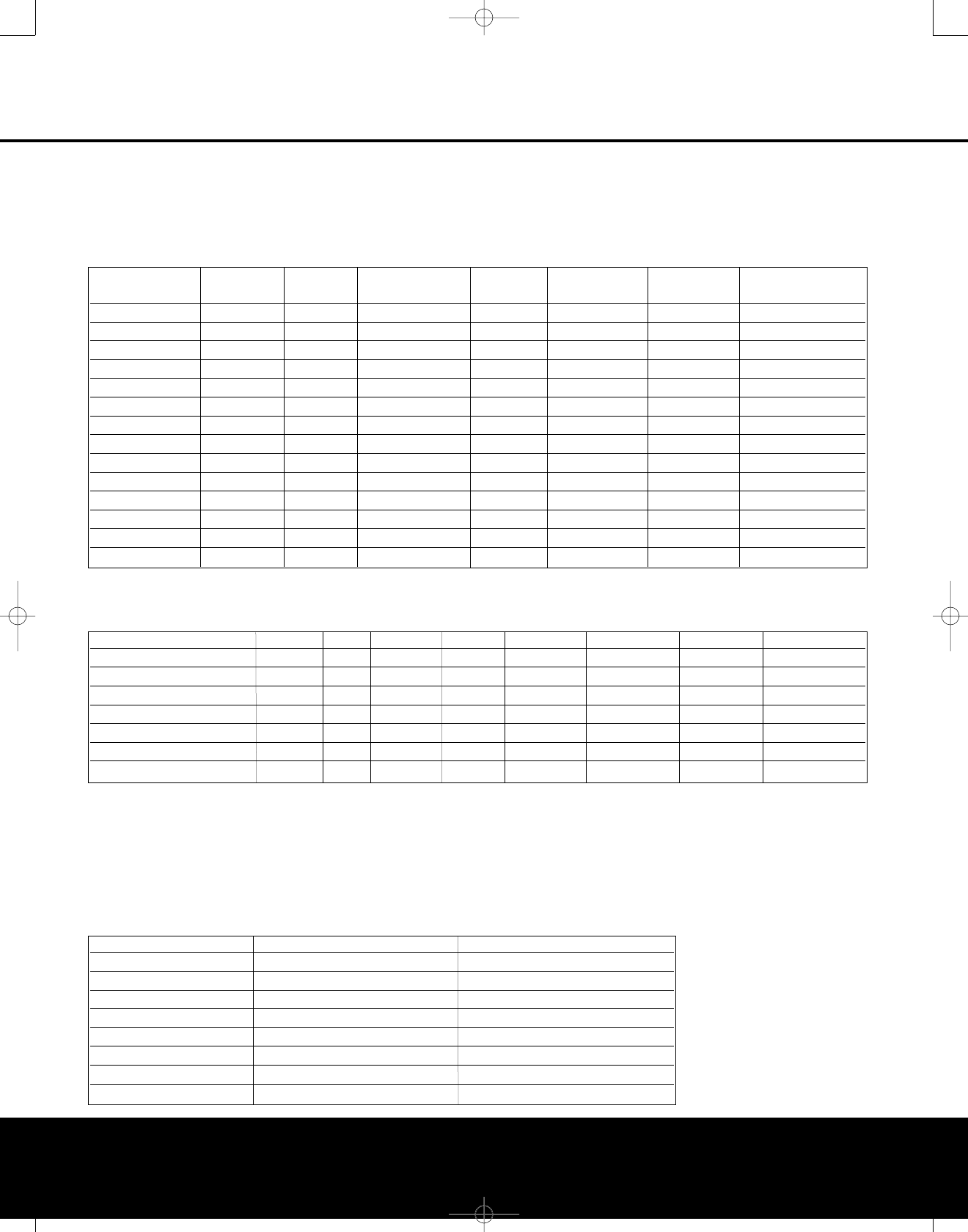
APPENDIX
SYSTEM DEFAULTS
The two tables in this section show the factory default settings for the Video Inputs and Video Sources. These tables give you a picture of the AVR 745’s initial settings. You may
then decide whether any item needs to be changed so that it is more appropriate for your specific installation. Any of the settings shown may be changed as shown in the
pages of the System Configuration section of this manual (pages 21–33).
TABLE 1: VIDEO INPUT DEFAULTS
INPUT AUDIO VIDEO COMPONENT TRIGGER 2 RECORD AUTO-POLL INPUT
INPUT INPUT VIDEO INPUT SETTING OUTPUT SOURCE TYPE
Video 1 ANALOG AUTO COMPONENT 1 ON ANALOG ON VCR
Video 2 ANALOG AUTO COMPONENT 2 ON ANALOG OFF CABLE DIGITAL
Video 3 OPTICAL 1 AUTO COMPONENT 1 ON ANALOG ON CABLE ANALOG
Video 4 OPTICAL 4 AUTO COMPONENT 2 ON ANALOG ON SATELLITE DIGITAL
DVD COAX 1 AUTO COMPONENT 3 ON ANALOG OFF DVD
HDMI 1 HDMI 1 HDMI 1 --- ON DSP DOWNMIX OFF *
HDMI 2 HDMI 2 HDMI 2 --- ON DSP DOWNMIX OFF *
Tuner ANALOG AUTO COMPONENT 1 ON ANALOG --- *
XM --- HDMI 1 COMPONENT 1 ON ANALOG --- *
CD ANALOG AUTO COMPONENT 3 ON ANALOG OFF *
Tape ANALOG AUTO COMPONENT 1 ON ANALOG OFF *
DMP/The Bridge ANALOG HDMI 1 COMPONENT 1 ON ANALOG --- *
6/8 CH Direct ANALOG HDMI 1 COMPONENT 1 ON ANALOG --- *
USB --- HDMI 1 COMPONENT 3 ON DSP DOWNMIX --- *
TABLE 2: VIDEO SOURCE DEFAULTS
FEATURE DVD VCR CABLE DIG SAT DIG SAT ANALOG CABLE ANALOG CAMERA DIG CAMERA ANALOG
Noise Reduction OFF ON OFF OFF ON ON OFF ON
X-Color Suppressor ON ON ON ON ON ON ON ON
DCDi Interpolation ON ON ON ON ON ON ON ON
Film Mode Detect ON ON ON ON ON ON ON ON
Film Mode Edit Detect ON ON ON ON ON ON ON ON
Composite Video Enhancement ON ON ON ON ON ON ON ON
VCR Sync Time Enhancement ON ON ON ON ON ON ON ON
System Default and Personal Settings Worksheets
The worksheets in this section show the system defaults for the global settings on your AVR 745. Once your system is configured manually, or through the use of EzSet/EQ II,
where applicable, we recommend that you use the “Your System Settings” column to record your personal preferences so that they may be restored in the event the AVR’s
memory is lost due to an extended power outage,system upgrade, processor reset, or other major service to your unit. Additional copies of this worksheet may be downloaded
from the Harman Kardon web site at www.harmankardon.com
Worksheet A: Video Monitor and Aspect Ratio Defaults and Settings
Feautre/Display Type System Default Your System Setting
Display Interface Analog
HDMI Audio Out Off
CRT 4:3
Front Projection 4:3
Rear Projection 4:3
Plasma (PDP) 16:9
DLP™ 16:9
LCD 16:9
APPENDIX 55
*: User should change setting to match input type.
AVR 745 OM 5/15/06 5:00 PM Page 55

APPENDIX
56 APPENDIX
Worksheet B: Surround Configuration Defaults and Settings
Feature System Default Your System Settings
Logic 7 Global On
Default Surround Original
Dolby Pro Logic II Music Center Width 3
Dolby Pro Logic II Music Dimension 0
Dolby Pro Logic II Panorama Off
Dolby Pro Logic IIx Music Center Width 3
Dolby Pro Logic IIx Music Dimension 0
Dolby Pro Logic IIx Panorama Off
Night Mode Off
Worksheet C: Delay Defaults and Setting
Feature System Default Your System Settings
Front Left 12.0 Feet
Center 12.0 Feet
Front Right 12.0 Feet
Surround Right 12.0 Feet
Surround Back Right 12.0 Feet
Surround Back Left 12.0 Feet
Surround Left 12.0 Feet
Subwoofers 12.0 Feet
Worksheet D: System Defaults and Settings
Feature System Default Your System Settings
Front L/R Speaker Size & X-Over Small – 100 Hz
Center Speaker Size & X-Over Small – 100 Hz
Surround L/R Speaker Size & X-Over Small – 100 Hz
Surround Back Speaker Size & X-Over None
LFE LP Filter 100 Hz
Sub Mode Sub L/R+LFE
Number of Subs 1
Channel Adjust Global
Sub Size 10 in/250 mm
VFD Fade Time Out Off
VFD Brightness Full
Volume Default Off
Volume Default Set -25dB
Semi OSD Time Out 5 Sec
Full OSD Time Out 20 Sec
DMP Auto Power Off
HDMI Video Auto On
Surround Back Amps Main
Carrier Out Zone II
AVR 745 OM 5/15/06 5:00 PM Page 56
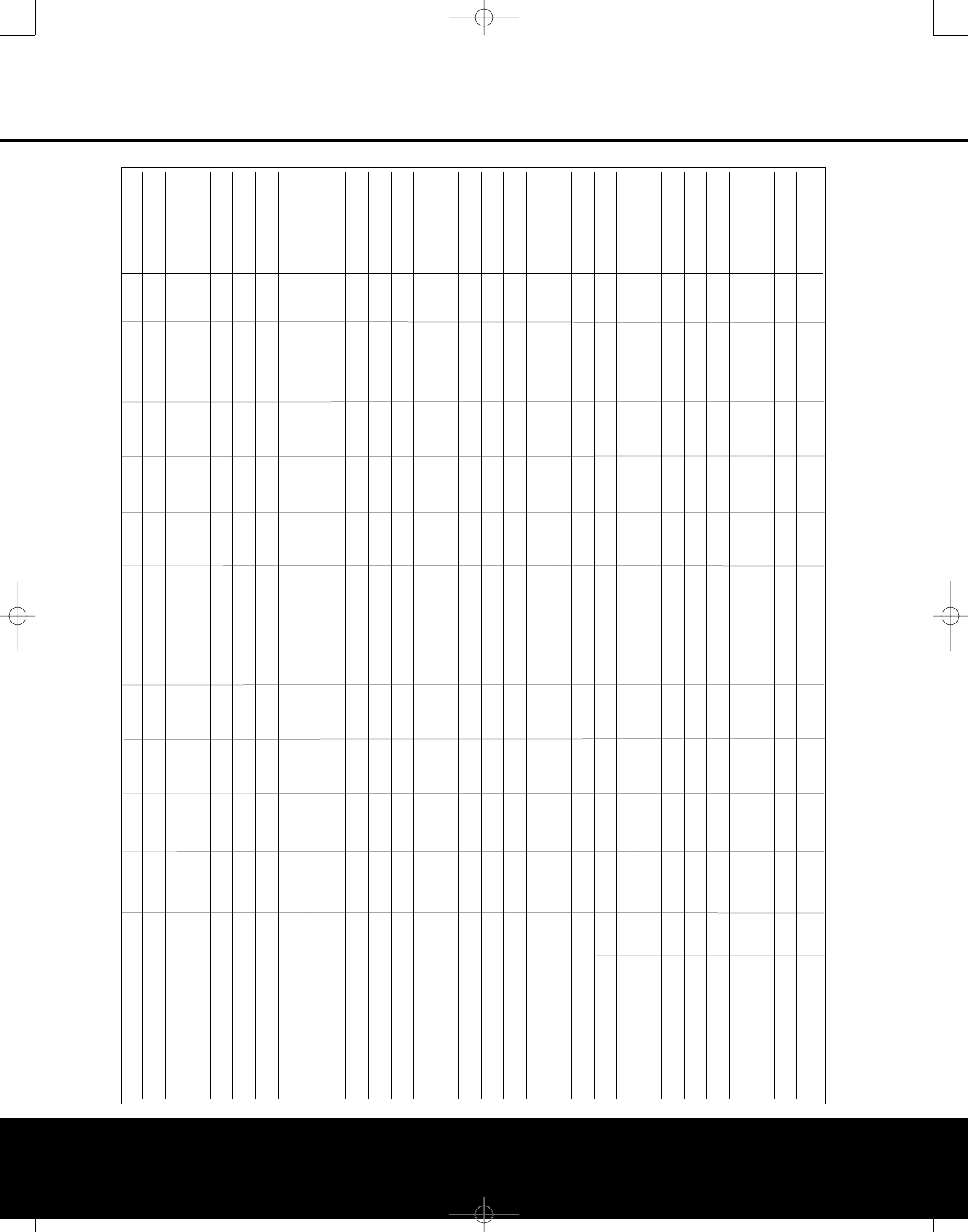
APPENDIX
FEATURE DVD Video 1 Video 2 Video 3 Video 4 HDMI 1HDMI 2CD Tape Tuner The Bridge USB 6/8 Ch Direct
Input Title
Surround Mode
Audio In Port
Audio Auto Poll
Video In Port
Component Video Input
Video Processing
A/V Sync Delay
Trigger 2
Record Output
Auto Poll
Input Source Type
Display Type
Video Input Port
Enhance Level
Input Aspect Ratio
Noise Reduction
X-Color Supressor
DCDi Interpolation
Film Mode Edit Detect
Fleshtone Noise Reduction
Composite Video Enhancement
Output Aspect Ratio
Brightness
Contrast
Saturation
ADC Sampling
Tone In/Out
Bass
Treble
WORKSHEET E: INPUT SETTINGS
APPENDIX 57
APPENDIX
APPENDIX 57
AVR 745 OM 5/15/06 5:00 PM Page 57

AVR 745 TECHNICAL SPECIFICATIONS
58 TECHNICAL SPECIFICATIONS
Audio Section
Stereo Mode
Continuous Average Power (FTC)
100 Watts per channel, 20Hz–20kHz,
@ <0.07% THD, both channels driven into 8 ohms
Seven-Channel Surround Modes
Power per Individual Channel
Front L&R channels:
85 Watts per channel
@ <0.07% THD, 20Hz–20kHz into 8 ohms
Center channel:
85 Watts @ <0.07% THD, 20Hz–20kHz into 8 ohms
Surround (L & R Side, L & R back) channels:
85 Watts per channel
@ <0.07% THD, 20Hz–20kHz into 8 ohms
Input Sensitivity/Impedance
Linear (High-Level) 200mV/47k ohms
Signal-to-Noise Ratio (IHF-A) 100dB
Surround System Adjacent Channel Separation
Pro Logic I/II 40dB
Dolby Digital (AC-3) 55dB
DTS 55dB
Frequency Response
@ 1W (+0dB, –3dB) 10Hz –130kHz
High Instantaneous
Current Capability (HCC) ±60 Amps
Transient Intermodulation
Distortion (TIM) Unmeasurable
Slew Rate 40V/µsec
FM Tuner Section
Frequency Range 87.5–108.0MHz
Usable Sensitivity IHF 1.3µV/13.2dBf
Signal-to-Noise Ratio Mono/Stereo 70/68dB
Distortion Mono/Stereo 0.2/0.3%
Stereo Separation 40dB @ 1kHz
Selectivity ±400kHz, 70dB
Image Rejection 80dB
IF Rejection 90dB
AM Tuner Section
Frequency Range 520–1720kHz
Signal-to-Noise Ratio 45dB
Usable Sensitivity Loop 500µV
Distortion 1kHz, 50% Mod 0.8%
Selectivity ±10kHz, 30dB
Video Section
Television Format NTSC
Input Level/Impedance 1V p-p/75 ohms
Output Level/Impedance 1V p-p/75 ohms
Video Frequency Response
(Composite and S-Video) 10Hz–8MHz (–3dB)
Video Frequency Response
(Component Video) 10Hz–100MHz (–3dB)
HDMI Version 1.1
General
Power Requirement AC 120V/60Hz
Power Consumption 120W at Power On, idle; 1,405W at rated power output
(7 channels driven)
Dimensions Product Shipping
Width 17-5/16 inches (440mm) 20-1/16 inches (510mm)
Height 6-1/2 inches (165mm) 10 inches (254mm)
Depth 17-1/16 inches (435mm) 22-3/16 inches (565mm)
Weight 44 lb (19.9kg) 51 lb (23.1kg)
Depth measurement includes knobs, buttons and terminal connections.
Height measurement includes feet and chassis.
All features and specifications are subject to change without notice.
Harman Kardon, Harman International and Logic 7 are registered trademarks of
Harman International Industries, Incorporated.
and are trademarks of Harman International Industries, Incorporated.
Dolby, Pro Logic and the Double-D symbol are registered trademarks of Dolby Laboratories.
Manufactured under license from Dolby Laboratories.
DTS, DTS Surround, DTS-ES, DTS 96/24 and DTS Neo:6 are registered trademarks of DTS, Inc.
A-BUS and A-BUS/READY are registered trademarks of Leisure Tech Electronics Pty Ltd Australia.
SACD is a trademark of Sony Corporation.
iPod is a registered trademark of Apple Computer, Inc.
DLP and Texas Instruments are trademarks of Texas Instruments.
Faroudja and DCDi by Faroudja are trademarks of Genesis Microchip, Inc.
HD-DVD is a trademark of the DVD Format/Logo Licensing Corporation (DVD FLLC).
HDMI,the HDMI logo and High-Definition Multimedia Interface are trademarks or registered trademarks
of HDMI Licensing,LLC.
Microsoft, Windows and Windows Media are registered trademarks of Microsoft Corporation in
the United States and other countries.
XM-Ready is a registered trademark of XM Satellite Radio,Inc.
The
Bridge
TM
Supplied Accessories
The AVR 745 is supplied with the following accessory items. Please note that they are packed in different boxes, so it is important to check each individual box before reporting
missing items. If any item is missing, please contact Harman Kardon customer service at www.harmankardon.com.
• TC 30 remote control • TC 30 software CD-ROM • microphone
• Battery for the TC 30 • TC 30 installation guide • Extender rod for microphone
• USB cable for the TC 30 • ZR 10 remote control • AM loop antenna
• TC 30 charging cradle • Two AAA batteries for ZR 10 • FM wire antenna
• Charger for the TC 30 • AC power cord
Please register your product on our Web site at www.harmankardon.com. NOTE: You’ll need the serial number of your AVR. At the same time, you can choose
to be notified about our new products and/or special promotions.
AVR 745 OM 5/15/06 5:00 PM Page 58

NOTES
NOTES 59
AVR 745 OM 5/15/06 5:00 PM Page 59

®
250 Crossways Park Drive, Woodbury, New York 11797
www.harmankardon.com
© 2006 Harman International Industries, Incorporated. All rights reserved.
Part No.ZKD2701HA00-R
AVR 745 OM 5/15/06 5:00 PM Page 60